
La Côte d’Azur: Nice • Villefranche-sur-Mer • Along the Three Corniches • Monaco • Antibes • Inland Riviera
Map: Public Transportation on the French Riviera
Map: Vieux Nice Hotels & Restaurants
Orientation to Villefranche-sur-Mer
Villefranche-sur-Mer Town Walk
Activities in Villefranche-sur-Mer
Sleeping in Villefranche-sur-Mer
Eating in Villefranche-sur-Mer
Villefranche-sur-Mer Connections
Orientation to St-Paul-de-Vence
A hundred years ago, celebrities from London to Moscow flocked to the French Riviera to socialize, gamble, and escape the dreary weather at home. Today, budget vacationers and heat-seeking Europeans fill belle époque resorts at France’s most sought-after fun-in-the-sun destination.
Some of the Continent’s most stunning scenery and intriguing museums lie along this strip of land—as do millions of sun-worshipping tourists. Nice has world-class museums, a splendid beachfront promenade, a seductive old town, and all the drawbacks of a major city (traffic, crime, pollution, and so on). The day-trip possibilities are easy and exciting: Fifteen minutes east of Nice, little Villefranche-sur-Mer stares across the bay to woodsy and exclusive Cap Ferrat; the eagle’s-nest Eze-le-Village surveys the scene from high above; Monaco offers a royal welcome and a fairy-tale past; Antibes has a thriving port and silky sand beaches; and the inland hill towns present a rocky and photogenic alternative to the beach scene. Evenings on the Riviera, a.k.a. la Côte d’Azur, were made for a promenade and outdoor dining.
My favorite home bases are Nice, Antibes, and Villefranche-sur-Mer.
Nice is the region’s capital and France’s fifth-largest city. With convenient train and bus connections to most regional sights, this is the most practical base for train travelers. Urban Nice also has museums, a beach scene that rocks, the best selection of hotels in all price ranges, and good nightlife options. A car is a headache in Nice.
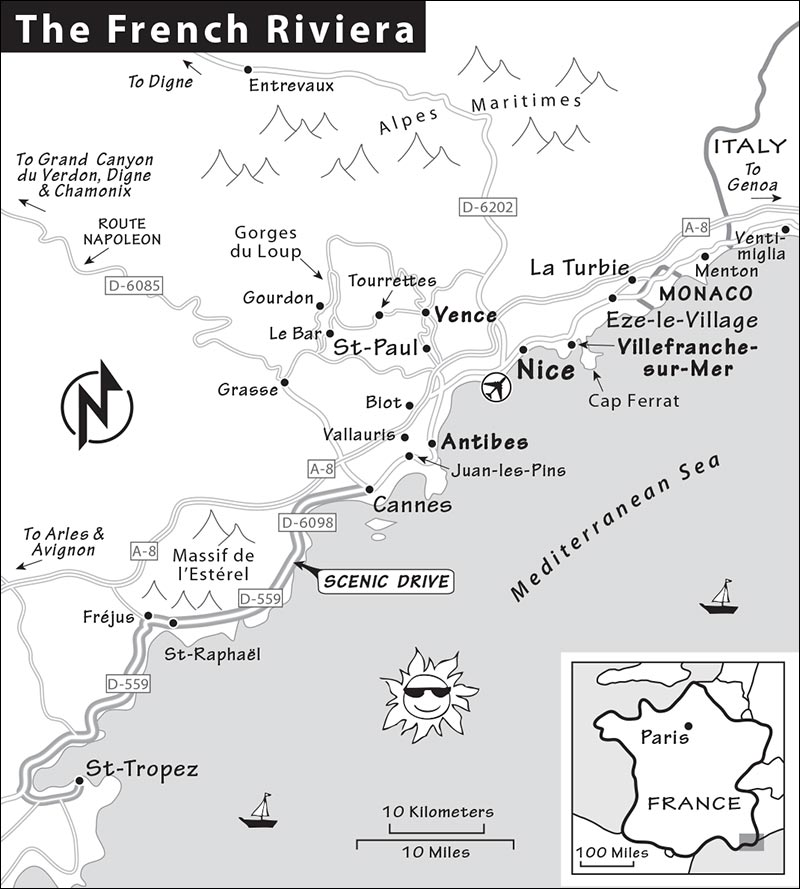
Nearby Antibes is smaller, with a bustling center, a lively night scene, great sandy beaches, grand vistas, good walking trails, and a stellar Picasso museum. Antibes has frequent train service to Nice and Monaco. It’s the most convenient overnight stop for drivers, with light traffic and easy hotel parking.
Villefranche-sur-Mer is the romantic’s choice, with a serene setting and small-town warmth. It has sand-pebble beaches; quick public transportation to Nice, Monaco, and Cap Ferrat; and a small selection of hotels and good restaurants in most price ranges.
Ideally, allow a full day for Nice, a day for Monaco and the Corniche route that connects it with Nice, and a half-day for Antibes, Villefranche-sur-Mer, or Cap Ferrat (or better, a full day combining Villefranche and Cap Ferrat). Monaco and Villefranche-sur-Mer are radiant at night, and Antibes is enjoyable by day (good beaches and hiking) and night (fine choice of restaurants and a lively after-hours scene). Hill-town-loving travelers should add a day to explore the charming villages of St-Paul-de-Vence and Vence.
Medical Help: Riviera Medical Services has a list of English-speaking physicians all along the Riviera. They can help you make an appointment or call an ambulance (tel. 04 93 26 12 70, www.rivieramedical.com).
Sightseeing Tips: Mondays and Tuesdays can frustrate market lovers and museumgoers. Closed on Monday: Nice’s Modern and Contemporary Art Museum, Fine Arts Museum, and Cours Saleya produce and flower market; Antibes’ Picasso Museum and market hall (Sept-May). Closed on Tuesday: Chagall, Matisse, Masséna, and Archaeological museums in Nice. Matisse’s Chapel of the Rosary in Vence is closed Sunday and Monday and in the morning on Wednesday and Saturday.
The French Riviera Pass includes entry to many Riviera sights and activities, including Nice’s Chagall Museum, Monaco’s Oceanography Museum, and Villa Ephrussi de Rothschild on Cap Ferrat (€26/24 hours, €38/48 hours, €56/72 hours, tel. 04 92 14 46 14, http://en.frenchrivierapass.com). This pass is worthwhile if you have an aggressive sightseeing plan or want to do some bigger-ticket items like the included hop-on, hop-off Le Grand Tour Bus in Nice or the Trans Côte d’Azur cruise (see “Tours in Nice,” later).
A €10 combo-ticket for Nice covers all of the city’s museums, except the Chagall Museum.
Events: The Riviera is famous for staging major events. Unless you’re actually taking part in the festivities, these occasions give you only room shortages and traffic jams. Here are the three biggies: Nice Carnival (two weeks in Feb, www.nicecarnaval.com), Cannes Film Festival (12 days in mid-May, www.festival-cannes.com), and the Grand Prix of Monaco (4 days in late May, www.acm.mc). To accommodate the busy schedules of the rich and famous (and really mess up a lot of normal people), the film festival and car race often overlap.
Connecting to the Alps: If driving from the Riviera north to the Alps region (see next chapter), consider taking La Route Napoléon. After getting bored in his toy Elba empire, Napoléon gathered his entourage, landed on the Riviera, bared his breast, and told his fellow Frenchmen, “Strike me down or follow me.” France followed. But just in case, he took the high road, returning to Paris along the route known today as La Route Napoléon. (Waterloo followed shortly afterward.) The route is beautiful (from south to north, follow signs: Digne, Sisteron, and Grenoble). Little Entrevaux is worth a quick leg-stretch. Climb high to the citadel for great views and appreciate the unspoiled character of the town. An assortment of pleasant villages with inexpensive hotels lies along this route, making an overnight easy.
Trains and buses do a good job of connecting places along the coast, with bonus views along many routes. Buses also provide reasonable service to some inland hill towns. Nice makes the most convenient base for day trips, though public transport also works well from Riviera towns such as Antibes and Villefranche-sur-Mer. Driving can be challenging in this congested region (traffic, parking, etc.).
In the Riviera, buses are often less expensive and more convenient while trains are faster and more expensive. For an overview of the most useful train and bus connections, see the “Public Transportation in the French Riviera” chart (confirm all connections and last train/bus times locally). You’ll also find details under each destination’s “Connections” section. For a scenic inland train ride, take the narrow-gauge train into the Alps (see here).
If taking the train or bus, have coins handy. Ticket machines don’t take euro bills, some US credit cards may not work, smaller train stations may be unstaffed, and bus drivers can’t make change for large bills.
Buses: Most of the area’s top destinations are connected by bus, and tickets are cheap. This is an amazing deal in the Riviera. Any one-way bus or tram ticket costs €1.50 (€10 for 10 tickets) whether you’re riding just within Nice or to Villefranche-sur-Mer, Monaco, or Antibes. This ticket is good for 74 minutes of travel in one direction anywhere within the bus system (but does not cover airport buses). Outside of the Inland Riviera, you can buy a single bus ticket from the driver or from machines at stops, and validate it in the machine on board (10-ride or all-day tickets must be purchased at machines or at Lignes d’Azur offices). At Inland Riviera destinations such as Vence and St.-Paul-de-Vence, buy bus tickets at a tabac. Your ticket allows transfers between the buses of the Lignes d’Azur (the region’s main bus company, www.lignesdazur.com) and the TAM (Transports Alpes-Maritimes); if you board a TAM bus and need a transfer, ask for un ticket correspondance. A €5 all-day ticket is good on Nice’s city buses, tramway, and selected buses serving nearby destinations (such as Villefranche, Cap Ferrat, and Eze-le-Village). The general rule of thumb: If the bus number has one or two digits, it’s covered with the all-day ticket; with three digits, it’s not.

You’ll be able to get around most of the Riviera on the following major bus routes:
• Bus #100 runs eastbound from Nice along the Low Corniche (3-4/hour) stopping in Villefranche-sur-Mer (20 minutes), Beaulieu-sur-Mer (Villa Kérylos; 30 minutes), Eze-Bord-de-Mer (40 minutes, transfer to #83 to Eze-le-Village), Monaco (1 hour), and Menton (1.5 hours).
• Bus #81 runs eastbound from Nice (2-3/hour) to Villefranche-sur-Mer (15 minutes), Beaulieu-sur-Mer (Villa Kérylos; 20 minutes), and all Cap Ferrat stops, ending at St-Jean-Cap-Ferrat (30 minutes).
• Buses #82 and #112 run from Nice and upper Villefranche-sur-Mer to Eze-le-Village (together they depart about hourly; only #82 runs on Sunday; 30 minutes to reach Eze from Nice). Bus #112, which runs along the scenic Middle Corniche, continues from Eze-le-Village to Monte Carlo in Monaco (6/day, none on Sun, 20 minutes).
• Bus #200 goes from Nice westbound (4/hour Mon-Sat, 2/hour Sun) to Cagnes-sur-Mer (1 hour), Biot (1.25 hours), Antibes (1.5 hours), and Cannes (2 hours).
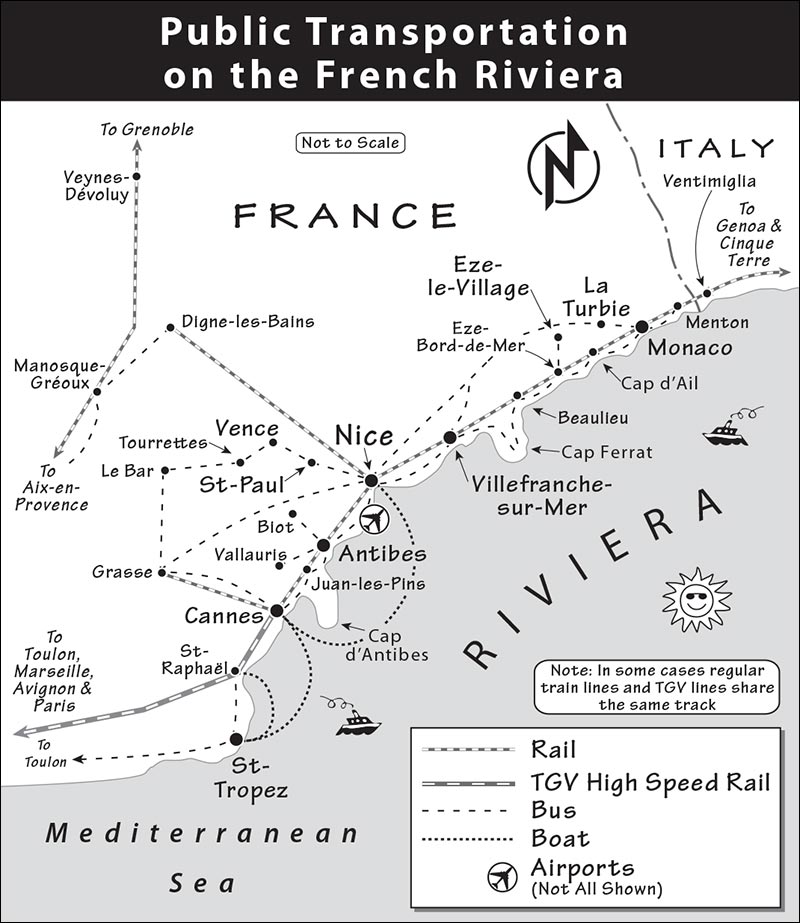
• For the inland towns, bus #400 runs from Nice (2/hour) to St-Paul-de-Vence (45 minutes) and Vence (50 minutes).
Trains: These are more expensive but much faster than the bus (Nice to Monaco by train is about €4), and there’s no quicker way to move about the Riviera (http://en.voyages-sncf.com). Speedy trains link the Riviera’s beachfront destinations. (Never board a train without a ticket or valid pass—fare inspectors accept no excuses. The minimum fine: €70.)
This is France’s most challenging region to drive in. Beautifully distracting vistas (natural and human), loads of Sunday-driver tourists, and every hour being lush-hour in the summer make for a dangerous combination. Parking can be exasperating. Bring lots of coins and patience.
The Riviera is awash with scenic roads. To sample some of the Riviera’s best scenery, connect Provence and the Riviera by driving the splendid coastal road between Cannes and Fréjus (D-6098 from Cannes/D-559 from Fréjus). Once in the Riviera, the most scenic and thrilling road trip is along the three coastal roads—called “corniches”—between Nice and Monaco (see “Along the Three Corniches,” later).
Trans Côte d’Azur offers seasonal boat service from Nice to Monaco (tel. 04 92 98 71 30, www.trans-cote-azur.com). For details, see the “By Boat” section under “Nice Connections,” later.
Most hotels and TIs have information on economical shared minivan excursions from Nice (per person: roughly €50-70/half-day, €80-120/day).
These two energetic and delightful women adore educating people about this area’s culture and history, and have comfortable minibuses: Sylvie Di Cristo (€600/day, €350/half-day for up to 8 people, mobile 06 09 88 83 83, http://frenchrivieraguides.com, dicristosylvie@gmail.com) and Ingrid Schmucker (€490/day for 2 people, €530/day for 3-4 people, €580 for 5-6, €200/half-day to explore old Nice on foot, mobile 06 14 83 03 33, https://kultours.fr, kultours06@gmail.com). Their websites explain their programs well, and they are happy to adapt to your interests.
Charming Fouad Zarrou runs France Azur Excursions and offers a fun experience. His tours are more about exploring the region’s natural beauty, food, and wine than its cultural history. He provides comfortable transportation in his minivan (figure €300/half-day, mobile 06 20 68 10 70, http://franceazurexcursions.com, contact@franceazurexcursions.com).
For a guided tour of Nice or the region using public transit or with a guide joining you in your rental car, consider Pascale Rucker, an art-loving guide with 25 years of experience who teaches with the joy and wonder of a flower child (€160/half-day, €260/day, mobile 06 16 24 29 52, pascalerucker@gmail.com). Boba Vukadinovic-Millet is an effective teacher, ideal for those wanting to dive more deeply into the region’s history and art. She can arrange chauffeur-driven rental options (car, minivan, minibus, bus) for you if needed (from €250/half-day, from €350/day, mobile 06 27 45 68 39, www.yourguideboba.com, boba@yourguideboba.com).
For food and wine walking tours and cooking classes offered in Nice, see “Tours in Nice,” later.
The list of artists who have painted the Riviera reads like a Who’s Who of 20th-century art. Pierre-Auguste Renoir, Henri Matisse, Marc Chagall, Georges Braque, Raoul Dufy, Fernand Léger, and Pablo Picasso all lived and worked here—and raved about the region’s wonderful light. Their simple, semi-abstract, and—most importantly—colorful works reflect the pleasurable atmosphere of the Riviera. You’ll experience the same landscapes they painted in this bright, sun-drenched region, punctuated with views of the “azure sea.” Try to imagine the Riviera with a fraction of the people and development you see today.
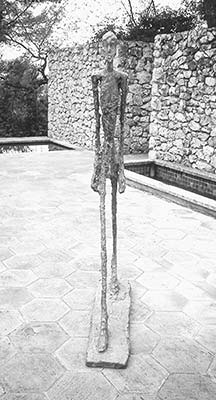
But the artists were mostly drawn to the uncomplicated lifestyle of fishermen and farmers that has reigned here since time began. As the artists grew older, they retired in the sun, turned their backs on modern art’s “isms,” and painted with the wide-eyed wonder of children, using bright primary colors, basic outlines, and simple subjects.
A collection of modern- and contemporary-art museums dot the Riviera, allowing art lovers to appreciate these masters’ works while immersed in the same sun and culture that inspired them. Many of the museums were designed to blend pieces with the surrounding views, gardens, and fountains, thus highlighting that modern art is not only stimulating, but sometimes simply beautiful.
The Riviera adds an Italian-Mediterranean flair to the food of Provence. While many of the same dishes served in Provence are available in the Riviera (see “Provence’s Cuisine Scene” on here), there are differences, especially if you look for anything Italian or from the sea. When dining on the Riviera, I expect views and ambience more than top-quality cuisine.
A fresh and colorful salade niçoise makes the perfect introduction to the Riviera’s cuisine. Surprisingly, the authentic version contains no potatoes or green beans but consists of ripe tomatoes, plenty of raw vegetables (such as radishes, green peppers, celery, and perhaps artichoke or fava beans), as well as tuna (usually canned), anchovy, hard-boiled egg, and olives. This is my go-to salad for a tasty, healthy, cheap (€14), and fast lunch. I like to spend a couple of extra euros and eat it in a place with a nice ambience and view.
For lunch on the go, look for a pan bagnat (like a salade niçoise stuffed into a crusty roll drizzled with olive oil and wine vinegar). Other tasty bread treats include pissaladière (bread dough topped with caramelized onions, olives, and anchovies), fougasse (a spindly, lace-like bread sometimes flavored with nuts, herbs, olives, or ham), and socca (a thin chickpea-and-olive-oil crêpe, seasoned with pepper and often served in a paper cone by street vendors).
The Riviera specializes in all sorts of fish and shellfish. Bouillabaisse is the Riviera’s most famous dish; you’ll find it in seafront villages and cities. It’s a spicy fish stew based on recipes handed down from sailors in Marseille. This dish often requires a minimum order of two and can cost up to €40-60 per person. Far less pricey than bouillabaisse and worth trying is the local soupe de poissons (fish soup). It’s a creamy soup flavored like bouillabaisse, with anise and orange, and served with croutons and rouille sauce (but has no chunks of fish).
Other fishy options include fruits de mer (platters of seafood—including tiny shellfish, from which you get the edible part only by sucking really hard), herb-infused mussels, stuffed sardines, squid (slowly simmered with tomatoes and herbs), and tuna (thon). The popular loup flambé au fenouil is grilled sea bass, flavored with fennel and torched with pastis prior to serving.
For details on dining in France’s restaurants, cafés, and brasseries, getting takeout, and assembling a picnic—as well as a rundown of French cuisine—see the “Eating” section in the Practicalities chapter.
Wines of the Riviera: Do as everyone else does: Drink wines from Provence. Bandol (red) and cassis (white) are popular and from a region nearly on the Riviera. The only wines made in the Riviera are Bellet rosé and white, the latter often found in fish-shaped bottles.
Nice (sounds like “niece”), with its spectacular Alps-meets-Mediterranean surroundings, is the big-city highlight of the Riviera. Its traffic-free Vieux Nice—the old town—blends Italian and French flavors to create a spicy Mediterranean dressing, while its big squares, broad seaside walkways, and long beaches invite lounging and people-watching. Nice may be nice, but it’s jammed in May, July, and August—reserve ahead and get a room with air-conditioning. Nice gets quiet and mild in April and October. Everything you’ll want to see in Nice is either within walking distance, or a short bike, bus, or tram ride away.
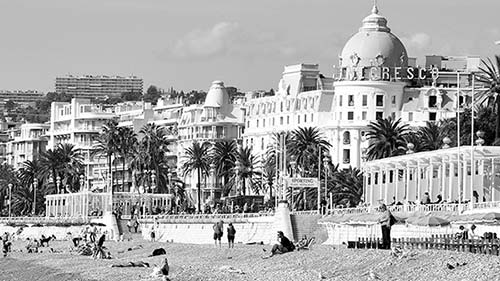
Focus your time on the area between the beach and the train tracks (about 15 blocks apart). The city revolves around its grand Place Masséna, where pedestrian-friendly Avenue Jean Médecin meets Vieux Nice and the Promenade du Paillon parkway (with quick access to the beaches). It’s a 20-minute walk (or about €15 by taxi) from the train station to the beach, and a 20-minute stroll along the promenade from the fancy Hôtel Negresco to the heart of Vieux Nice.
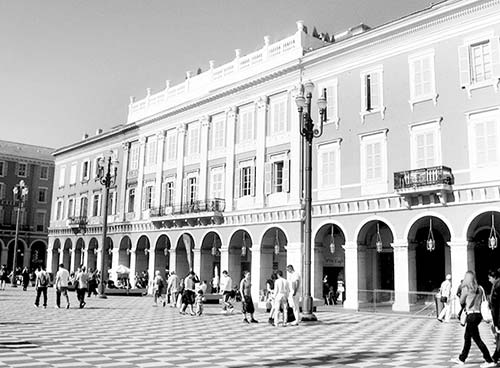
A 10-minute ride on the smooth tram through the center of the city connects the train station, Place Masséna, Vieux Nice, and Place Garibaldi. A new, mostly underground tram line paralleling the Promenade des Anglais and running from the port to the airport may be in operation by the time you visit.
Nice has three helpful TIs (tel. 08 92 70 74 07, www.nicetourisme.com), including the main branches at the train station and at #5 Promenade des Anglais (both daily 9:00-18:00, July-Aug until 19:00), and by the fountains near Place Masséna, called “Pavillon” (May-mid-Sept only, daily 10:00-20:00). Ask for day-trip information (including maps of Monaco, Antibes, and Cannes) and details on boat excursions, bus stop locations, and schedules.

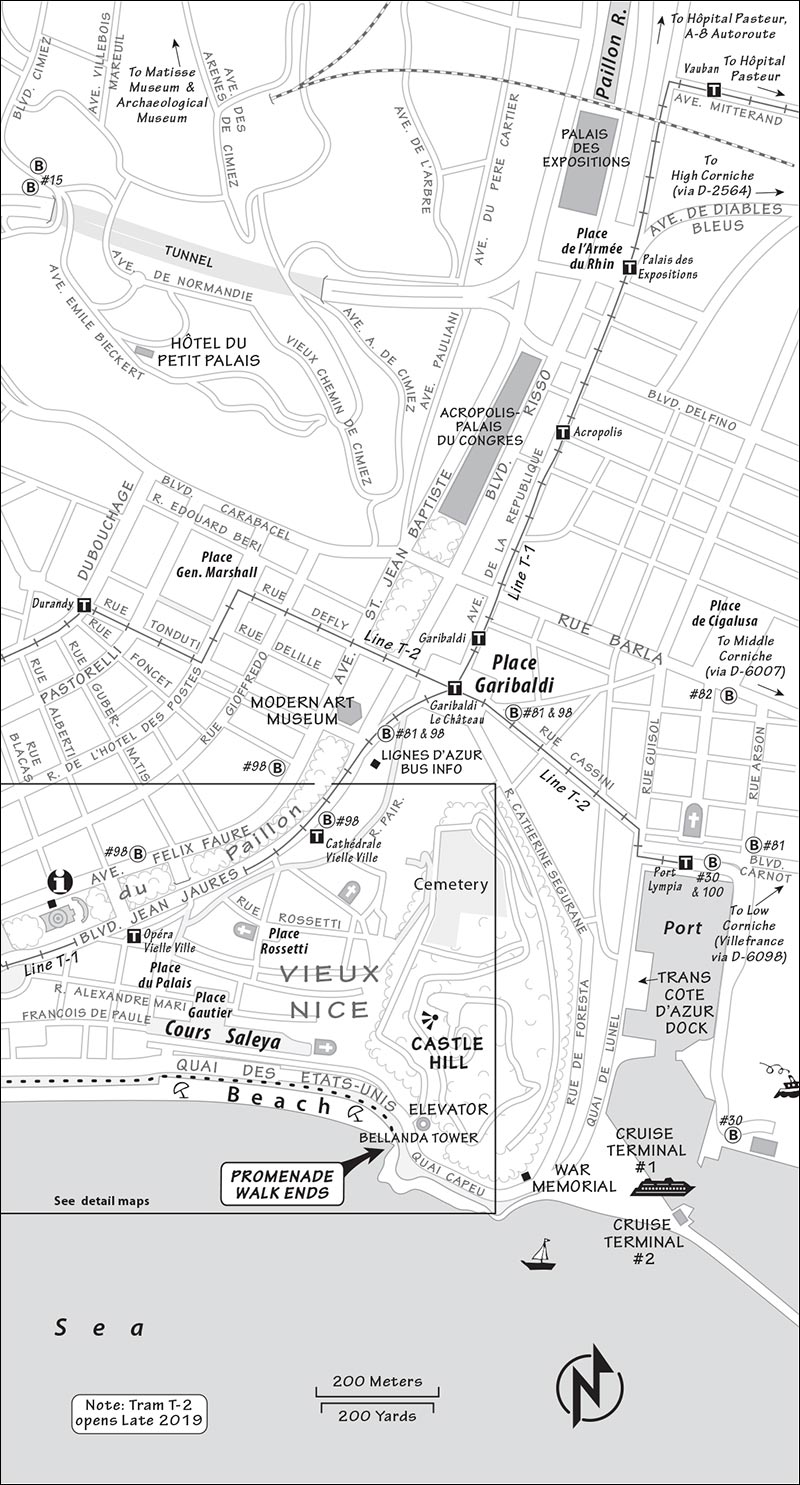

By Train: All trains stop at Nice’s main station, called Nice-Ville. With your back to the tracks, car rentals are to the right. Bag storage is to the left inside the station; you can also stash your bags a short block away at the recommended Hôtel Belle Meunière. The TI and bus stops (including #99 to the airport) are straight out the main doors.
A nearby tram line zips you to the center in a few minutes (several blocks to the left as you leave the station, departs every few minutes, direction: Hôpital Pasteur; see “Getting Around Nice,” later. To walk to the beach, Promenade des Anglais, or many of my recommended hotels, cross Avenue Thiers in front of the station, go down the steps by Hôtel Interlaken, and continue down Avenue Durante.
By Bus: For arrival by bus, see “Nice Connections,” at the end of this section. The region’s primary bus company, Lignes d’Azur, has an information office across from the train station (see “Helpful Hints,” next page).
By Car: To reach the city center from the autoroute, take the Nice Centre exit and follow signs. Ask you hoteliers where to park (allow €20-30/day; some hotels offer deals but space is limited—arrange ahead). The parking garage at the Nice Etoile shopping center on Avenue Jean Médecin is near many recommended hotels (ticket booth on third floor, about €28/day, 18:00-8:00). Other centrally located garages have similar rates. On-street parking is strictly metered (usually a 2-hour limit) every day but Sunday, when it is typically free.
You can avoid driving in the center—and park for free during the day (no overnight parking)—by stashing your car at a parking lot at a remote tram or bus stop. Look for blue-on-white Parcazur signs (find locations at www.lignesdazur.com), and ride the bus or tram into town (10/hour, 15 minutes, buy round-trip tram or bus ticket and keep it with you—you’ll need it later to exit the parking lot; for tram details, see “Getting Around Nice,” later). The easiest lot to use is Parcazur Henri Sappia, right off the Nice Nord autoroute exit. It always has room and saves you from navigating city streets (daily until 2:30 in the morning). As lots are not guarded, don’t leave anything of value in your car.
By Plane or Cruise Ship: See “Nice Connections.”
Theft Alert: Nice has its share of pickpockets (especially at the train station, on the tram, and trolling the beach). Stick to main streets in Vieux Nice after dark.
Sightseeing Tips: The Cours Saleya produce and flower market is closed Monday, and the Chagall and Matisse museums are closed Tuesday. All Nice museums—except the Chagall Museum—share the same €10 combo-ticket (valid 24 hours, €20/7 days, buy at any participating museum).
Baggage Storage: You can store your bags inside the train station (€5-10/bag per day), at the recommended Hôtel Belle Meunière (€5/bag per day), or at the Bagguys in Vieux Nice (€8/bag per day, daily 10:00-19:00, 22 Rue Centrale, info@bagguys.fr).
Grocery Store: Small grocery shops are easy to find. The big Monoprix on Avenue Jean Médecin and Rue Biscarra has it all (open daily, see map on here).
Boutique Shopping: The chic streets where Rue Alphonse Karr meets Rue de la Liberté and then Rue de Paradis are known as the “Golden Square.” If you need pricey stuff, shop here.
Renting a Bike (and Other Wheels): Bike-rental shops are a breeze to find in Nice, and several companies offer bike tours of the city. Bikes (vélos) can be taken on trains. Holiday Bikes has multiple locations, including one across from the train station, and they have electric bikes (www.loca-bike.fr). Roller Station is well-situated near the sea and rents bikes, rollerblades, skateboards, and Razor-style scooters (bikes-€5/hour, €10/half-day, €15/day, leave ID as deposit, open daily, 49 Quai des Etats-Unis—see map on here, tel. 04 93 62 99 05).
Car Rental: Renting a car is easiest at Nice’s airport, which has offices for all the major companies. Most companies are also represented at Nice’s train station and near the southwest side of Albert I Park.
Lignes d’Azur Bus Tickets: Useful information offices are at 17 Rue Thiers (kitty-corner from the train station, information only), at 1 Rue d’Italie (sells tickets and passes), and at 4 Boulevard Jean Jaurès (the main office where you can buy tickets and passes). Office hours vary (generally Mon-Fri 9:00-18:00 or 19:00, Sat until 15:00, closed Sun). Ask for their helpful “Passenger Guide” with information on buses to all Riviera destinations in English.
Views: For panoramic views, climb Castle Hill (see “Sights in Nice,” later) or take a one-hour boat trip (see “Tours in Nice,” later).
Beach Tips: To make life tolerable on the rocks, swimmers should buy a pair of the cheap plastic beach shoes sold at many shops. Go Sport at #13 on Place Masséna is a good bet (open daily, see map on here). Locals don’t swim in July and August, as the warming sea brings swarms of stinging jellyfish. Ask before you dip.
Although you can walk to most attractions, smart travelers make good use of the buses and trams within Nice. For information on getting around the Riviera from Nice, see “Nice Connections.”
Tickets: Buses and trams are covered by the same €1.50 single-ride ticket, or you can pay €10 for a 10-ride ticket that can be shared (each use good for 74 minutes in one direction, including transfers between bus and tram). The €5 all-day pass is valid on city buses and trams, as well as buses to some nearby destinations (but not airport buses). You must validate your ticket in the machine on every trip—imitate how the locals do it. Buy single tickets from the bus driver or from the ticket machines on tram platforms (coins only—press the green button once to validate choice and twice at the end to get your ticket). Passes and 10-ride tickets are also available from machines at tram stops and from two Lignes d’Azur offices (see “Helpful Hints,” earlier), but not from drivers. Info: www.lignesdazur.com.
Buses: The bus is handy for reaching the Chagall and Matisse museums and the Russian Cathedral (for specifics, see listings under “Sights in Nice”). Route diagrams in the buses identify each stop.
Trams: Nice has a modern and efficient L-shaped tram line (T-1) that runs to the train station and a new line (T-2) that should connect the city center to the airport in late 2019 (http://tramway.nice.fr). Trams to the train station run every few minutes along Avenue Jean Médecin and Boulevard Jean Jaurès, and connect the main train station with Place Masséna and Vieux Nice (Opéra stop), the port (Place Garibaldi stop), and buses east along the coast (Vauban stop). These trams also stop near the Chemins de Fer de Provence train station (Libération stop)—the departure point for the scenic narrow-gauge rail journey.
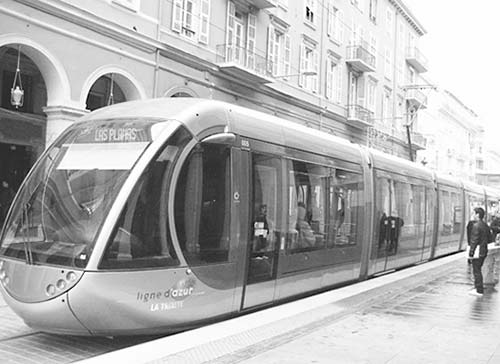
Boarding the tram in the direction of Hôpital Pasteur takes you toward the beach and Vieux Nice (direction: Henri Sappia goes the other way). The new T-2 tramway goes from the airport through the city center to Nice’s Port Lympia, paralleling the Promenade des Anglais a few blocks inland.
While pricey, cabs are useful for getting to Nice’s less-central sights (figure €8 for shortest ride, €15 from Promenade des Anglais to the Chagall Museum). Cabbies normally pick up only at taxi stands (tête de station), or you can call 04 93 13 78 78. Uber works here like it does at home (including your US app and account), though there are fewer cars here, and the price is not much cheaper than a taxi. Still, drivers are often nicer and more flexible, and you usually get a car without much delay.
Le Grand Tour Bus provides a useful 14-stop, hop-on, hop-off service on an open-deck bus with good headphone commentary. The route includes the Promenade des Anglais, the old port, Cap de Nice, and the Chagall and Matisse museums. From April to October, it also runs to Villefranche-sur-Mer (1-day pass-€23, 2-day pass-€26, buy tickets on bus, 2/hour, daily 10:00-19:00, 1.75-hour loop with Villefranche-sur-Mer, main stop near where Promenade des Anglais and Quai des Etats-Unis meet—across from the Albert I Park, tel. 04 92 29 17 00, www.nice.opentour.com). While it’s not the best way to get to the Chagall and Matisse museums, this bus is a good value if you’re looking for a city overview and want to also visit these museums or spend time in Villefranche-sur-Mer (best seats are up top on the left as you face forward).
For €10, you can spend 45 minutes on the tourist train tooting along the promenade, through the old city, and up to Castle Hill (2/hour, daily 10:00-18:00 or 19:00, recorded English commentary, meet train at the Monument du Centenaire statue at Albert I Park, across from the Promenade des Anglais, tel. 02 99 88 47 07).
Tina Balter at Lifesparkz Bike Tours offers well-designed, customized bike tours for individuals or small groups of all abilities (mobile 06 40 52 94 39, www.lifesparkz.net).
To see Nice from the water, hop this one-hour tour run by Trans Côte d’Azur. You’ll cruise in a comfortable yacht-size vessel to Cap Ferrat and past Villefranche-sur-Mer, then return to Nice with a final lap along Promenade des Anglais.
Guides enjoy pointing out mansions owned by famous people, including Elton John and Sean Connery (€18; covered by French Riviera Pass—see here; April-Oct Tue-Sun 2/day, usually at 11:00 and 15:00, no boats Mon or in off-season; verify schedule, arrive 30 minutes early to get best seats).
The boats leave from Nice’s port, Bassin des Amiraux, just below Castle Hill—look for the ticket booth (billeterie) on Quai de Lunel. The same company also runs boats to Monaco (see “Nice Connections”).
If interested in hiring a local guide for Nice and other regional destinations, see here for suggestions.
The TI on Promenade des Anglais organizes weekly walking tours of Vieux Nice in French and English (€12, Sat morning at 9:30, 2.5 hours, reservations necessary, departs from TI, tel. 08 92 70 74 07).
Charming Canadian Francophile Rosa Jackson, a food journalist, Cordon Bleu-trained cook, and longtime resident of France, runs a cooking school—Les Petits Farcis—and offers a good food-market tour in Vieux Nice for small groups (€80-120/person based on group size). She also teaches cooking classes that include a morning shopping trip to the market on Cours Saleya and an afternoon cooking session for €195/person, and a pastry course for €80/person (12 Rue Saint Joseph, mobile 06 81 67 41 22, www.petitsfarcis.com).
A Taste of Nice Food Tours runs daily scratch-and-taste tours in Vieux Nice that combine cultural history with today’s food scene. You’ll stop for 10 different tastings of classic Niçois products. Tours meet daily except Monday at 10:00 on Quai des Etats-Unis at the Opéra Plage (€70/4 hours, tel. 09 86 65 75 17, www.atasteofnice.com, booking@atasteofnice.com).
To get acquainted with Nice, combine the following two self-guided walks. “Promenade des Anglais” covers the sun-drenched seaside that made Nice famous, while “Vieux Nice” takes you through the historic old town of this engaging Franco-Italian city.
This leisurely, level self-guided walk, worth ▲▲▲, is a straight line along this much-strolled beachfront. It begins near the landmark Hôtel Negresco and ends just before Castle Hill. While this one-mile section is enjoyable at any time, the first half makes a great stroll before or after breakfast or dinner (meals served at some beach cafés). If extending this stroll to Castle Hill, it’s ideal to time things so you wind up on top of the hill at sunset. Allow one hour at a promenade pace to reach the elevator up to Castle Hill. To trace the route of this walk, see the “Nice” map, earlier.
• Start your walk at the pink-domed...
Built in 1913, Nice’s finest hotel is also a historic monument, offering up the city’s most expensive beds and a museum-like interior.
If you wonder why such a grand hotel has such an understated entry, it’s because today’s front door was originally the back door. In the 19th century, elegant people avoided the sun, and any posh hotel that cared about its clientele would design its entry on the shady north side. If you walk around to today’s “back” you’ll see a grand but unused front door.
The hotel is technically off-limits if you’re not a guest, but if you’re decently dressed and explain to the doorman that you’d like to get a drink at Negresco’s classy-cozy Le Relais bar, you’ll be allowed past the registration desk. You can also explain that you want to shop at their store, which also might get you in—bonne chance.
If you get in, you can’t miss the huge Salon Royal ballroom. The chandelier hanging from its dome is made of 16,000 pieces of crystal. It was built in France for the Russian czar’s Moscow palace...but thanks to the Bolshevik Revolution in 1917, he couldn’t take delivery. Bronze portrait busts of Czar Alexander III and his wife, Maria Feodorovna—who returned to her native Denmark after the revolution—are to the right, facing the shops. Circle the interior of the ballroom and admire the soft light from the glass dome that Gustave Eiffel designed two decades after his more famous tower in Paris, then wander the perimeter to enjoy both historic and modern art. Fine portraits include Emperor Napoleon III and wife Empress Eugénie (who acquired Nice for France from Italy in 1860).
• Across the street from the Hôtel Negresco (to the east) is...
When Nice became part of France, France invested heavily in what it expected to be the country’s new high society retreat—an elite resort akin to Russia’s Sochi. This fine palace was built for Jean-Andre Masséna, a military hero of the Napoleonic age. Take a moment to stroll around the lovely garden. Immediately on your right, find a memorial to the 86 people who died in the 2016 terrorist attack on the Promenade des Anglais, with pictures, stuffed animals, and names engraved in granite (garden is free, open daily 10:00-18:00). The Masséna Museum inside the villa (described later in “Sights in Nice”) offers an interesting look at belle-époque Nice.
• From Villa Masséna, head for the beach and begin your Promenade des Anglais stroll. But first, grab a blue chair and gaze out to the...
Face the water. The body of Nice’s patron saint, Réparate, was supposedly escorted into this bay by angels in the fourth century. To your right is where you might have been escorted into France—Nice’s airport, built on a massive landfill. The tip of land beyond the runway is Cap d’Antibes. Until 1860, Antibes and Nice were in different countries—Antibes was French, but Nice was a protectorate of the Italian kingdom of Savoy-Piedmont, a.k.a. the Kingdom of Sardinia. In 1850, the people here spoke Italian or Nissart (a local dialect) and ate pasta. As the story goes, the region was given a choice: Join newly united Italy or join France, which was enjoying prosperous times under the rule of Napoleon III. The majority voted in 1860 to go French...and voilà!
The lower green hill to your left is Castle Hill (where this walk ends). Farther left lie Villefranche-sur-Mer and Cap Ferrat (marked by the tower at land’s end, and home to lots of millionaires), then Monaco (which you can’t see, with more millionaires), then Italy. Behind you are the foothills of the Alps, which trap threatening clouds, ensuring that the Côte d’Azur enjoys sunshine more than 300 days each year. While 350,000 people live in Nice, pollution is carefully treated—the water is routinely tested and is very clean. But with climate change, the warmer water is attracting jellyfish in the summer, making swimming a stinging memory.
• With the sea on your right, begin strolling.
This area was the favorite haunt of 19th-century British tourists, who wanted a place to stroll in their finery while admiring the sea views (locals called it “Little London”). When first built, the promenade was a dusty path about six feet wide and about 10 blocks long. It’s been widened and lengthened over the years to keep up with tourist demand, including increased bicycle use. As you walk, be careful to avoid the bike lane.
Nearby sit two fine belle-époque establishments: the West End and Westminster hotels, both boasting English names to help those original guests feel at home. (The West End is now part of the Best Western group...to help American guests feel at home.) These hotels symbolize Nice’s arrival as a tourist mecca in the 19th century, when the combination of leisure time and a stable economy allowed visitors to find the sun even in winter.
Find the easel showing a painting of La Jetée Promenade—Nice’s elegant pier and first casino, built in 1883. Even a hundred years ago, there was sufficient tourism in Nice to justify constructing a palatial building to house this leisure activity imported from Venice. La Jetée Promenade stood east of those white-covered pilings just offshore, until the Germans dismantled it during World War II to salvage its copper and iron. When La Jetée was thriving, it took gamblers two full days to get to the Riviera by train from Paris. The painting shows what an event strolling the Promenade was—it was all about dressing up, being seen, and looking good.
Although La Jetée Promenade is gone, you can still see the striking 1927 Art Nouveau facade of the Palais de la Méditerranée, once a magnificent complex housing a casino, luxury hotel, and theater. It became one of the most famous destinations in all of Europe until it was destroyed in the 1980s to make room for a new hotel (the Hyatt Regency). The facade of the grand old building was spared the wrecking ball, but the classy interior was lost forever.
Despite the lack of sand, the pebble beaches here are still a popular draw. You can go local and rent beach gear—about €15 for a chaise longue (long chair) and a transat (mattress), €5 for an umbrella, and €5 for a towel. You’ll also pass several beach restaurants. Some of these eateries serve breakfast, all serve lunch, some do dinner, and a few have beachy bars...tailor-made for a break from this walk.
Albert I Park is named after the Belgian king who defied a German ultimatum at the beginning of World War I. While the English came first, the Belgians and Russians were also big fans of 19th-century Nice. That tall statue at the edge of the park commemorates the 100-year anniversary of Nice’s union with France. The happy statue features two beloved women embracing the idea of union (Marianne—Ms. Liberty, Equality, and Brotherhood, and the symbol of the Republic of France—and Catherine Ségurane, a 16th-century heroine who helped Nice against the Saracen pirates).
The park is part of a long, winding greenbelt called the Promenade du Paillon. The Paillon River flows under the park on its way to the sea. This is the historical divide between Vieux Nice and the new town.
Continuing along the promenade you’ll soon enter the Quai des Etats-Unis (“Quay of the United States”). This name was given as a tip-of-the-cap to the Americans for finally entering World War I in 1917. The big, blue chair statue celebrates the inviting symbol of this venerable walk and kicks off the best stretch of beach—quieter and with less traffic. Check out the laid-back couches at the Plage Beau Rivage lounge and consider a beachfront drink.
Those tall, rusted steel girders reaching for the sky were erected in 2010 to celebrate the 150th anniversary of Nice’s union with France. (The seven beams represent the seven valleys of the Nice region.) Done by the same artist who created the popular Arc of the Riviera sculpture in the parkway near Place Masséna, this “art” justifiably infuriates many locals as an ugly waste of money.
A block ahead on the left, the elegant back side of Nice’s opera house faces the sea. The tiny bronze Statue of Liberty (right in front of you as you face the opera) reminds all that this stretch of seafront promenade is named for the USA.
The top level of the long, low galleries on the left was British tourists’ preferred place for a stroll before the Promenade des Anglais was built. The ground floor served the city’s fishermen. Behind the galleries bustles the Cours Saleya Market—long the heart and soul of Vieux Nice, with handy WCs under its arches.
Farther along, on the far-right side of the Quai des Etats-Unis (opposite Le Camboda restaurant), find the three-foot-tall white 7 metal winch at the ramp to the beach. Long before tourism—and long before Nice dredged its harbor—hard-working fishing boats rather than vacationing tourists lined the beach. The boats were hauled in through the surf by winches like this and tied to the iron rings on either side.
• You could end your walk here, but the view from the point just past the Hôtel la Pérouse is wonderful. Either way, you have several great options: Continue 10 minutes along the coast to the port, around the foot of Castle Hill (fine views of the entire promenade and a monumental war memorial carved into the hillside); hike or ride the elevator up to Castle Hill (catch the elevator next to Hôtel Suisse; see listing for Castle Hill in “Sights in Nice,” later) head into Vieux Nice (you can follow my “Vieux Nice Walk”); or grab a blue chair or piece of beach and just be on vacation—Riviera style.
(See “Vieux Nice Hotels & Restaurnats” map.)
This self-guided walk through Nice’s old town, known as Vieux Nice and worth ▲▲, gives you a helpful introduction to the city’s bicultural heritage and its most interesting neighborhoods. For the route, see the “Vieux Nice Hotels & Restaurants” map on here.
Allow about one hour at a leisurely pace for this level walk from Place Masséna to Place Rossetti. It’s best done in the morning (while the outdoor market thrives—consider coffee or breakfast at a café along the Cours Saleya), and preferably not on a Sunday, when things are quiet. This ramble is also a joy at night, when fountains glow and pedestrians control the streets.
• Start where Avenue Jean Médecin hits the people-friendly Place Masséna—the successful result of a long, expensive city upgrade and the new center of Nice.
The grand Place Masséna is Nice’s drawing room, where old meets new, and where the tramway bends between Vieux Nice and the train station. The square’s black-and-white pavement feels like an elegant outdoor ballroom, with the sleek tram waltzing across its dance floor. While once congested with cars, the square today is crossed only by these trams, which swoosh silently by every couple of minutes. The men on pedestals sitting high above are modern-art additions that arrived with the tram. For a mood-altering experience, return after dark and watch the illuminated figures float yoga-like above. Place Masséna is at its sophisticated best after the sun goes down.
This vast square dates from 1848 and pays tribute to Jean-André Masséna, a French military leader during the Revolutionary and Napoleonic wars. Not just another pretty face in a long lineup of French military heroes, he’s considered among the greatest commanders in history—anywhere, anytime. Napoleon called him “the greatest name of my military Empire.” No wonder this city is proud of him.
Standing on the square with your back to the fountains, start a clockwise spin tour: The modern swoosh sculpture at palm-tree height in the parkway is meant to represent the “curve of the French Riviera”—the arc of the bay. To the right stretches modern Nice, born with the arrival of tourism in the 1800s. Avenue Jean Médecin, Nice’s Champs-Elysées, cuts from here through the new town to the train station. Looking up the avenue, you’ll see the tracks, the freeway, and the Alps beyond. Once crammed with cars, buses, and delivery vehicles tangling with pedestrians, Avenue Jean Médecin was turned into a walking and cycling nirvana in 2007. Businesses along it flourish in the welcoming environment of generous sidewalks and no traffic.
Appreciate the city’s Italian heritage—it feels more like Venice than Paris. The portico flanking Avenue Jean Médecin is Italian, not French. The rich colors of the buildings reflect the taste of previous Italian rulers.
Now turn to the fountains and look east to see Nice’s ongoing effort to “put the human element into the heart of the town.” An ugly concrete bus station and parking structures were demolished not long ago, and the Promenade du Paillon (named for the river which it covers) was created to fill the space. Today, this pedestrian-friendly parkway extends from the sea to the Museum of Modern Art—a modern-day Promenade des Anglais. Forming a key spine for biking, walking, and kids at play, the Promenade du Paillon is a delight any time of day. Past the fountain stands a bronze statue of the square’s namesake, Masséna. The hills beyond separate Nice from Villefranche-sur-Mer.
To the right of the Promenade du Paillon lies Vieux Nice, with its jumbled and colorful facades below Castle Hill. Looking closer and further to the right, the statue of Apollo has horsey hair and holds a beach towel (in the fountain) as if to say, “It’s beer o’clock, let’s go.”
• Walk past Apollo into Vieux Nice (careful of those trams). A block down Rue de l’Opéra you’ll see a grouping of rusted girders (described earlier). Turn left onto Rue St. François de Paule.
This colorful street leads into the heart of Vieux Nice. On the left is the Hôtel de Ville (City Hall). Peer into the Alziari olive oil shop (at #14 on the right). Dating from 1868, the shop produces top-quality stone-ground olive oil. The proud and charming owner, Gilles Piot, claims that stone wheels create less acidity, since grinding with metal creates heat (see photo in back over the door). Locals fill their own containers from the huge vats.
A few awnings down, La Couqueto is a colorful shop filled with Provençal fabrics and crafts, including lovely folk characters (santons). Walk in for a lavender smell sensation—is madame working the sewing machine upstairs? The boulangerie next door is ideal for a cheap lunch and has good outdoor seating.
Next door is Nice’s grand opera house, built by a student of Charles Garnier (architect of Monte Carlo’s casino and opera house). Imagine this opulent jewel back in the 19th century, buried deep in Vieux Nice. With all the fancy big-city folks wintering here, this rough-edged town needed some high-class entertainment. And Victorians needed an alternative to those “devilish” gambling houses. (Queen Victoria, so disgusted by casinos, would actually close the drapes on her train window when passing Monte Carlo.) The four statues on top represent theater, dance, music, and party poopers.
Across the street, Pâtisserie Auer’s grand old storefront would love to tempt you with chocolates and candied fruits. It’s changed little over the centuries. The writing on the window says, “Since 1820 from father to son.” Wander in for a whiff of chocolate and a dazzling interior. The twin gold royal shields on the back mirrors remind shoppers that Queen Victoria indulged her sweet tooth here.
• Continue on, sifting your way through a cluttered block of tacky souvenir shops to the big market square.
Named for its broad exposure to the sun (soleil), Cours Saleya (koor sah-lay-yuh)—a commotion of color, sights, smells, and people—has been Nice’s main market square since the Middle Ages (flower market all day Tue-Sun, produce market Tue-Sun until 13:00, antiques on Mon). While you’re greeted by the ugly mouth of an underground parking lot, much of this square itself was a parking lot until 1980, when the mayor of Nice had this solution dug. If you’re early enough for coffee, pause for a break at Café le Flore’s outdoor tables in the heart of the market (a block up on the left).
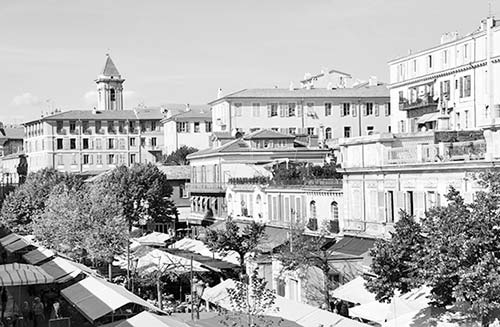
The first section is devoted to the Riviera’s largest flower market. In operation since the 19th century, this market offers plants and flowers that grow effortlessly and ubiquitously in this climate, including the local favorites: carnations, roses, and jasmine. Locals know the season by what’s on sale (mimosas in February, violets in March, and so on). Until the recent rise in imported flowers, this region supplied all of France with flowers. Still, fresh flowers are cheap here, the best value in this expensive city. The Riviera’s three big industries are tourism, flowers, and perfume (made from these flowers...take a whiff).
The boisterous produce section trumpets the season with mushrooms, strawberries, white asparagus, zucchini flowers, and more—whatever’s fresh gets top billing. What’s in season today?
The market opens up at Place Pierre Gautier. It’s also called Plassa dou Gouvernou—you’ll see bilingual street signs here that include the old Niçois language, an Italian dialect. This is where farmers set up stalls to sell their produce and herbs directly.
From the steps, look up to the hill that dominates to the east. In the Middle Ages, a massive castle stood there with soldiers at the ready. Over time, the city sprawled down to where you are now. With the river guarding one side (running under today’s Promenade du Paillon parkway) and the sea the other, this mountain fortress seemed strong—until Louis XIV leveled it in 1706. Nice’s medieval seawall ran along the line of two-story buildings where you’re standing.
Now, look across Place Pierre Gautier to the large “palace.” The Ducal Palace was where the kings of Sardinia, the city’s Italian rulers until 1860, resided when in Nice. (For centuries, Nice was under the rule of the Italian capital of Turin.) Today, the palace is the local police headquarters. The land upon which the Cours Saleya sits was once the duke’s gardens and didn’t become a market until Nice’s union with France.
• Continue down Cours Saleya. The faded golden building that seals the end of the square is where Henri Matisse spent 17 years. I imagine he was inspired by his view. The Café les Ponchettes is perfectly positioned for you to enjoy the view too if you want a coffee break. At the café, turn onto...
Look up at the first floor of the first building on your right. Adam and Eve are squaring off, each holding a zucchini-like gourd. This scene represents the annual rapprochement in Nice to make up for the sins of a too-much-fun Carnival (Mardi Gras, the pre-Lenten festival). Residents of Nice have partied hard during Carnival for more than 700 years.
Next, check out the small Baroque church (Notre-Dame de l’Annonciation, closed 12:00-14:30) dedicated to Ste. Rita, the patron saint of desperate causes and desperate people (see display in window). She holds a special place in locals’ hearts, making this the most popular church in Nice. Drop in for a peek at the dazzling Baroque decor. The first chapel on the right is dedicated to St. Erasmus, protector of mariners.
• Turn right on the next street, where you’ll pass one of Vieux Nice’s most happening bars (the recommended Distilleries Ideales), with a swashbuckling interior that buzzes until the wee hours. Pause at the next corner and study the classic Vieux Nice scene in all directions. Now turn left on Rue Droite and enter an area that feels like Little Naples.
In the Middle Ages, this straight, skinny street provided the most direct route from river to sea within the old walled town. Pass the recommended restaurant Acchiardo. Notice stepped lanes leading uphill to the castle. Pop into the Jesuit Eglise St-Jacques church (also called Eglise du Gésu) for an explosion of Baroque exuberance hidden behind that plain facade.
We’re turning left onto Rue Rossetti...but if you continued another block along Rue Droite you’d find the Palais Lascaris (c. 1647), home of one of Nice’s most prestigious families. Today it’s a museum and worth a quick look (peek in the entry for free or take a tour, covered by Nice museum €10 combo-ticket, Wed-Mon 10:00-18:00, from 11:00 off-season, closed Tue year-round). Inside you’ll find a collection of antique musical instruments—harps, guitars, violins, and violas (good English explanations)—along with elaborate tapestries and a few well-furnished rooms. The palace has four levels—but only two are open to the public: The ground floor was used for storage, the first floor was devoted to reception rooms (and musical events), the owners lived a floor above that, and the servants lived at the top. Look up and make faces back at the guys under the balconies.
• Shortly after making a left on Rue Rossetti, you’ll cross Rue Benoît Bunico.
In the 18th century, this street served as a ghetto for Nice’s Jews. At sunset, gates would seal the street at either end, locking people in until daylight. To identify Jews as non-Christians, the men were required to wear yellow stars and the women to wear yellow scarves. Wander a few steps up the street to find the white columns and archway across from #19 that mark what was the synagogue until 1848, when revolution ended the notion of ghettos in France.
• Continue down Rue Rossetti to...
The most Italian of Nice’s piazzas, Place Rossetti comes alive after dark—in part because of the Fenocchio gelato shop, popular for its many innovative flavors.
Check out the Cathedral of St. Réparate—an unassuming building for a big-city cathedral. It was relocated here in the 1500s, when Castle Hill was temporarily converted to military use. The name comes from Nice’s patron saint, a teenage virgin named Réparate, whose martyred body floated to Nice in the fourth century accompanied by angels. The beautiful interior is worth a wander.
• This is the end of our walk. From here you can hike up Castle Hill (from Place Rossetti, take Rue Rossetti uphill; see Castle Hill listing near the end of “Sights in Nice.” Or you can have an ice cream and browse the colorful lanes of Vieux Nice...or grab Apollo and hit the beach.
▲▲▲Chagall Museum (Musée National Marc Chagall)
▲Matisse Museum (Musée Matisse)
Modern and Contemporary Art Museum (Musée d’Art Moderne et d’Art Contemporain)
Fine Arts Museum (Musée des Beaux-Arts)
Archaeological Museum (Musée Archéologique)
Masséna Museum (Musée Masséna)
▲Russian Cathedral (Cathédrale Russe)
▲Castle Hill (Colline du Château)
Narrow-Gauge Train into the Alps (Chemins de Fer de Provence)
Some of Nice’s top attractions—the Promenade des Anglais, the beach, and the old town—are covered earlier in my self-guided walks. But Nice offers some additional worthwhile sights, covered here.
A combo-ticket covers all of Nice’s museums except the Chagall Museum (see details under “Helpful Hints”). The Chagall Museum requires a separate admission (and is well worth it).
The first two museums (Chagall and Matisse) are a long walk northeast of Nice’s city center. Because they’re in the same direction and served by the same bus line (see “Getting There,” next page), try to visit them on the same trip. From Place Masséna, the Chagall Museum is a 10-minute bus ride, and the Matisse Museum is a few stops beyond that.
Even if you don’t get modern art, this museum—with the world’s largest collection of Marc Chagall’s work in captivity—is a delight.
After World War II, Chagall returned from the United States to settle first in Vence and later in St-Paul-de-Vence, both not far from Nice. Between 1954 and 1967, he painted a cycle of 17 large murals designed for, and donated to, this museum. These paintings, inspired by the biblical books of Genesis, Exodus, and the Song of Songs, make up the “nave,” or core, of what Chagall called the “House of Brotherhood.”
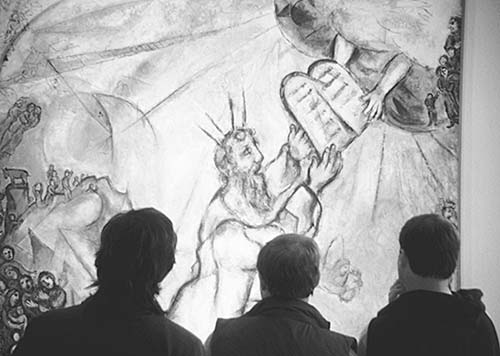
Cost and Hours: €8, €2 more during frequent special exhibits; Wed-Mon 10:00-18:00, Nov-April until 17:00, closed Tue year-round; ticket includes helpful audioguide (though Chagall would suggest that you explore his art without guidance); must check daypacks, idyllic $ garden café (salads and plats), tel. 04 93 53 87 20, http://en.musees-nationaux-alpesmaritimes.fr.
Getting There: The museum is located on Avenue Docteur Ménard. Taxis from the city center cost about €15. Buses connect the museum with downtown Nice. From downtown, catch bus #15 (Mon-Sat 6/hour, Sun 3/hour, 10 minutes). Catch the bus from the east end of the Galeries Lafayette department store, near the Masséna tram stop, on Rue Sacha Guitry (see map on here). Watch for a Musée Chagall sign on the bus shelter where you’ll get off (on Boulevard de Cimiez).
Visiting the Museum: This small museum has six rooms: two rooms (the main hall and Song of Songs room) with the 17 murals, two rooms for special exhibits, an auditorium with stained-glass windows and a good film, and a mosaic-lined pond (viewed from inside). It takes about one hour to see the whole thing.
In the main hall you’ll find the core of the collection (Genesis and Exodus scenes). Each painting is a lighter-than-air collage of images that draws from Chagall’s Russian folk-village youth, his Jewish heritage, the Bible, and his feeling that he existed somewhere between heaven and earth. He believed that the Bible was a synonym for nature, and that both color and biblical themes were key for understanding God’s love for his creation. Chagall’s brilliant blues and reds celebrate nature, as do his spiritual and folk themes. Notice the focus on couples. To Chagall, humans loving each other mirrored God’s love of creation.
The adjacent octagonal room houses five more paintings. The paintings in this room were inspired by the Old Testament Song of Songs. Chagall was one of the few “serious” 20th-century artists to portray unabashed love. Where the Bible uses the metaphor of earthly, physical, sexual love to describe God’s love for humans, Chagall uses unearthly colors and a mystical ambience to celebrate human love. These red-toned canvases are hard to interpret literally, but they capture the rosy spirit of a man in love with life.
Back near the entry, the wall mosaic (which no longer reflects in the filthy reflecting pond) evokes the prophet Elijah in his chariot of fire (from the Second Book of Kings)—with Chagall’s addition of the 12 signs of the zodiac, which he used to symbolize time.
The auditorium is worth a peaceful moment to enjoy three Chagall stained-glass windows depicting the seven days of creation. This is also where you’ll find a wonderful film (52 minutes) on Chagall, which plays at the top of each hour (not available during special exhibits).
Leaving the Museum: From here, you can return to downtown Nice or head to the Matisse Museum. Taxis usually wait in front of the museum. For the bus back to downtown Nice, turn right out of the museum, then make another right down Boulevard de Cimiez, and ride bus #15 heading downhill. To continue to the Matisse Museum, catch #15 using the uphill stop located across the street.
To walk to the train station area from the museum (20 minutes), turn right out of the museum grounds and follow the first street to the right (hugging the museum). Drop down ramps and staircases, turn left at the bottom under the freeway and train tracks, then turn right on Boulevard Raimbaldi.
This small, underachieving museum fills an old mansion in a park surrounded by scant Roman ruins, and houses a limited sampling of works from the various periods of Henri Matisse’s artistic career. The museum offers an introduction to the artist’s many styles and materials, both shaped by Mediterranean light and by fellow Côte d’Azur artists Picasso and Renoir.
Background: Matisse, the master of leaving things out, could suggest a woman’s body with a single curvy line—letting the viewer’s mind fill in the rest. Ignoring traditional 3-D perspective, he expressed his passion for life through simplified but recognizable scenes in which dark outlines and saturated, bright blocks of color create an overall decorative pattern.
As you tour the museum, look for Matisse’s favorite motifs—including fruit, flowers, wallpaper, and sunny rooms—often with a window opening onto a sunny landscape. Another favorite subject is the odalisque (harem concubine), usually shown sprawled in a seductive pose and with a simplified, masklike face. You’ll also see a few souvenirs from his travels, which influenced much of his work.
Cost and Hours: Covered by €10 Nice museum combo-ticket; Wed-Mon 10:00-18:00, mid-Oct-mid-June from 11:00, closed Tue year-round, 164 Avenue des Arènes de Cimiez, tel. 04 93 81 08 08, www.musee-matisse-nice.org.
Getting There: Take a cab (€20 from Promenade des Anglais). Alternatively, hop bus #15, direction: Rimiez, from the east end of Galeries Lafayette (from train station, catch #17, direction: Cimiez Hôpital). Get off at the Arènes-Matisse bus stop (look for the crumbling Roman arena that once held 10,000 spectators), then walk 50 yards into the park to find the pink villa.
Leaving the Museum: Turn left from the museum into the park, exiting at the Archaeological Museum, and turn right at the street. The bus stop across the street is for bus #17, which goes to the train station, and #20, which heads to the port. For bus #15 (frequent service to downtown and the Chagall Museum), continue walking—with the Roman ruins on your right—to the small roundabout, and find the shelter (facing downhill).
This ultramodern museum features an explosively colorful, far-out, yet manageable collection focused on American and European-American artists from the 1960s and 1970s (Pop Art and New Realism are highlighted. The exhibits cover three floors, one of which is devoted to temporary shows. The permanent collection usually includes a few works by Andy Warhol, Roy Lichtenstein, and Jean Tinguely. You should also find rooms dedicated to Yves Klein and Niki de Saint Phalle. English explanations are posted in some rooms, and there’s a good timeline of Riviera artists from 1947 to 1977. Don’t leave without exploring the views from the rooftop terrace.
Cost and Hours: Covered by €10 Nice museum combo-ticket, Tue-Sun 10:00-18:00, mid-Oct-mid-June from 11:00, closed Mon year-round, near Vieux Nice on Promenade des Arts, tel. 04 93 62 61 62, www.mamac-nice.org.
Housed in a sumptuous Riviera villa with lovely gardens, this museum lacks a compelling collection but holds 6,000 artworks from the 17th to 20th centuries. Start on the first floor and work your way up to enjoy paintings by Monet, Sisley, Bonnard, and Raoul Dufy, as well as a few sculptures by Rodin and Carpeaux.
Cost and Hours: Covered by €10 Nice museum combo-ticket, Tue-Sun 10:00-18:00, mid-Oct-mid-June from 11:00, closed Mon year-round, inconveniently located at the western end of Nice, take bus #12 from train station to Rosa Bonheur stop and walk to 3 Avenue des Baumettes; tel. 04 92 15 28 28, www.musee-beaux-arts-nice.org.
This museum displays various objects from the Romans’ occupation of this region. It’s convenient—just below the Matisse Museum—but is of little interest except to ancient Rome aficionados (scant information in English). Entry includes access to the poorly maintained Roman bath ruins (ask for the English handout).
Cost and Hours: Covered by €10 Nice museum combo-ticket, Wed-Mon 11:00-18:00, closed Tue, near Matisse Museum at 160 Avenue des Arènes de Cimiez, tel. 04 93 81 59 57.
Like Nice’s main square, this museum was named in honor of Jean-André Masséna (born in Antibes), a highly regarded commander during France’s Revolutionary and Napoleonic wars. The beachfront mansion is worth a look for its lavish decor and lovely gardens alone (few English labels in museum, but a €3 booklet in English may be available). The gardens on the seaward side of the museum have a memorial to the 86 people who died in the terrorist attack on the Promenade des Anglais in 2016.
Cost and Hours: Covered by €10 Nice museum combo-ticket, always free to enter gardens, Wed-Mon 10:00-18:00, mid-Oct-mid-June from 11:00, closed Tue year-round, 35 Promenade des Anglais, tel. 04 93 91 19 10.
Nice’s Russian Orthodox church—claimed by some to be the finest outside Russia—is worth a visit. Five hundred rich Russian families wintered in Nice in the late 19th century, and they needed a worthy Orthodox house of worship. Dowager Czarina Maria Feodorovna and her son, Nicholas II, offered the land for the construction, which began in 1903. Nicholas underwrote much of the project and gave this church to the Russian community in 1912. (A few years later, Russian comrades who didn’t winter on the Riviera assassinated him.) Here in the land of olives and anchovies, these proud onion domes seem odd. But, I imagine, so did those old Russians. The park around the church stays open at lunch and makes a nice setting for picnics.

Cost and Hours: Free; daily 9:30-17:30 except during services, chanted services Sat at 18:00, Sun at 10:00; no tourist visits during services, no shorts, Avenue Nicolas II, tel. 04 93 96 88 02, www.sobor.fr.
This hill—in an otherwise flat city center—offers sensational views over Nice, the port (to the east, created for trade and military use in the 15th century), the foothills of the Alps, and the Mediterranean. The views are best early, at sunset, or whenever the weather’s clear.
Nice was founded on this hill. Its residents were crammed onto the hilltop until the 12th century, as it was too risky to live in the flatlands below. Today you’ll find a playground, a café, and a cemetery—but no castle—on Castle Hill.
Cost and Hours: Park is free and closes at 20:00 in summer, earlier off-season.
Getting There: You can get to the top by foot, by elevator (free, daily April-Sept 9:00-19:00, until 20:00 in summer, Oct-March 10:00-18:00, next to beachfront Hôtel Suisse), or by pricey tourist train (see “Tours in Nice,” earlier).
See the “Promenade des Anglais Walk” for a pleasant stroll that ends near Castle Hill.
Leaving Castle Hill: After enjoying the views and hilltop fun, you can walk via the cemetery directly down into Vieux Nice (just follow the signs), descend to the beach (via the elevator or a stepped lane next to it), or hike down the back side to Nice’s port (departure point for boat trips and buses to Monaco and Villefranche-sur-Mer).
Leave the tourists behind and take the scenic train-bus-train combination that runs between Nice and Digne through canyons, along whitewater rivers, and through tempting villages (4/day, departs Nice from Chemins de Fer de Provence Station, two blocks from the Libération tram stop, 4 Rue Alfred Binet, tel. 04 97 03 80 80, www.trainprovence.com).
An appealing stop on the scenic railway is little Entrevaux, a good destination that feels forgotten and still stuck in its medieval shell (about €25 round-trip, 1.5 scenic hours from Nice). Cross the bridge, meet someone friendly, and consider the steep hike up to the citadel (€3, TI tel. 04 93 05 45 73).
The city is a walker’s delight after dark. Promenade des Anglais, Cours Saleya, Vieux Nice, Promenade du Paillon, and Place Masséna are all worth an evening wander. I can’t get enough of the night scene on Place Masséna and around the adjacent fountains.
Nice’s bars play host to a happening late-night scene, filled with jazz, rock, and trolling singles. Most activity focuses on Vieux Nice. Rue de la Préfecture and Place du Palais are ground zero for bar life, though Place Rossetti and Rue Droite are also good targets. Distilleries Ideales is a good place to start or end your evening, with a lively international crowd, a Pirates of the Caribbean interior, and a Cheers vibe (lots of beers on tap, where Rue de la Poissonnerie and Rue Barillerie meet, happy hour 18:00-21:00). Wayne’s Bar and others nearby are happening spots for the younger, Franco-Anglo backpacker crowd (15 Rue Préfecture; see “Vieux Nice Hotels & Restaurants” map). Along the Promenade des Anglais, the classy Le Relais bar at Hôtel Negresco is fancy-cigar old English with frequent live jazz. To savor fine views over Nice, find the Hotel Aston La Scala’s seventh-floor bar/terrace, which is a good spot for a drink any night but offers jazz and blues on Thursdays and Fridays and a DJ on Saturdays (daily 17:00 to late, on the Promenade du Paillon at 12 Avenue Félix Faure, tel. 04 92 17 53 00).
Don’t look for charm in Nice. Seek out a good location and modern, reliable amenities (like air-conditioning). The price rankings given here are for April through October. Prices generally drop considerably November through March and sometimes in April, but go sky-high during the Nice Carnival (in February), the Cannes Film Festival (May), and Monaco’s Grand Prix (late May). Between the film festival and the Grand Prix, the second half of May is slammed. Nice is also one of Europe’s top convention cities, and June is convention month here.
For parking, ask your hotelier or see “Arrival in Nice—By Car,” earlier, under “Orientation to Nice.”
The train station area offers Nice’s cheapest sleeps, but the neighborhood feels sketchy after dark. The cheapest places are older, well-worn, and come with some street noise. Places closer to Avenue Jean Médecin are more expensive and in a more comfortable area.
$$$$ Hôtel du Petit Palais**** is a little belle-époque jewel with 25 handsome rooms tucked neatly into a residential area on the hill several blocks from the Chagall Museum. It’s bird-chirping peaceful and plush, with tastefully designed rooms, a garden terrace, and small pool. You’ll walk 15 minutes down to Vieux Nice (or use bus #15), free street parking is usually easy to find (17 Avenue Emile Bieckert, tel. 04 93 62 19 11, www.petitpalaisnice.com, reservation@petitpalaisnice.com).
$$ Hôtel Vendôme*** gives you a whiff of the belle époque, with pink pastels, high ceilings, and grand staircases in a mansion set off the street. The modern rooms come in all sizes; many have balconies (limited pay parking—book ahead, 26 Rue Pastorelli at the corner of Rue Alberti, tel. 04 93 62 00 77, www.hotel-vendome-nice.com, contact@vendome-hotel-nice.com).
$$ Hôtel St. Georges,** five blocks from the station toward the sea, offers a practical location, a pleasant backyard patio, and friendly Houssein at the reception. Rooms are dark and basic but adequate and fairly priced (family rooms, limited parking—book ahead, 7 Avenue Georges Clemenceau, tel. 04 93 88 79 21, www.hotelsaintgeorges.fr, contact@hotelsaintgeorges.fr).
$ Hôtel Durante*** rents quiet rooms in a happy orange building with rooms wrapped around a flowery courtyard. All but two rooms overlook the well-maintained patio. The rooms have adequate comfort (mostly modern decor), the price is right, and the parking is free on a first-come, first-served basis (family rooms, 16 Avenue Durante, tel. 04 93 88 84 40, www.hotel-durante.com, info@hotel-durante.com).
$ Hôtel Ibis Nice Centre Gare,*** 100 yards to the right as you leave the station, provides a secure refuge in this seedy area. It’s big (200 rooms), modern, has well-configured rooms and a pool, and is next to a handy parking garage (bar, café, 14 Avenue Thiers, tel. 04 93 88 85 85, www.ibishotel.com, h1396@accor.com).
$ Hôtel Belle Meunière,* in an old mansion built for Napoleon III’s mistress, attracts budget-minded travelers with cheap rates a block below the train station. Simple but well-kept, the place has adequate rooms and charismatic Mademoiselle Marie-Pierre presiding with her perfect English (family rooms, air-con, no elevator but just three floors, laundry service, limited pay parking, 21 Avenue Durante, tel. 04 93 88 66 15, www.bellemeuniere.com, hotel.belle.meuniere@cegetel.net).
¢ B&B Nice Home Sweet Home is a good budget value. Laid-back Genevieve (a.k.a. Jennifer) Levert rents out four large rooms and one small single in her home. Her cavernous rooms are artfully decorated, with high ceilings, big windows, and space to spread out (cheaper rooms with shared bath, no air-conditioning, elevator, one floor up, laundry services, kitchen access, 35 Rue Rossini at intersection with Rue Auber, mobile 06 50 83 25 85, glevert@free.fr).
Hostel: The fun, good-value ¢ Auberge de Jeunesse les Camélias has a handy location, modern facilities, and lively evening atmosphere. Rooms accommodate four to eight people and come with showers and sinks—WCs are down the hall (includes breakfast, rooms closed 11:00-15:00 but can leave bags, laundry, kitchen, safes, bar, 3 Rue Spitalieri, tel. 04 93 62 15 54, www.hihostels.com, accueil.nice@hifrance.org).
These hotels are close to the beach. The Negresco and West End are big, vintage Nice hotels that open onto the sea from the heart of the Promenade des Anglais.
$$$$ Hôtel Negresco***** owns Nice’s most prestigious address on the Promenade des Anglais and knows it. Still, it’s the kind of place that if you were to splurge just once in your life... Rooms are opulent, tips are expected, and it seems the women staying here have cosmetically augmented lips (some view rooms, très classy bar, 37 Promenade des Anglais, tel. 04 93 16 64 00, www.hotel-negresco-nice.com, reservations@hotel-negresco.com).
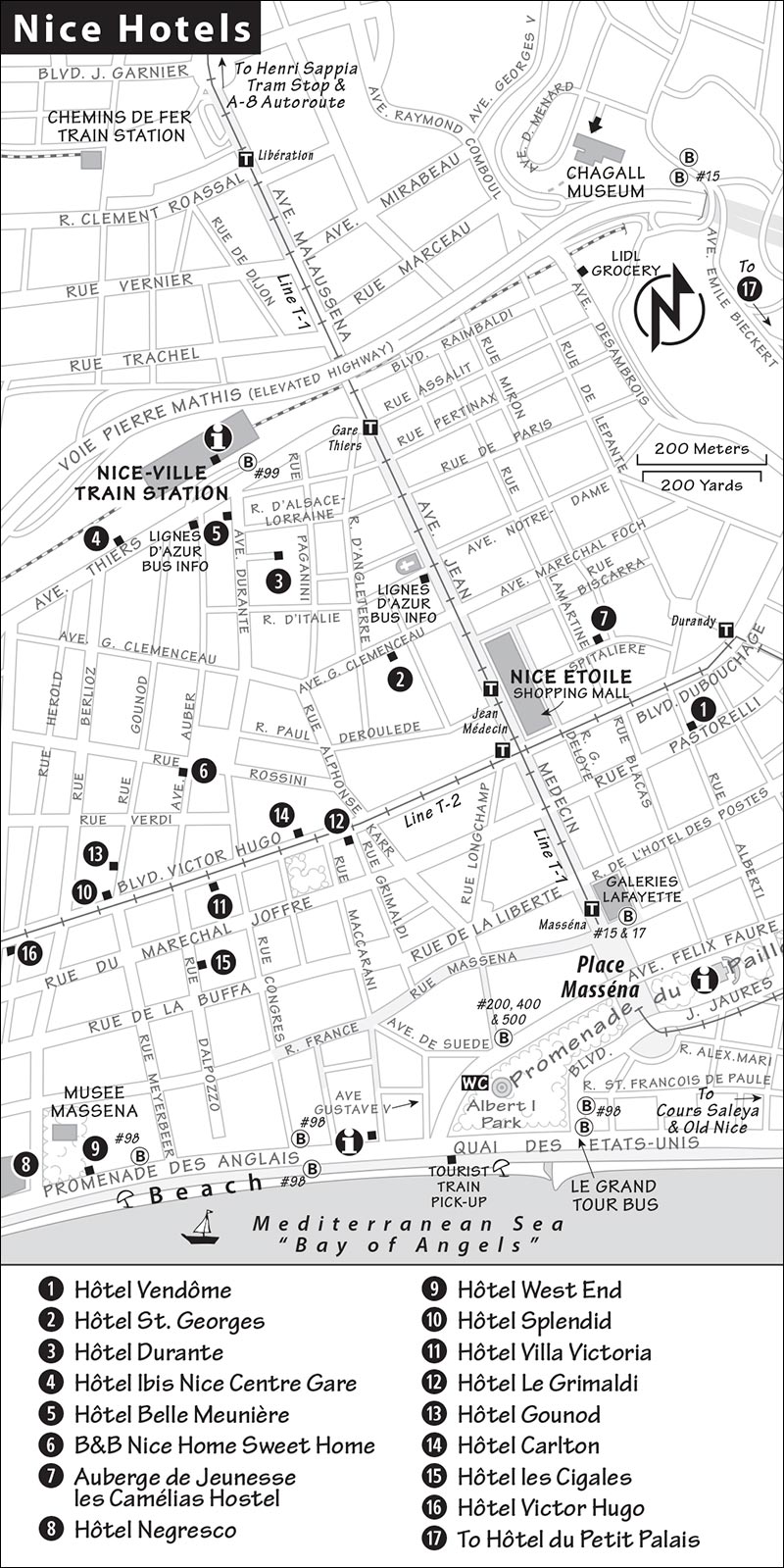
$$$$ Hôtel West End**** opens onto the Promenade des Anglais with formal service and decor, classy public spaces, and high prices (some view rooms, 31 Promenade des Anglais, tel. 04 92 14 44 00, www.hotel-westend.com, reservation@westendnice.com).
$$$ Hôtel Splendid**** is a worthwhile splurge if you miss your Marriott. The panoramic rooftop pool, bar/restaurant, and breakfast room almost justify the cost...but throw in plush rooms, a free gym, and spa services, and you’re as good as at home (pay parking, 50 Boulevard Victor Hugo, tel. 04 93 16 41 00, www.splendid-nice.com, info@splendid-nice.com).
$$$ Hôtel Villa Victoria**** is a service-oriented place managed by cheery and efficient Marlena and her staff, who welcome travelers into a classy old building with a spacious lobby overlooking a sprawling and wonderful rear garden-courtyard. Rooms are comfortable and well-kept, but those facing the street come with some noise (pay parking, 33 Boulevard Victor Hugo, tel. 04 93 88 39 60, www.villa-victoria.com, contact@villa-victoria.com).
$$$ Le Grimaldi**** is a lovely place with a beautiful lobby and 48 spacious rooms with high ceilings and tasteful decor (big breakfast extra, a few suites and connecting rooms ideal for families, 15 Rue Grimaldi, tel. 04 93 16 00 24, www.le-grimaldi.com, info@le-grimaldi.com).
$$ Hôtel Gounod*** is a fine value behind Hôtel Splendid. Because the two share the same owners, Gounod’s guests are allowed free access to Splendid’s pool, hot tub, and other amenities. Most rooms are quiet, with high ceilings and traditional decor (family rooms, pay parking, 3 Rue Gounod, tel. 04 93 16 42 00, www.gounod-nice.com, info@gounod-nice.com).
$$ Hôtel Carlton*** is a good deal. It’s a well-run, unpretentious, and comfortable place with spacious, simply decorated rooms, many with decks (26 Boulevard Victor Hugo, tel. 04 93 88 87 83, www.hotel-carlton-nice.com, info@hotel-carlton-nice.com, helpful Lionel at the reception).
$$ Hôtel les Cigales,*** a few blocks from the Promenade des Anglais, is a sweet little place with 19 sharp and richly colored rooms and a cool upstairs terrace, all well-managed by friendly Veronique and Elaine (RS%, 16 Rue Dalpozzo, tel. 04 97 03 10 70, www.hotel-lescigales.com, info@hotel-lescigales.com).
$ Hôtel Victor Hugo, a traditional and spotless seven-room hotel, is an adorable time-warp place where Gilles warmly welcomes guests. All rooms are on the ground floor and come with kitchenettes and air-conditioning. While it’s a short walk from the Promenade des Anglais, it’s a hefty walk from Vieux Nice (RS%, includes breakfast, 59 Boulevard Victor Hugo, tel. 04 93 88 12 39, www.hotel-victor-hugo-nice.com).
Most of these hotels are either on the sea or within an easy walk of it. (Hôtel Lafayette and the Villa Saint Exupéry Beach hostel are more central).
$$$$ Hôtel la Perouse,**** built into the rock of Castle Hill at the east end of the bay, is a fine splurge. This refuge-hotel is top-to-bottom flawless in every detail—from its elegant rooms (satin curtains, velour headboards) and attentive staff to its rooftop terrace with hot tub, sleek pool, and lovely $$$$ garden restaurant. Sleep here to be spoiled and escape the big city (good family options, 11 Quai Rauba Capeu, tel. 04 93 62 34 63, www.hotel-la-perouse.com, lp@hotel-la-perouse.com).
$$$$ Hôtel Suisse,**** below Castle Hill, has brilliant sea and city views for a price—sleep elsewhere if you don’t land a view. It’s surprisingly quiet given the busy street below (most view rooms have balconies, 15 Quai Rauba Capeu, tel. 04 92 17 39 00, www.hotels-ocre-azur.com, hotel.suisse@hotels-ocre-azur.com).
$$$ Hôtel Albert 1er*** is a fair deal in a central, busy location on Albert I Park, two blocks from the beach and Place Masséna. The staff is formal and the rooms are well-appointed and spotless, with heavy brown tones. Some have views of the bay, while others overlook the park or a quiet interior courtyard (4 Avenue des Phocéens, tel. 04 93 85 74 01, www.hotel-albert-1er.com, info@hotel-albert1er.com).
$$$ Hôtel Mercure Marché aux Fleurs**** is ideally situated near the sea and Cours Saleya. Rooms are sharp, standard doubles are tight, and prices can be either reasonable or exorbitant (superior rooms worth the extra euros—especially those with views, 91 Quai des Etats-Unis, tel. 04 93 85 74 19, www.hotelmercure.com, h0962@accor.com).
$$ Hôtel de la Mer** is an intimate, 12-room place with an enviable position overlooking Place Masséna, just steps from Vieux Nice and the beach. Rooms are modern, comfortable, and well-priced (4 Place Masséna, tel. 04 93 92 09 10, www.hoteldelamernice.com, hotel.mer@wanadoo.fr). They also run the $$$$ Suites Masséna in the same building, with seven huge, modern, high-ceilinged rooms—designed for two but with room for three (tel. 04 93 13 48 11, www.lessuitesmassena.com).
$$ Room With a Vue rents four well-designed rooms (several with small balconies) right on Cours Saleya above the Pain et Cie bakery/café (3 Louis Gassin, tel. 04 93 62 94 32, roomwithavue@gmail.com, enthusiastic manager Fred).
$$ Hôtel Lafayette,*** located a block behind the Galeries Lafayette department store, is a modest, homey place with 17 mostly spacious, well-designed and good-value rooms. All rooms are one floor up from the street—some traffic noise sneaks in (RS%, 32 Rue de l’Hôtel des Postes—see “Vieux Nice Hotels & Restaurants” map, tel. 04 93 85 17 84, www.hotellafayettenice.com, info@hotellafayettenice.com).
Hostel: ¢ Villa Saint Exupéry Beach is a sprawling place with more than 200 beds, split between a building with private rooms (figure $) and the hostel next door (dorms with 4-8 beds). The owners and many staff are English so communication is easy. The vibe is young and fun, with a bar, cheap restaurant, community kitchen, air-con, elevator, and beaucoup services including laundry, yoga classes, free walking tour of Vieux Nice, and scuba diving (no curfew, 6 Rue Sacha Guitry, tel. 04 93 16 13 45, www.villahostels.com, beach@villahostels.com).
Several airport hotels offer a handy and cheap port-in-the-storm for those with early flights or who are just stopping in for a single night: $$ Hôtels Campanile (www.campanile.fr) and $$$ Nouvel (www.novotel.com) are closest; $$ Hôtel Ibis Budget Nice Aéroport (www.ibis.com) is cheap and a few minutes away, though two other Ibis hotels are closer and a bit pricier. Free shuttles connect these hotels with both airport terminals.
You’ll find plenty of regional dishes and lots of Italian influence blended with classic French cuisine in this Franco-Italian city. My favorite dining spots are in Vieux Nice. It’s well worth booking ahead for these places. If Vieux Nice is too far, I’ve listed some great places handier to your hotel. Promenade des Anglais is ideal for picnic dinners on warm, languid evenings or a meal at a beachside restaurant. For a more romantic and peaceful meal, head for nearby Villefranche-sur-Mer (described later). Avoid the fun-to-peruse but terribly touristy eateries lining Rue Masséna.
Nice’s dinner scene converges on Cours Saleya, which is entertaining enough in itself to make the generally mediocre food a fair deal. It’s a fun, festive spot to compare tans and mussels. Most of my recommendations are on side lanes inland from here. Even if you’re eating elsewhere, wander through here in the evening. For locations, see the “Vieux Nice Hotels & Restaurants” map.
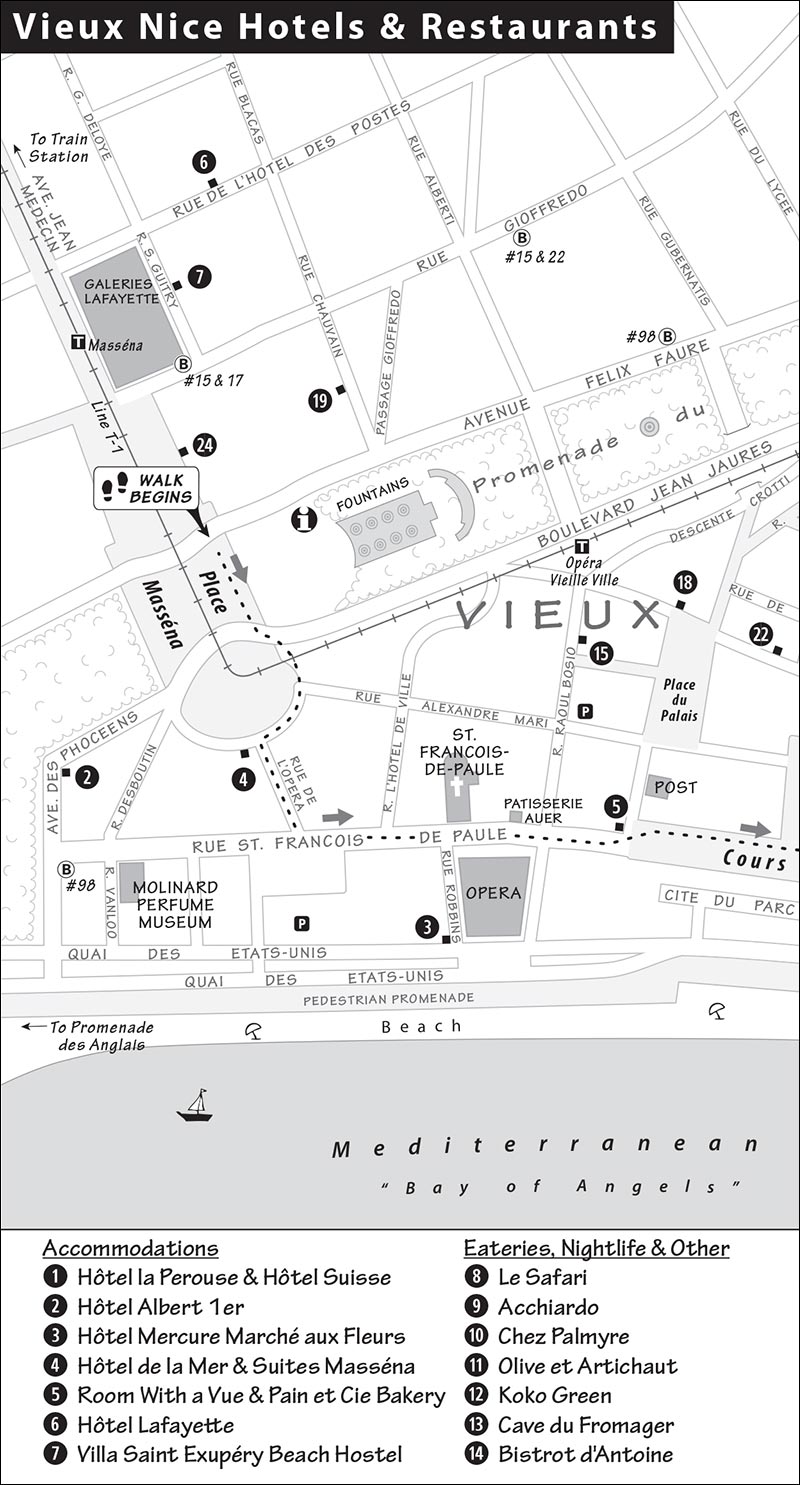
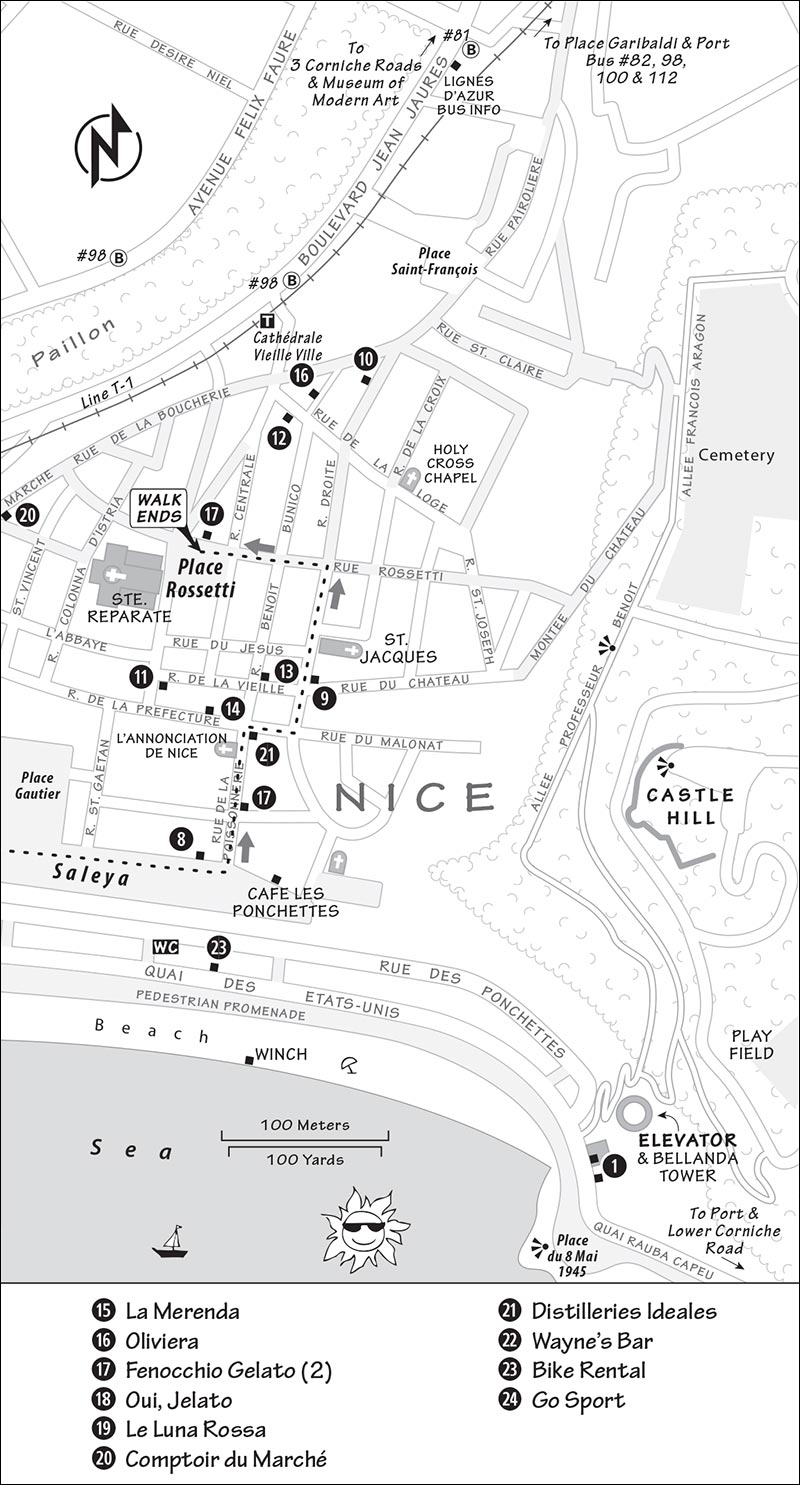

(See “Nice Hotels & Restaurants” map.)
While local foodies would avoid Cours Saleya like a McDonald’s, the energy of wall-to-wall restaurants taking over Vieux Nice’s market square each evening is enticing. $$$ Le Safari is a fair option for Niçois cuisine, pasta, pizza, and outdoor dining. This sprawling café-restaurant, convivial and rustic with the coolest interior on the Cours, is packed with locals and tourists, and staffed with hurried waiters (daily noon to late, 1 Cours Saleya, tel. 04 93 80 18 44, www.restaurantsafari.fr).
(See “Nice Hotels & Restaurants” map.)
$$ Acchiardo is a homey-but-lively eatery that mixes loyal clientele with hungry tourists. As soon as you sit down you know this is a treat. It’s a family affair overseen by Monsieur Acchiardo and his good-looking sons, Jean-François and Raphael. A small plaque under the menu outside says the restaurant has been run by father and son since 1927. The food is delicious and copious, and the house wine is good and reasonable (Mon-Fri 19:00 until late, closed Sat-Sun and Aug, often a line out the door, reservations smart, indoor seating only, 38 Rue Droite, tel. 04 93 85 51 16).
$ Chez Palmyre, your best budget bet in Vieux Nice, is tiny and popular, so book ahead (a week is advised). The ambience is rustic and fun, with people squeezed onto shared tables to enjoy the homestyle cooking. Philippe serves everyone the same three-course, €17 menu, which changes every two weeks (closed Sat-Sun, 5 Rue Droite, tel. 04 93 85 72 32).
$$$ Olive et Artichaut is a sharp bistro-diner with a small counter, black-meets-white floor tiles, and a foodie vibe. It’s a good choice to dine on carefully prepared Mediterranean dishes with creative twists (closed Mon-Tue, 6 Rue Ste. Réparate, tel. 04 89 14 97 51).
$$ Koko Green is a sweet little haven for vegan and raw-food types and is run by a delightful Franco-Kiwi couple (open Thu-Sun for lunch, Sat for lunch and dinner, 1 Rue de la Loge, mobile 07 81 63 14 88).
$$$ Cave du Fromager is run by young owners Maeva and Mattieu, who are crazy about cheese and wine. Come here to escape the heat and dine in cozy, cool, vaulted cellars surrounded by shelves of wine and cheery lights. You’ll be treated to delicious dishes featuring fresh fish, pasta, and ham—most with cheese as a key ingredient. This is a good choice for vegetarians, and for singles who enjoy eating at the small counter and watching the chef work. Book ahead (closed Tue, just off Place du Jésus at 29 Rue Benoît Bunico, tel. 04 93 13 07 83, www.lacavedufromager.com).
$$ Bistrot d’Antoine has street appeal inside and out. It’s a warm, vine-draped place whose menu emphasizes affordable Niçois cuisine and good grilled selections. It’s popular, so call a day or two ahead to reserve a table. The upstairs room is quieter than the outdoor tables and ground-floor room (closed Sun-Mon, 27 Rue de la Préfecture, tel. 04 93 85 29 57).
$$ La Merenda is a shoebox where you’ll sit on small stools and dine on simple homestyle dishes in a communal environment. The menu changes with the season, but the hardworking owner, Dominique, does not. This place fills fast, so arrive early, or better yet, drop by during lunch to reserve for dinner—seatings are at 19:00 and 21:00 (closed Sat-Sun, cash only, 4 Rue Raoul Bosio, no telephone).
$$ Oliviera venerates the French olive. This fun shop/restaurant offers olive oil tastings and a menu of Mediterranean dishes paired with specific oils (like a wine pairing). Adorable owner Nadim speaks excellent English, knows all of his producers, and provides animated “Olive Oil 101” explanations with your meal. It’s a good place for vegetarians—try his guacamole-and-apple dish; the pesto is also excellent (lunch only, closed Sun-Mon, cash only, 8 bis Rue du Collet, tel. 04 93 13 06 45).
(See “Nice Hotels & Restaurants” map.)
Gelato lovers should save room for the tempting ice-cream stands in Vieux Nice (open daily until late). Fenocchio is the city’s favorite, with mouthwatering displays of dozens of flavors ranging from lavender to avocado (two locations: 2 Place Rossetti and 6 Rue de la Poissonnerie). Gelato connoisseurs should head for Oui, Jelato, where the quality is the priority rather than the selection (5 Rue de la Préfecture, on the Place du Palais).
An appealing lineup of bistros overflowing with outdoor tables stretches along the broad sidewalk on Rue Biscarra (just east of Avenue Jean Médecin behind Nice Etoile, all closed Sun). Come here to dine with area residents away from most tourists. Peruse the choices—all five places are different and reservations are normally not needed.
$$ Le Luna Rossa is a small neighborhood place serving delicious French-Italian dishes. Owner Christine and her staff welcome diners with enthusiastic service and reasonable prices. Pasta dishes are copious and served in cast-iron pans, and the assortiment main course is a great sampler dish. Dine inside or outside on a sidewalk terrace (closed Sun-Mon, just north of parkway at 3 Rue Chauvain, tel. 04 93 85 55 66).

$ L’Ovale takes its name from the shape of a rugby ball. Come here for an unpretentious and local café-bistro experience. Owner David serves traditional dishes from southwestern France (rich and meaty). Dining is inside only. Consider the cassoulet, the hearty salade de manchons with duck and walnuts, or the €18-23 three-course menus (daily, 29 Rue Pastorelli, tel. 04 93 80 31 65).
$$$ Les 5 Sens (“The Five Senses”) is a lively and dressy restaurant serving classic French fare at higher-end prices that justify the cost for discerning diners (daily, 37 Rue Pastorelli, tel. 09 81 06 57 00).
$$ La Maison de Marie is a surprisingly high-quality refuge off Nice’s touristy restaurant row. The interior tables are candlelit, white-tablecloth classy, while the tables in the courtyard enjoy a relaxed bistro feel. Expect some smokers outside. The menu is a good value (daily, 5 Rue Masséna, tel. 04 93 82 15 93).
$$ Comptoir du Marché, named for its red wood counter, feels like a wine shop-meets-bistro-meets-bakery with cozy ambience in and out. It’s at a busy pedestrian corner and serves traditional French cuisine with a smile (closed Sun-Mon, 8 Rue du Marché, tel. 04 93 13 45 01).
$ Voyageur Nissart has blended good-value cuisine with friendly service since 1908. Kind owner Max and his able assistant Cédric are great hosts, and the quality of their food makes this place both very popular and a good choice for travelers on a budget (book ahead, leave a message in English). Try anything à la niçoise, including the fine salade niçoise (good €18 three-course menus, inexpensive wines, indoor and outdoor seating, closed Mon, a block below the train station at 19 Rue d’Alsace-Lorraine, tel. 04 93 82 19 60, www.voyageurnissart.com).
$$ L’Ecole de Nice brings wine-shop decor to a cozy-but-modern restaurant, and serves a limited selection of delicious dishes complemented by a vast selection of wines. The set-price menu—less than €30 for three courses—is a swinging deal (closed Sun, 16 Rue de la Buffa, tel. 04 93 81 39 30).
$$$ Le Canon is a fine, if trendy, choice run by two friends intent on serving top-quality and inventive dishes that emphasize the region’s local, fresh, and in-season ingredients (closed Sat-Sun, 23 Rue Meyerbeer, tel. 04 93 79 09 24).
$$$ Coco & Rico is a good place away from the tourist fray. Kind Isabelle welcomes you to her fun bistro with creative homemade dishes. The cuisine and wine list represent many regions of France, with a focus on what’s fresh (closed Sun-Mon, indoor and outdoor seating, 3 Rue Dalpozzo, tel. 04 83 50 09 60).
$$$ Mon Petit Café delivers fine, traditional cuisine to appreciative diners in a warm, candlelit setting with rich colors and fine glassware, or on a pleasant front terrace. Book ahead for this dressy place and expect top service and mouth-watering cuisine (closed Sun-Mon, 11 bis Rue Grimaldi, tel. 04 97 20 55 36, www.monpetitcafe-nice.com).
$ Crêperie Bretonne is the only crêperie I list in Nice. Dine on the broad terrace or inside, with relaxed service and jukebox-meets-gramophone ambience. Their top-end, house-special crêpes are creative and enticing. Split a salad to start—try the goat cheese salad with honey (closed Sun, on Place Grimaldi, tel. 04 93 82 28 47).
$$$ Restaurant Le Galet is your best eat-on-the-beach option. The city vanishes as you step down to the beach. The food is nicely presented, and the tables feel elegant, even at the edge of the sand. Arrive for the sunset and you’ll have an unforgettable meal (open for dinner May-mid-Sept, 3 Promenade des Anglais—see “Nice Restaurants” map, tel. 04 93 88 17 23). Sunbathers can rent beach chairs and have drinks and meals served literally on the beach (lounge chairs-€16/half-day, €19/day).
Nice is perfectly situated for exploring the Riviera by public transport. Monaco, Eze-le-Village, Villefranche-sur-Mer, Antibes, Vence, and St-Paul-de-Vence are all within about a one-hour bus or train ride. With a little planning, you can link key destinations in an all-day circuit (for example: Nice, Monaco, and Eze-le-Village or La Turbie, then loop back to Nice). For a comparison of train and bus connections from Nice to nearby coastal towns, see the “Public Transportation in the French Riviera” sidebar on here. It’s also possible to take a boat to several destinations in the Riviera.
From Nice-Ville Station to: Cannes (2/hour, 30 minutes), Antibes (2/hour, 20 minutes), Villefranche-sur-Mer (2/hour, 10 minutes), Eze-le-Village (2/hour, 15 minutes to Eze-Bord-de-Mer, then infrequent bus #83 to Eze, 8/day, 15 minutes), Monaco (2/hour, 20 minutes), Menton (2/hour, 35 minutes).
Regardless of length, most one-way rides on regional buses (except express airport buses) cost €1.50. Tickets are good for up to 74 minutes of travel in one direction, including transfers. For more info on buses in the Riviera, see here. To connect to regional destinations, use the following bus lines and stops (see “Nice Hotels” and “Vieux Nice Hotels & Restaurants” maps for stop locations; www.lignesdazur.com).
Eastbound Buses: Due to the new T-2 tram that will end at the port, expect some changes to stop locations for these buses. Trams T-1 and/or T-2 will get you close to these stops, and transfers are free from tram to bus for all lines but #100.
Bus #100 runs from Nice’s port through Villefranche-sur-Mer (3-4/hour, 20 minutes), Monaco (1 hour), and Menton (1.5 hours). Bus #81 runs from the Promenade des Arts stop to Villefranche-sur-Mer (2-3/hour, 15 minutes) and around Cap Ferrat (30 minutes to St-Jean-Cap-Ferrat). Buses #82 and #112 to Eze-le-Village leave from the Vauban tram stop (about hourly; only #82 runs on Sundays; 30 minutes). For La Turbie, buses run 6/day and take 45 minutes (Mon-Sat take #116 from Vauban tram stop; on Sun catch #T-66 from Pont St. Michel tram stop).
Westbound Buses: Bus #200 goes to Antibes (4/hour Mon-Sat, 2/hour Sun, 1.5 hours) and Cannes (2 hours). Bus #400 heads to St-Paul-de-Vence (2/hour, 45 minutes) and Vence (1 hour). Bus #94 also serves Vence (1-2/hour, 1 hour). All use the Albert I/Verdun stop on Avenue de Verdun, a 10-minute walk along the parkway west of Place Masséna. You must buy tickets before boarding these buses.
In summer, Trans Côte d’Azur offers scenic trips several days a week from Nice to Monaco.
Boats to Monaco depart at 9:30 and 16:00, and return at 11:00 and 17:00. The morning departure can be combined with the late-afternoon return from Monaco, allowing you a full day with Prince Albert II (€39 round-trip, €32 if you don’t get off in Monaco, 45 minutes each way, June-Sept Tue, Thu, and Sat only). Drinks and WCs are available on board. Reservations are required (tel. 04 92 00 42 30, www.trans-cote-azur.com). The same company also runs one-hour round-trip cruises along the coast to Cap Ferrat (see listing under “Tours in Nice,” earlier).
Ouibus and Flixbus run long-distance bus service from Nice; see “Transportation” in the Practicalities chapter. Compare schedules and fares with trains.
Most long-distance train connections from Nice to other French cities require a change in Marseille. The Intercité train to Bordeaux (serving Antibes, Cannes, Toulon, and Marseille—and connecting from there to Arles, Nîmes, and Carcassonne) requires a reservation.
From Nice by Train to: Marseille (18/day, 2.5 hours), Cassis (hourly, 3 hours, transfer in Toulon and/or Marseille), Arles (11/day, 4 hours, most require transfer in Marseille or Avignon), Avignon (10/day, most by TGV, 4 hours, many require transfer in Marseille), Lyon (hourly, 4.5 hours, may require change), Paris’ Gare de Lyon (hourly, 6 hours, may require change), Aix-en-Provence TGV Station (10/day, 2-3 hours, usually changes in Marseille), Chamonix (4/day, 10 hours, requires multiple changes), Beaune (7/day, 7 hours, 1-2 transfers), Florence (6/day, 8 hours, 1-3 transfers), Milan (3 Thello trains/day, 4 hours, www.thello.com; or 4/day, 5 hours, most with transfers), Venice (5/day, 9 hours, 1-3 transfers), Barcelona (2/day via Montpellier or Valence, 9 hours, more with multiple changes).
Nice’s easy-to-navigate airport (Aéroport de Nice Côte d’Azur, airport code: NCE) is literally on the Mediterranean—with landfill runways, a 30-minute drive west of the city center. The two terminals are connected by shuttle buses (navettes). Both terminals have TIs, banks, ATMs, trams, and buses to Nice (tel. 04 89 88 98 28, www.nice.aeroport.fr). Planes leave roughly hourly for Paris (one-hour flight, about the same price as a train ticket, check www.easyjet.com for the cheapest flights to Paris’ Orly airport).
By Taxi: A taxi into the center is expensive considering the short distance (figure €35 to Nice hotels, €60 to Villefranche-sur-Mer, €70 to Antibes, about €5 more at night and on weekends, small fee for bags). Nice’s airport taxis are notorious for overcharging. Before riding, confirm your fare. It’s always a good idea to ask for a receipt (reçu).
By Tram: The T-2 tramway, scheduled to open in late 2019, will serve both airport terminals and will run frequently into Nice, paralleling the Promenade des Anglais and ending at Nice’s Port Lympia. The tram will be handy for those sleeping at hotels near the Promenade des Anglais and Place Masséna.
By Bus: Two bus lines connect the airport with the city center, offering good alternatives to high-priced taxis. Note that these routes may be influenced by the new tram line; check routes before riding. Bus #99 (airport express) runs to Nice’s main train station (€6, 2/hour, 8:00-21:00, 30 minutes, drops you within a 10-minute walk of many recommended hotels). To take this bus to the airport, catch it right in front of the train station (departs on the half-hour). If your hotel is within walking distance of the station, #99 is your best budget bet.
Bus #98 runs along Promenade des Anglais and along the edge of Vieux Nice (€6, 3-4/hour, from the airport 6:00-23:00, to the airport until 21:00, 30 minutes, see the “Nice” map at the beginning of this section for stops).
For all buses, buy tickets from the driver. To reach the bus information office and stops at Terminal 1, turn left after passing customs and exit the doors at the far end. Buses serving Terminal 2 stop across the street from the airport exit (information kiosk and ticket sales to the right as you exit).
By Airport Shuttle: These services vary in reliability but can be cost-effective for families or small groups. Airport shuttles are better for trips from your hotel to the airport, since they require you to book a precise pickup time in advance. Shuttle vans offer a fixed price (about €30 for one person, a little more for additional people or to Villefranche-sur-Mer). Your hotel can arrange this, and I would trust their choice of company.
To get to Villefranche-sur-Mer from the airport, take bus #98 (described above) to Place Garibaldi. From there, use the same ticket to transfer to bus #81. If the new T-2 tram is running, take it to the last stop (Port Lympia). At the port, you can use the same ticket to transfer to bus #81 or buy a separate ticket for bus #100 (see the “Nice” map at the beginning of this section for bus-stop locations). Allow €60 for a taxi.
To reach Antibes, take bus #250 from either terminal (about 2/hour, 40 minutes, €11). For Cannes, take bus #210 from either terminal (1-2/hour, 50 minutes on freeway, €22). Express bus #110 runs from the airport directly to Monaco (2/hour, 50 minutes, €22).
Nice’s port is at the eastern edge of the town center, below Castle Hill; the main promenade and Vieux Nice are on the other side of the hill. Cruise ships dock at either side of the mouth of this port: Terminal 1 to the east or Terminal 2 to the west.
Getting into the City Center: The new T-2 tram will connect the port to the city center and airport. Until it opens, to reach Vieux Nice or the T-1 tram, head to Place Garibaldi by walking or riding the shuttle bus to the top of the port, then angling up Rue Cassini to the square (20-minute walk from either cruise terminal). From here it’s a short walk to Vieux Nice or to the T-1 tram stop. You can ride the T-1 tram to Place Masséna for the start of my “Vieux Nice Walk” or to catch a bus to the Chagall or Matisse museums (#15).
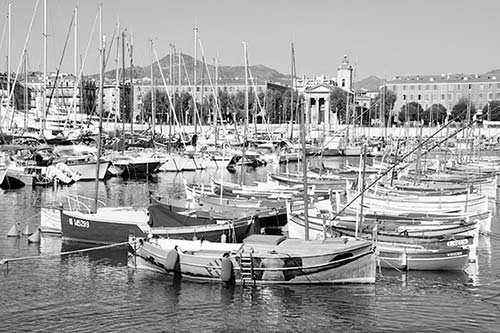
If arriving at Terminal 2 and heading to Vieux Nice, you can skip the walk to Place Garibaldi and stroll directly there by heading around the base of the castle-topped hill, with the sea on your left (10-15 minutes).
Other options to get into town include a taxi from the terminals (about €20 to points within Nice) or the hop-on, hop-off bus, which has a stop at the top of the port (see here).
Getting to Nearby Destinations: To visit Villefranche-sur-Mer or Monaco, it’s best to take bus #100 (the train is faster, but the bus stop is much closer to Nice’s port). The bus stops along the top of the port, near the right end of Place de l’Ile de Beauté (see “Nice” map at the beginning of this section).
To take the train to Villefranche-sur-Mer, Monaco, Antibes, Cannes, or elsewhere, hop on the T-1 tram (stop near Place Garibaldi, described earlier), then ride to the Gare Thiers stop and walk one long block to the main train station. After the T-2 tram opens, you can ride it to the Jean Médecin stop and transfer to the T-1 tram.
Taxis at the terminals charge about €40 one-way to Villefranche-sur-Mer, or €95 one-way to Monaco.
In the glitzy world of the Riviera, Villefranche-sur-Mer offers travelers an easygoing slice of small-town Mediterranean life. From here, convenient day trips let you gamble in Monaco, saunter the Promenade des Anglais in Nice, indulge in seaside walks and glorious gardens in Cap Ferrat, and enjoy views from Eze-le-Village and the Grande Corniche.
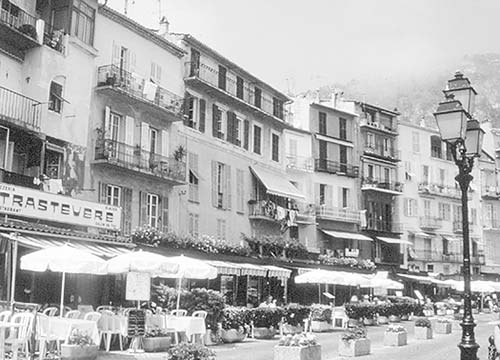
Villefranche-sur-Mer feels more Italian than French, with pastel-orange buildings; steep, narrow lanes spilling into the sea; and pasta on menus. Luxury yachts glisten in the bay. Cruise ships make regular calls to Villefranche-sur-Mer’s deep harbor, creating periodic rush hours of frenetic shoppers and bucket-listers. Sand-pebble beaches, a handful of interesting sights, and quick access to Cap Ferrat keep other visitors just busy enough.
The TI is just off the road that runs between Nice and Monaco, located in a park (Jardin François Binon) below the Nice/Monaco bus stop, labeled Octroi (daily 9:00-18:30; mid-Sept-mid-June Mon-Sat 9:00-12:30 & 14:00-17:30, closed Sun; tel. 04 93 01 73 68, www.villefranche-sur-mer.com). Pick up regional bus schedules and information on seasonal sightseeing boat rides. The TI has an excellent brochure-map showing seaside walks around neighboring Cap Ferrat and information on the Villa Ephrussi de Rothschild’s gardens.
By Bus: Get off at the Octroi stop. To reach the old town, walk downhill past the TI along Avenue Général de Gaulle, take the first stairway on the left, then make a right at the street’s end. The hop-on, hop-off bus from Nice stops at the citadel entrance in the old town.
By Train: Not all trains stop in Villefranche-sur-Mer (you may need to transfer to a local train in Nice or Monaco). Villefranche-sur-Mer’s train station is just above the beach, a short stroll from the old town and most of my recommended hotels (taxis won’t take such a short trip).
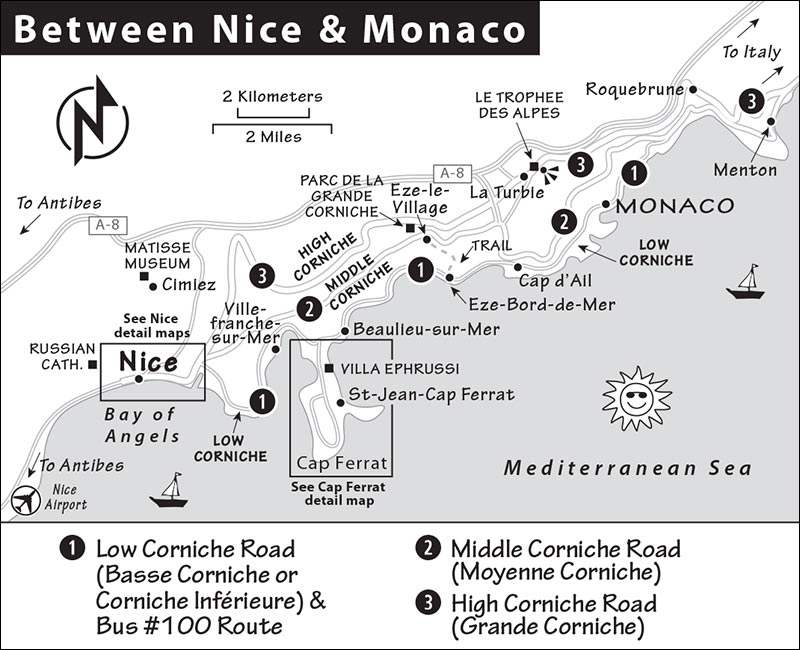
By Car: From Nice’s port, follow signs for Menton, Monaco, and Basse Corniche. In Villefranche-sur-Mer, turn right at the TI (first signal after Hôtel la Flore) for parking and hotels. For a quick visit to the TI, park at the pay lot just below the TI. You’ll pay to park in all public parking areas except from 19:00 to 9:00. Parking around the citadel is reasonable (about €2/hour) but the most central lot at the harbor is pricey (Parking Wilson, €26/day). Parking is free near Port de la Darse. Some hotels have their own parking.
By Plane: Allow an hour to connect from Nice’s airport to Villefranche-sur-Mer (for details, see here).
By Cruise Ship: See “Villefranche-sur-Mer Connections.”
Market Day: A fun bric-a-brac market enlivens Villefranche-sur-Mer on Sundays (on Place Amélie Pollonnais by Hôtel Welcome, and in Jardin François Binon by the TI). On Saturday and Wednesday mornings, a market sets up in Jardin François Binon. A small trinket market springs to action on Place Amélie Pollonnais whenever cruise ships grace the harbor.
Wi-Fi: There’s free Wi-Fi near the TI in the Jardin François Binon, at the port, and in cafés on Place Amélie Pollonnais.
Electric Bike Rental: The adventurous can try Eco-Loc electric bikes as an alternative to taking the bus to Cap Ferrat, Eze-le-Village, or even Nice. You get about 25 miles on a fully charged battery (after that you’re pedaling; €20/half-day, €30/day, mid-April-Sept daily 9:00-17:00, deposit and ID required, best to reserve 24 hours in advance; helmets, locks, and baskets available; pick up bike by the cruise terminal entrance at the port, mobile 06 66 92 72 41, www.ecoloc06.fr).
Spectator Sports: Lively boules action takes place each evening just below the TI and the huge soccer field (for more on this sport, see the sidebar on here).
By Bus: Little minibus #80 saves you the sweat of walking uphill (and gets you within a 15-minute walk of Mont-Alban Fort, described later), but runs only about once per hour from the old port to the top of the hill, stopping at Place Amélie Pollonnais (by the cruise terminal), Hôtel la Fiancée du Pirate, and the Col de Villefranche stop (for buses to Eze-le-Village), before continuing to the outlying suburban Nice Riquier train station (€1.50, runs daily 7:00-19:00, see the “Villefranche-sur-Mer” map for stop locations, schedule posted at stops and available at TI). Also, consider the hop-on, hop-off bus that makes a loop trip from the citadel to Nice (see here).
By Taxi: Taxis wait between the cruise terminal and Place Amélie Pollonnais. Beware of taxi drivers who overcharge. Normal weekday, daytime rates to outside destinations should be about €25 to Cap Ferrat, €40 to central Nice or Eze-le-Village, and €70 to the airport or Monaco. For a reliable taxi, call Didier (mobile 06 15 15 39 15). For a general taxi call tel. 04 93 55 55 55.
(See “Villefranche-sur-Mer” map.)
For tourists, Villefranche is a tiny, easy-to-cover town that snuggles around its harbor under its citadel. This quick self-guided walk laces together everything of importance, starting at the waterfront near where cruise-ship tenders land and finishing at the citadel.
• If arriving by bus or train, you’ll walk five minutes to the starting point. Go to the end of the short pier directly in front of Hôtel Welcome, where we’ll start with a spin tour (spin to the right) to get oriented.
The Harbor: Look out to sea. Cap Ferrat, across the bay, is a landscaped paradise where the 1 percent of the 1 percent compete for the best view. The Rothschild’s pink mansion, Villa Ephrussi (about dead center, hugging the top) is the most worthwhile sight to visit in the area. To its right, in the saddle of the hill, the next big home, with the red-tiled roof, belonged to the late Paul Allen. Geologically, Cap Ferrat is the southern tip of the Alps. The range emerges from the sea here and arcs all across Europe, over 700 miles, to Vienna.


At 2,000 feet, this is the deepest natural harbor on the Riviera and was the region’s most important port until Nice built its own in the 18th century. Today, ships bring tourists rather than pirates. The bay is generally filled with beautiful yachts. (In the evenings, you might see well-coiffed captains being ferried in by dutiful mates to pick up statuesque call girls.)
Up on the hill, the 16th-century citadel (where this walk ends) is marked by flags. The yellow fisherman’s chapel (with the little-toe bell tower) has an interior painted by Jean Cocteau. Hôtel Welcome offers the balconies of dreams. Up the skinny lane just right of the hotel stands the baroque facade of St. Michael’s Church. The waterfront, lined by fancy fish restaurants, curves to the town beach. Fifty yards above the beach stands the train station and above that, supported by arches, is the Low Corniche road, which leads to Monaco. Until that road was built in the 1860s, those hills were free of any development all the way to Monaco. The big yellow building just above can be rented for €300,000 a month (as Madonna did once for a birthday).
• Leave the pier and walk left 30 yards past the last couple of fishing boats surviving from the town’s once-prominent fishing community to find a small bronze bust of Jean Cocteau, the artist who said, “When I look at Villefranche, I see my youth.” A few more steps take you to the little chapel he painted.
Chapel of St. Pierre (Chapelle Cocteau): This chapel is the town’s cultural highlight. Cocteau, who decorated the place, was a Parisian transplant who adored little Villefranche-sur-Mer and whose career was distinguished by his work as an artist, poet, novelist, playwright, and filmmaker. Influenced by his pals Marcel Proust, André Gide, Edith Piaf, and Pablo Picasso, Cocteau was a leader among 20th-century avant-garde intellectuals. At the door, Marie-France—who is passionate about Cocteau’s art—collects a €3 donation for a fishermen’s charity. She then sets you free to enjoy the chapel’s small but intriguing interior. She’s delighted to give you a small tour if you ask (Wed-Sun 9:30-12:30 & 14:00-18:00, usually closed Mon-Tue, hours vary with cruise-ship traffic and season).
• From the chapel, turn right and stroll the harbor promenade 100 yards past romantic harborside tables. Restaurant La Mère Germaine is named for Mother Germaine, who famously took care of US Navy troops in World War II (step inside to see sketches and old photos on the wall). Immediately after the restaurant, a lane leads up into the old town. Walk up a few steps until you reach a long tunnel-like street.
Rue Obscure, the Old Town, and St. Michael’s Church: Here, under these 13th-century vaults, you’re in another age. Turn right and walk to the end of Rue Obscure (which means “dark street”). At the end, wind up to the sunlight past a tiny fountain at Place du Conseil, and a few steps beyond that to a viewpoint overlooking the harbor.
Turn around and stroll back past the fountain, straight down the lane, and gently downhill. Notice the homes built under the heavy arches. At Place des Deux Garçons (the square with a namesake restaurant), turn right on Rue May and climb the stepped lane. Take your first left at the restaurant to find St. Michael’s Church, facing a delightful square with a single magnolia tree (Place de l’Eglise). The deceptively large church features an 18th-century organ, a particularly engaging crucifix at the high altar, and (to the left) a fine statue of a recumbent Christ—carved, they say, from a fig tree by a galley slave in the 1600s.
• Leaving St. Michael’s, go downhill halfway to the water, where you hit the main commercial street. Go right on Rue du Poilu (browsing a real-estate window if you’d like to move here), then curve left, pass the square, and walk up to the...
Citadel: The town’s mammoth castle was built in the 1500s by the Duke of Savoy to defend against the French. When the region joined France in 1860, the castle became just a barracks. Since the 20th century, it’s housed the police station, City Hall, a summer outdoor theater, and art galleries. The single fortified entry—originally a drawbridge over a dry moat (a.k.a. kill zone)—still leads into this huge complex.
The exterior walls slope thickly at the base, indicating that they were built in the “Age of Black Powder”—the 16th century—when the advent of gunpowder made thicker, cannonball-deflecting walls a necessity for any effective fortification. The bastions are designed for smarter crossfire during an attack.
• And that concludes our introductory walk. For a brilliant seaside stroll (described next), drop back down below the citadel to the harbor parking lot (Parking Wilson) and find the stone path that leads to the right.
A seaside walkway originally used by customs agents to patrol the harbor leads under the citadel and connects the old town with the workaday harbor (Port de la Darse). At the port you’ll find a few cafés, France’s Institute of Oceanography (an outpost for the University of Paris oceanographic studies), and an 18th-century dry dock. This scenic walk turns downright romantic after dark. You can also wander the other direction along Villefranche-sur-Mer’s waterfront and continue beyond the train station for postcard-perfect views back to Villefranche-sur-Mer (ideal in the morning—go before breakfast).
This fort, with a remarkable setting on the high ridge that separates Nice and Villefranche-sur-Mer, is a good destination for hikers (also accessible by car and bus; info at TI). From the TI, walk on the main road toward Nice about 500 yards past Hôtel La Flore. Look for wooden trail signs labeled Escalier de Verre and climb about 45 minutes as the trail makes long switchbacks through the woods up to the ridge. Find your way to Mont-Alban Fort (interior closed to tourists) and its sensational view terrace over Villefranche-sur Mer and Cap Ferrat. To visit with a much shorter hike, minibus #80 drops you a 15-minute walk away (by the recommended Hôtel Fiancée du Pirate). Bus #14 from Nice drops you just five minutes away (catch it at Masséna/Guitry stop by Galeries Lafayette department store).
To view this beautiful coastline from the sea, consider taking a quick sightseeing cruise with AMV (€12-22, some stay in the bay, others go as far as Monaco, select days June-Sept, departs across from Hôtel Welcome, tel. 04 93 76 65 65, www.amv-sirenes.com). You can also rent your own motor boat through Dark Pelican (€110/half-day, €175/day, deposit required, on the harbor at the Gare Maritime, tel. 04 93 01 76 54, www.darkpelican.com).
You have a handful of great hotels in all price ranges to choose from in Villefranche-sur-Mer. The ones I list have sea views from at least half of their rooms—well worth paying extra for.
$$$$ Hôtel Welcome**** has the best location in Villefranche-sur-Mer, and charges for it. Anchored seaside in the old town, with all of its 35 plush, balconied rooms overlooking the harbor and a lounge/wine bar that opens to the water, this place lowers my pulse and empties my wallet (pricey garage—must reserve, 3 Quai Amiral Courbet, tel. 04 93 76 27 62, www.welcomehotel.com, resa@welcomehotel.com).
$$ Hôtel La Flore*** is a fine value—particularly if your idea of sightseeing is to enjoy a panoramic view from your spacious bedroom balcony (even street-facing rooms have nice decks). The hotel is warmly run and good for families. Several rooms in the annex sleep four and come with kitchenettes, views, and private hot tubs. It’s a 15-minute uphill hike from the old town, but the parking is free and the bus stops for Nice and Monaco are close by (on main road at 5 Boulevard Princesse Grace de Monaco, tel. 04 93 76 30 30, www.hotel-la-flore.fr, infos@hotel-la-flore.fr).
$$ Hôtel la Fiancée du Pirate*** is a family-friendly view refuge high above Villefranche-sur-Mer on the Middle Corniche (best for drivers, although it is on bus lines #80, #82, and #112 to Eze-le-Village and Nice). Don’t be fooled by the modest facade—Eric and Laurence offer 15 lovely and comfortable rooms, a large pool, a hot tub, a nice garden, and a terrific view lounge area. The big breakfast features homemade crêpes (RS%, laundry service, free parking, 8 Boulevard de la Corne d’Or, Moyenne Corniche/N-7, tel. 04 93 76 67 40, www.fianceedupirate.com, info@fianceedupirate.com).
$ Hôtel de la Darse** is a shy little hotel burrowed in the shadow of its highbrow neighbors and the only budget option in Villefranche. It’s a great value with handsome rooms, but isn’t central—figure 10 scenic minutes of level walking to the harbor and a steep 15-minute walk up to the main road (hourly minibus #80 stops in front; handy for drivers, free parking usually available close by). Seaview rooms are easily worth the extra euros (no elevator, tel. 04 93 01 72 54, www.hoteldeladarse.com, info@hoteldeladarse.com). From the TI, walk or drive down Avenue Général de Gaulle (walkers should turn left on Allée du Colonel Duval into the Jardins de Narvik and follow steps to the bottom).
(See “Villefranche-sur-Mer” map.)
Locals don’t come here in search of refined cuisine and nor should you. For me, dining in Villefranche-sur-Mer is about comfort food, attitude, and ambience. Comparison-shopping is half the fun—make an event out of a predinner stroll through the old city. Saunter past the string of pricey candlelit places lining the waterfront and consider the smaller, less expensive eateries embedded in the old town.
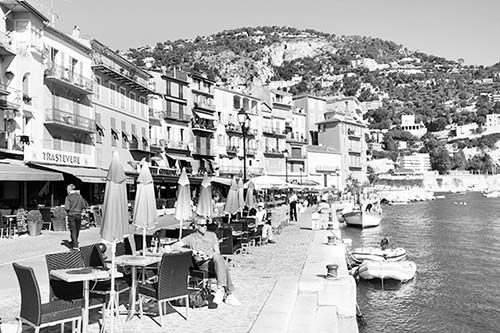
$$$ La Grignotière, hiding in the back lanes, features Mediterranean comfort food. Servings are generous and tasty. Consider the giant helping of spaghetti and gambas (prawns) or the chef’s personal-recipe bouillabaisse, all served by gregarious Brigitte and gentle Chantal (cozy seating inside, a few tables outside, daily, 3 Rue du Poilu, tel. 04 93 76 79 83).
$$ La Belle Etoile is the romantic’s choice, with a charming interior filled with white tablecloths and soft lighting. This intimate place, serving fine Mediterranean cuisine, is a few blocks above the harbor on a small lane (closed Tue-Wed, 1 Rue Baron de Bres, tel. 04 97 08 09 41).
$$$ Les Deux Garçons offers candlelit tables on a quiet square and a refined cuisine that attracts locals in search of a special dinner (closed Wed, 18 Rue du Poilu, tel. 04 93 76 62 40).
$ Le Serre, nestled in the old town near St. Michael’s Church, is a simple, cozy place that opens at 18:00 for early diners. Hardworking owner Sylvie serves well-priced dinners to a loyal local clientele and greets all clients with equal enthusiasm. Choose from the many thin-crust pizzas (named after US states), salads, and meats. Try the daube niçoise meat stew or the great-value, three-course menu (open evenings only, cheap house wine, 16 Rue de May, tel. 04 93 76 79 91).
$$$$ La Mère Germaine, right on the harbor, is the only place in town classy enough to lure a yachter ashore. It’s dressy, with formal service and high prices. The name commemorates the current owner’s grandmother, who fed hungry GIs during World War II. Try the bouillabaisse, served with panache (daily, reserve for harborfront table, 9 Quai de l’Amiral Courbet, tel. 04 93 01 71 39, www.meregermaine.com).
$ La Trinquette is a relaxed, low-key place away from the fray on the “other port,” next to the recommended Hôtel de la Darse (a lovely 10-minute walk from the other recommended restaurants). Gentle Jean-Charles runs the place with charm, delivering reliable cuisine, friendly vibes at good prices, and a cool live-music scene on weekends (daily in summer, closed Wed off-season, 30 Avenue Général de Gaulle, tel. 04 93 16 92 48).
$$ Le Cosmo serves brasserie fare on the town’s appealing main square (daily, Place Amélie Pollonnais, tel. 04 93 01 84 05).
Grocery Store: A handy Casino is a few blocks above Hôtel Welcome at 12 Rue du Poilu (Thu-Tue 8:00-12:30 & 15:30-19:30 except closed Sun afternoon and all day Wed).
Dinner Options for Drivers: If you have a car and are staying a few nights, take a short drive to Eze-le-Village or La Turbie for a late stroll, an early dinner, or a sunset drink. If it’s summer (June-Sept), the best option of all is to go across to a restaurant on one of Cap Ferrat’s beaches, such as $$$ Restaurant de la Plage de Passable, for a before-dinner drink or a dinner you won’t soon forget.
For a comparison of connections by train and bus, see the “Public Transportation in the French Riviera” sidebar on here.
Trains are faster and run later than buses (until 24:00). It’s a level, 10-minute walk from the port to the train station.
From Villefranche-sur-Mer by Train to: Monaco (2/hour, 10 minutes), Nice (2/hour, 10 minutes), Antibes (2/hour, 40 minutes), Eze-Bord-de-Mer (2/hour, 5 minutes) then transfer to bus #83 for Eze-le-Village (see “Getting to Eze-le-Village,” later).
In Villefranche-sur-Mer, the most convenient bus stop is Octroi, just above the TI.
Bus #81 runs from Villefranche-sur-Mer in one direction to Nice (15 minutes) and in the other direction through Beaulieu-sur-Mer (5 minutes) to Cap Ferrat, ending at the port in the village of St-Jean (15 minutes; for other transportation options, see “Getting to Cap Ferrat,” later). The last bus departs from Nice around 20:15, and from St-Jean around 20:50.
Bus #100 runs along the coastal road from Villefranche-sur-Mer westbound to Nice (3-4/hour, 20 minutes) and eastbound to Beaulieu-sur-Mer (10 minutes), Monaco (40 minutes), and Menton (1.25 hours). The last bus from Nice to Villefranche leaves at about 21:00 and from Villefranche to Nice at about 22:00.
To reach Eze-le-Village by bus you have two choices; walk or take bus #80 to upper Villefranche-sur-Mer, then catch bus #82 or #112, which together provide about hourly service to Eze-le-Village (only #82 runs on Sun). You can also take bus #100 or #81 to the Plage Beaulieu stop in nearby Beaulieu-sur-Mer, then catch bus #83 to Eze-le-Village, 8/day).
For more on these buses, including ticket info, routes, and frequencies, see here.
Tenders deposit passengers at a slick terminal building (Gare Maritime) at the Port de la Santé, right in front of Villefranche-sur-Mer’s old town.
Getting into Town: It’s easy to walk to various points in Villefranche-sur-Mer. The town’s charming, restaurant-lined square is a straight walk ahead from the terminal, the main road (with the TI and bus stop) is a steep hike above, and the train station is a short stroll along the beach. Minibus #80, which departs from in front of the cruise terminal, saves you some hiking up to the main road and bus stop (described earlier).
Getting to Nearby Towns: To connect to other towns, choose between the bus or train. Leaving the terminal, you’ll see directional sights pointing left, to Town center/bus (a 10- to 15-minute, steeply uphill walk to the Octroi bus stop with connections west to Nice or east to Monaco); and right, to Gare SNCF/train station (a 10-minute, level stroll with some stairs at the end). See train and bus connections above.
Taxis wait in front of the cruise terminal and charge exorbitant rates (minimum €15 charge to train station, though most will refuse such a short ride). For farther-flung trips, see the price estimates under “Getting Around Villefranche-sur-Mer,” earlier. For an all-day trip, you can try negotiating a flat fee (say, €300 for a 4-hour tour).
Nice, Villefranche-sur-Mer, and Monaco are linked by three coastal routes: the Low, Middle, and High Corniches. The roads are nicknamed after the decorative frieze that runs along the top of a building (cornice). Each Corniche (kor-neesh) offers sensational views and a different perspective. The villages and sights in this section are listed from west to east in the order you’ll reach them when traveling from Villefranche-sur-Mer to Monaco.
The corniches are peppered with impressive villas such as La Leopolda, a sprawling estate with a particularly grand entry that’s named for its 1930s owner, King Leopold II of Belgium (who owned the entire peninsula of Cap Ferrat in addition to this estate). Those driving up to the Middle Corniche from Villefranche-sur-Mer can look down on this yellow mansion and its lush garden, which fill an entire hilltop. The property was later owned by the Agnelli family (of Fiat fame and fortune), and then by the Safra family (Brazilian bankers). Its current value is more than a half-billion dollars.
For an overview of these three roads, see the “Between Nice & Monaco” map.
Low Corniche: The Basse Corniche (also called “Corniche Inférieure”) strings ports, beaches, and seaside villages together for a traffic-filled ground-floor view. It was built in the 1860s (along with the train line) to bring people to the casino in Monte Carlo. When this Low Corniche was finished, many hill-town villagers descended to the shore and started the communities that now line the sea. Before 1860, the population of the coast between Villefranche-sur-Mer and Monte Carlo was zero. Think about that as you make the congested trip today.
Middle Corniche: The Moyenne Corniche is higher, quieter, and far more impressive. It runs through Eze-le-Village and provides breathtaking views over the Mediterranean, with several scenic pullouts.
High Corniche: Napoleon’s crowning road-construction achievement, the Grande Corniche caps the cliffs with staggering views from almost 1,600 feet above the sea. Two thousand years ago, this was called the Via Aurelia, used by the Romans to conquer the West.
Drivers can find the three routes from Nice by driving up Boulevard Jean Jaurès, past Vieux Nice and the port. For the Low Corniche (to Villefranche-sur-Mer and Cap Ferrat), follow signs to N-98 (Monaco par la Basse Corniche), which leads past Nice’s port. Signs for N-7 and the Middle Corniche (Moyenne Corniche) appear shortly after the turnoff to the Low Corniche. Signs for the High (Grande) Corniche appear a bit after that; follow D-2564 to Col des 4 Chemins and the Grande Corniche.
The Best Route from Nice to Monaco: This breathtaking drive, worth ▲▲▲, takes the Middle Corniche from Nice or Villefranche-sur-Mer to Eze-le-Village, then uphill following signs to the Grande Corniche and La Turbie. For cloud-piercing, 360-degree views, take Boulevard Maréchal Leclerc uphill from Eze-le-Village’s western edge and follow signs for Parc de la Grande Corniche. The road becomes the winding Route de la Revère, which has viewpoints galore with views north to the Alps, straight down to the village, and along the Riviera from Naples to Barcelona (well, almost). Bring a picnic, as benches and tables are plentiful. Continue east from here along the Grande Corniche to La Turbie, keeping an eye out for brilliant views back over Eze-le-Village, then finish by dropping down into Monaco.
Buses travel along each Corniche; the higher the route, the less frequent the buses (see the “Between Nice & Monaco” map). Bus #100 runs along the Low Corniche from Nice to Monaco (3-4/hour). Bus #112 provides the single best route to enjoy this area as it connects Monaco and Nice via Eze-le-Village along the Middle Corniche (6/day, none on Sun). Bus #T-66 connects Nice with La Turbie along the High Corniche (3-6/day), and bus #11 does the same from Monaco (6/day).
This exclusive peninsula, rated ▲▲, decorates Villefranche-sur-Mer’s views. Cap Ferrat is a peaceful eddy off the busy Nice-Monaco route (Low Corniche). You could spend a leisurely day on this peninsula, wandering the sleepy port village of St-Jean-Cap-Ferrat (usually called “St-Jean”), touring the Villa Ephrussi de Rothschild mansion and gardens, and walking on sections of the beautiful trails that follow the coast. If you owned a house here, some of the richest people on the planet would be your neighbors.
Tourist Information: The main TI is near the harbor in St-Jean (Mon-Sat 9:30-18:30, Sun 10:00-17:30; Oct-April Mon-Sat 9:00-17:00, closed Sun; 5 Avenue Denis Séméria, bus #81 stops here at the office du tourisme). A smaller TI is near the Villa Ephrussi (closed Sat off-season, closed Sun year-round, 59 Avenue Denis Séméria, tel. 04 93 76 08 90, www.saintjeancapferrat-tourisme.fr).
Here’s how I’d spend a day on the Cap: From Nice or Villefranche-sur-Mer, take bus #81 to the Villa Ephrussi de Rothschild stop (called Passable), then visit the villa. Walk 30 minutes, mostly downhill, to St-Jean for lunch (many options, including grocery shops for picnic supplies) and poke around the village. Take the 45-minute walk on the Plage de la Paloma trail (ideal for picnics). After lunch, take bus #81 or walk the beautiful 30-minute trail to the Villa Kérylos in Beaulieu-sur-Mer and maybe tour that villa (see “Walks Around Cap Ferrat,” later). Return to Villefranche-sur-Mer, Nice, or points beyond by train or bus.
Here’s an alternative plan for the star-gazing, nature-loving beach bum: Visit Villa Ephrussi then walk to St-Jean for lunch, hike six miles around the entirety of Cap Ferrat (2-3 hours), and enjoy the late afternoon on the beach at Plage de Passable. At sunset, have a drink or dinner at the recommended Restaurant de la Plage de Passable, then walk or catch a taxi back.
From Nice or Villefranche-sur-Mer: Bus #81 (direction: Port de St-Jean) runs to all Cap Ferrat stops (for info on tickets, route, and frequency, see here). For the Villa Ephrussi de Rothschild, get off at the Passable stop (allow 30 minutes from Nice and 10 minutes from Villefranche-sur-Mer’s Octroi stop). The return bus (direction: Nice) begins in St-Jean.
Warning: In high season, late-afternoon buses back to Villefranche-sur-Mer or Nice along the Low Corniche can be jammed (worse on weekends), potentially leaving passengers stranded at stops for long periods. To avoid this, either take the train or board bus #81 on the Cap itself (before it gets crowded).
Cap Ferrat is quick by car (take the Low Corniche) or taxi (allow €30 one-way from Villefranche-sur-Mer, €65 from Nice).
In what seems like the ultimate in Riviera extravagance, Venice, Versailles, and the Côte d’Azur come together in the pastel-pink Villa Ephrussi. Rising above Cap Ferrat, this 1905 mansion has views west to Villefranche-sur-Mer and east to Beaulieu-sur-Mer.
Cost and Hours: Palace and gardens-€14, includes audioguide; mid-Feb-Oct daily 10:00-18:00, July-Aug until 19:00; Nov-mid-Feb Mon-Fri 14:00-18:00, Sat-Sun 10:00-18:00; tel. 04 93 01 33 09, www.villa-ephrussi.com.
Getting There: With luck, drivers can find a free spot to park along the entry road just inside the gate. The nearest bus stop is Passable, just a few minutes after the bus turns onto Cap Ferrat (bus #81, 5-minute walk uphill to the villa). If returning to Nice or Villefranche-sur-Mer by bus, check the posted schedule, and keep in mind that you’re only a minute from the time-point listed for Port de St-Jean.
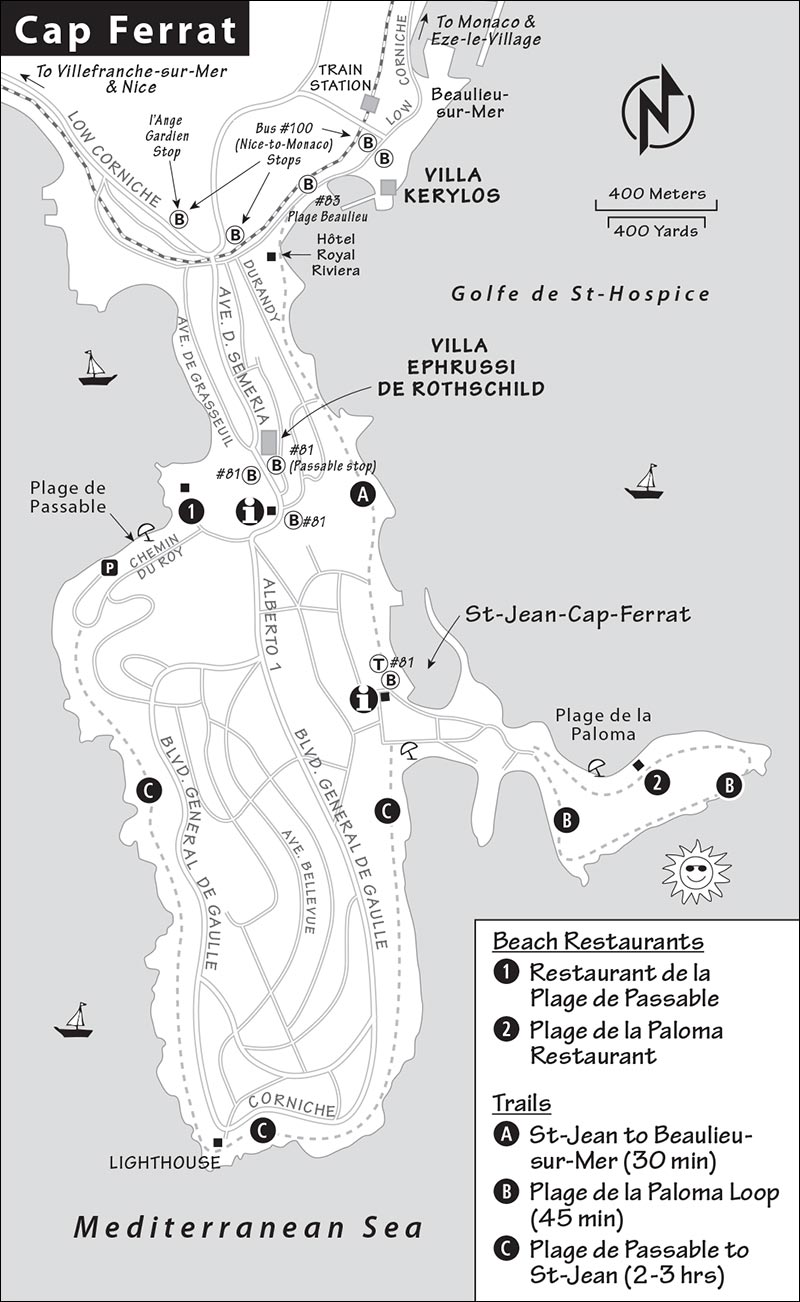
Visiting the Villa: Buy your ticket at the side of the building with the gift shop and get the small map of the gardens, then walk to the main entrance and pick up an audioguide. Start with the well-furnished belle-époque ground floor (well described by the audioguide). Upstairs, an 18-minute film (with English subtitles) explains the gardens and villa and gives you good background on the life of rich and eccentric Béatrice, Baroness de Rothschild, the French banking heiress who built and furnished the place.
As you stroll through the upstairs rooms, you’ll pass royal furnishings and personal possessions, including the baroness’s porcelain collection and her bathroom case for cruises. Her bedroom, sensibly, has views to the sea on both the port and starboard sides, and toward the bow, stretching like the prow of a vast cruise ship, is her garden. Don’t miss the view from her private terrace.
The gorgeous gardens are why most come here. (The audioguide does not cover the gardens.) The ship-shaped gardens were inspired by Béatrice’s many ocean-liner trips. She even dressed her small army of gardeners like sailors. Behind the mansion, stroll through the seven lush gardens re-created from locations all over the world—and with maximum sea views. Don’t miss the Jardin Exotique’s wild cactus, the rose garden at the far end, and the view back to the house from the “Temple of Love” gazebo. Cross the stepping-stone bridge by the playful fountains, if you dare.
An appropriately classy $$ garden-tearoom serves drinks and lunches with a view (12:00-17:30).
Walks from the Villa Ephrussi: It’s a lovely 30-minute stroll, mostly downhill and east, from the Villa Ephrussi to the Villa Kérylos in Beaulieu-sur-Mer (described later) or to the port of St-Jean. To get to either, make a U-turn left at the stop sign below the Villa Ephrussi and follow signs along a small road toward the Hôtel Royal Riviera on Avenue Henri Honoré Sauvan (see “Cap Ferrat” map). Walk about five minutes down; when the road comes to a T, keep straight, passing a gate down a pedestrian path, which ends at the seafront trail (on Place David Niven)—go left to reach the Villa Kérylos, or head right to get to St-Jean. It’s about 15 minutes to either destination once you join this path.
To get to Plage de Passable from the Villa Ephrussi, turn left on the main road just below the villa; after 50 yards you’ll find signs leading down to the beach.
This pebbly little beach, located below the Villa Ephrussi, comes with great views of Villefranche-sur-Mer. It’s a peaceful place, popular with families. One half is public (free, with snack bar, shower, and WC), and the other is run by a small restaurant (€30 includes changing locker, lounge chair, and shower; they have 260 “beds,” but still reserve ahead in summer or on weekends as this is a prime spot, tel. 04 93 76 06 17). If you were ever to do the French Riviera rent-a-beach ritual, this would be the place.
To park near the beach (curbside or in a nearby lot), figure about €12/day in metered spots (free mid-Oct-April). Bus #81 stops a 10-minute walk uphill from the beach, near Villa Ephrussi.
For me, the best reason to come here is for dinner. Arrive before sunset, then watch as darkness descends and lights flicker over Villefranche-sur-Mer’s heavenly setting. $$$ Restaurant de la Plage de Passable is your chance to dine on the beach with romance and class (with good-enough food) while enjoying terrific views and the sounds of children still at play (daily late May-early Sept, always make a reservation, tel. 04 93 76 06 17).
This half-private, half-public beach is a 10-minute walk from St-Jean-Cap-Ferrat. For €26 you get a lounge chair and the freedom to relax on the elegant side. Or enjoy the pebbly free beach (with shower and WC).
$$$ Plage de la Paloma Restaurant is inviting for dining on the beach, with salads for lunch and elegant dinners (daily from 12:00 and from 20:00, closed late Sept-Easter, tel. 04 93 01 64 71, www.paloma-beach.com).
This quiet harbor town lies in Cap Ferrat’s center, yet is off most tourist itineraries and feels overlooked. St-Jean houses yachts, boardwalks, views, and boutiques packaged in a “take your time, darling” atmosphere. It’s a few miles off the busy Nice-to-Monaco road—convenient for drivers. A string of restaurants line the port, with just enough visitors and locals to keep them in business. St-Jean is especially peaceful at night.
For picnics, the short pedestrian street in St-Jean has all you need (grocery store, bakery, charcuterie, and pizza to go), and you’ll have no trouble finding portside or seaside seating. There’s a big Casino grocery on the port below the main drag. Plage de la Paloma, described earlier, is a 10-minute walk away.
The Cap is perfect for a walk; you’ll find well-maintained and well-marked foot trails covering most of its length. You have several easy, mostly level options of varying lengths. The TIs in Villefranche-sur-Mer and St-Jean have maps of Cap Ferrat with walking paths marked.
A level walk takes you past sumptuous villas, great views, and fun swimming opportunities. From St-Jean’s port, walk along the harbor and past the beach with the water on your right. Head up the steps to Promenade Maurice Rouvier and continue; before long you’ll see smashing views of the whitewashed Villa Kérylos. In 1902, an eccentric millionaire modeled his mansion after an ancient Greek villa from the island of Delos (€12, €14 combo-ticket with Le Trophée des Alpes, includes audioguide; daily 10:00-19:00, Oct-May until 17:00; tel. 04 93 01 47 29, www.villakerylos.fr).
To get from Beaulieu-sur-Mer to St-Jean or the Villa Ephrussi, start at the Villa Kérylos (with the sea on your left), walk toward the Hôtel Royal Riviera, and find the trail. If going to St-Jean, stay left at the Villa Sonja Rello (about halfway down); if going to the Villa Ephrussi, after about 20 minutes look for signs leading uphill at Place David Niven (walk up the path to Avenue Henri Honoré Sauvan, then keep going). If you’re walking from St-Jean to the Villa Ephrussi, turn left off the trail at Place David Niven.
A few blocks east of St-Jean’s port, a scenic trail offers an easy sampling of Cap Ferrat’s beauty. From the port, walk or drive about a quarter-mile east (with the port on your left, passing Hôtel La Voile d’Or); parking is available at the port or on streets near Plage de la Paloma. You’ll find the trailhead where the road comes to a T—look for a Plage Paloma sign pointing left, but don’t walk left. Cross the small gravel park (Jardin de la Paix) to start the trail, and do the walk counterclockwise. The trail is level and paved, yet uneven enough that good shoes are helpful. Plunk your picnic on one of the benches along the trail, or eat at the restaurant on Plage de la Paloma at the end of the walk (described earlier).
Capping a peak high above the sea, flowery and flawless Eze-le-Village (pronounced “ehz”; don’t confuse it with the seafront town of Eze-Bord-de-Mer) is entirely consumed by tourism. This village d’art et de gastronomie (as it calls itself) is home to perfume outlets, stylish boutiques, steep cobbled lanes, and magnificent views. Touristy as it Eze, its stony state of preservation and magnificent hilltop setting over the Mediterranean affords a fine memory. Day-tripping by bus to Eze-le-Village from Nice, Monaco, or Villefranche-sur-Mer works well. While Eze-le-Village can be tranquil early and late, during the day it is mobbed by cruise-ship and tour-bus groups. Come early or late in the day.
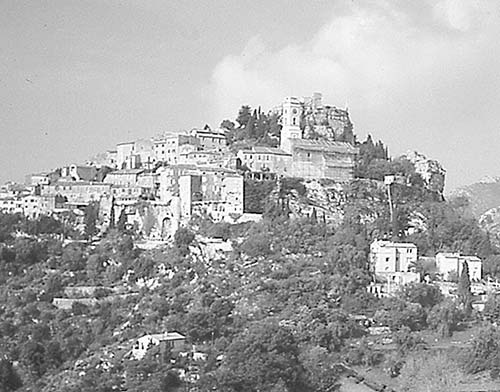
There are two Ezes: Eze-le-Village (the spectacular hill town on the Middle Corniche) and Eze-Bord-de-Mer (a modern beach resort far below the “village” of Eze). Parking in Eze-le-Village will be a headache in 2019 as construction is under way for a new underground garage.
From Nice and upper Villefranche-sur-Mer, buses #82 and #112 together provide about hourly service to Eze-le-Village (only #82 runs on Sun, 30 minutes from Nice).
From Nice, Villefranche-sur-Mer, or Monaco, you can also take the train or the Nice-Monaco bus (#100) to Eze-Bord-de-Mer, getting off at the Gare d’Eze stop. From there, take the infrequent #83 shuttle bus straight up to Eze-le-Village (8/day, daily about 9:00-18:00, schedule posted at stop, 15 minutes). Those coming from Villefranche-sur-Mer can also take buses #81 or #100 and transfer to bus #83 at the Plage Beaulieu stop in Beaulieu-sur-Mer.
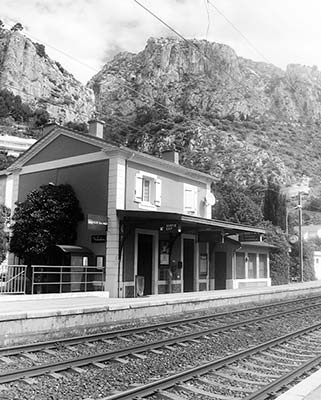
To connect Eze-le-Village directly with Monte Carlo in Monaco, take bus #112 (6/day Mon-Sat, none on Sun, 20 minutes).
A taxi between the two Ezes or from Eze-le-Village to La Turbie will run you about €30; allow €65 to Nice’s port (mobile 06 09 84 17 84 or 06 18 44 47 93).
Tourist Information: The helpful TI is adjacent to Eze-le-Village’s main parking lot, just below the town’s entry. Ask here for bus schedules. Call at least a week in advance to arrange a €12, one-hour English-language tour of the village that includes its gardens (TI open daily 9:00-18:00, July-Aug until 19:00, Nov-March until 16:00 and closed Sun, Place de Gaulle, tel. 04 93 41 26 00, www.eze-tourisme.com).
Helpful Hints: The stop for buses to Nice is across the road by the Avia gas station, and the stops for buses to Eze-Bord-de-Mer and Monaco are on the village side of the main road, near the Casino grocery. Public WCs are just behind the TI and in the village behind the church. For food, there’s a handy Casino grocery at the foot of the village by the bus stop (daily 8:00-19:30) and a sensational picnic spot at the beginning of the trail to Eze-Bord-de-Mer. Or try $ Le Cactus near the entry to the old town (daily until about 19:30, tel. 04 93 41 19 02). For a splurge, dine at $$$$ Château de la Chèvre d’Or (see the walk, next).
This self-guided walk gives you a quick orientation to the village.
• From the TI, hike uphill into the town. You’ll come to an exclusive hotel gate and the start of a steep trail down to the beach, marked Eze/Mer. For a panoramic view and an ideal picnic perch, side-trip 90 steps down this path (for details, see “Hike to Eze-Bord-de-Mer,” later). Continuing up into the village, find the steps immediately after the ritzy hotel gate and climb to...
Place du Centenaire: In this square, a stone plaque in the flower bed (behind the candy stand) celebrates the 100th anniversary of the 1860 plebiscite, the time when all 133 Eze residents voted to leave the Italian Duchy of Savoy and join France. A town map here helps you get oriented.
• Now pass through the once-formidable town gate and climb into the 14th-century village.
As you walk, stop to read the information plaques (in English) and contemplate the change this village has witnessed in the last 90 years. Eze-le-Village was off any traveler’s radar until well after World War II (running water was made available only in the 1930s), yet today hotel rooms outnumber local residents two to one (66 to 33).
• Wandering the narrow lanes, consider a detour to Château de la Chèvre d’Or for its elegant bar-lounge and sprawling view terrace (high prices but high views). Continue on, following signs to the...
Château Eza: This was the winter getaway of the Swedish royal family from 1923 until 1953; today it’s a 15-room hotel. The château’s tearoom (Salon de Thé), on a cliff overlooking the jagged Riviera and sea, offers another scenic coffee or beer break—for a price. The view terrace is also home to an expensive-but-excellent $$$$ restaurant (open daily, tel. 04 93 41 12 24).
• Backtrack a bit and continue uphill (follow signs to Jardin Exotique). The lane ends at the hilltop castle ruins—now blanketed by the...
Jardin d’Eze: You’ll find this prickly festival of cactus and exotic plants suspended between the sea and sky at the top of Eze-le-Village. Since 1949, the ruins of an old château have been home to 400 different plants 1,400 feet above the sea (€6, usually daily 9:00-19:00, Oct-May until about 16:00, well described in English, tel. 04 93 41 10 30). At the top, you’ll be treated to a commanding 360-degree view, with a helpful table d’orientation. On a clear day (they say...) you can see Corsica. The castle was demolished by Louis XIV in 1706. Louis destroyed castles like this all over Europe (most notably along the Rhine), because he didn’t want to risk having to do battle with their owners at some future date.
• As you descend, follow the pastel bell tower and drop by the...
Eze Church: Though built during Napoleonic times, this church has an uncharacteristic Baroque fanciness—a reminder that 300 years of Savoy rule left the townsfolk with an Italian savoir faire and a sensibility for decor. Notice the pulpit with the arm holding a crucifix, reminding the faithful that Christ died for their sins.
This factory, with its huge tour-bus parking lot, lies on the Middle Corniche, 100 yards below Eze-le-Village. Designed for tour groups, it cranks them through all day long. If you’ve never seen mass tourism in action, this place will open your eyes. (The gravel is littered with the color-coded stickers each tourist wears so that salespeople know which guide gets the kickback.) Drop in for an informative and free tour (2/hour, 15 minutes). You’ll see how the perfume and scented soaps are made before being herded into the gift shop.
Cost and Hours: Daily 8:30-18:30; best Mon-Fri 9:00-11:00 & 14:00-15:30, when people are actually working in the “factory,” tel. 04 93 41 05 05.
A steep trail leaves Eze-le-Village from the foot of the hill-town entry, near the fancy hotel gate (100 yards up from the main road), and descends 1,300 feet to the sea along a no-shade, all-view trail. The trail is easy to follow but uneven in a few sections—allow 45 minutes (good walking shoes are essential; expect to be on all fours in certain sections). Once in Eze-Bord-de-Mer, you can catch a bus or train to all destinations between Nice and Monaco. While walking this trail in the late 1800s, Friedrich Nietzsche was moved to write his unconventionally spiritual novel, Thus Spoke Zarathustra.
High above Monaco, on the Grande Corniche in the overlooked village of La Turbie, lies the ancient Roman “Trophy of the Alps,” one of this region’s most evocative historical sights (with dramatic views over the entire country of Monaco as a bonus). Rising well above all other buildings, this massive monument, worth ▲, commemorates Augustus Caesar’s conquest of the Alps and its 44 hostile tribes. It’s exciting to think that, in a way, Le Trophée des Alpes (also called “Le Trophée d’Auguste” for the emperor who built it) celebrates a victory that kicked off the Pax Romana—joining Gaul and Germania, freeing up the main artery of the Roman Empire, and linking Spain and Italy.
Circumnavigate the hulking structure. Notice how the Romans built a fine stone exterior using 24 massive columns that held together a towering cylinder filled with rubble and coarse concrete. Find the huge inscription on the back side of the monument. Flanked by the vanquished in chains, the towering inscription (one of the longest such inscriptions surviving from ancient times) tells the story: It was erected “by the senate and the people to honor the emperor.”
A guardian will escort you halfway up the monument and give you a detailed explanation in English if you ask. The good little one-room museum shows a model of the monument, a video, and information about its history and reconstruction. There’s also a translation of the dramatic inscription, which lists all the feisty alpine tribes that put up such a fight.
Cost and Hours: €6, €14 combo-ticket with Villa Kérylos, Tue-Sun 9:30-13:00 & 14:30-18:30, off-season 10:00-13:30 & 14:30-17:00, closed Mon year-round, audioguide-€3 but English explanations are posted throughout; tel. 04 93 41 20 84, www.la-turbie.monuments-nationaux.fr.
Getting There: If visiting by car, take the High Corniche to La Turbie, ideally from Eze-le-Village (La Turbie is 10 minutes east of, and above, Eze-le-Village), then look for signs to Le Trophée d’Auguste. Once in La Turbie, drive to the site by turning right in front of the La Régence café. Those coming from farther afield can take the efficient A-8 to the La Turbie exit. To reach Eze-le-Village from La Turbie, follow signs to Nice, and then look for signs to Eze-le-Village.
From Nice, you can get here Monday through Saturday on buses #116 or #T-66 (6/day each from the Vauban tram stop); on Sunday take bus #T-66 (from the Pont St. Michel tram stop). From Monaco, bus #11 connects to La Turbie (8/day Mon-Sat, 5/day Sun, 30 minutes). La Turbie’s bus stop is near the post office (La Poste) on Place Neuve.
Eating in La Turbie: The sweet old village of La Turbie sees almost no tourists, but it has plenty of cafés and restaurants. Your best bet is the welcoming $$ Restaurant La Terrasse, with tables under umbrellas and big views (daily for lunch and dinner, near the post office at the main parking lot, 17 Place Neuve, tel. 04 93 41 21 84). Charming owners Jacques and Helen speak flawless English.
Despite high prices, wall-to-wall daytime tourists, and a Disney-esque atmosphere, Monaco is a Riviera must. Monaco is on the go. Since 1929, cars have raced around the port and in front of the casino in one of the world’s most famous auto races, the Grand Prix de Monaco. The modern breakwater—constructed elsewhere and towed in by sea—enables big cruise ships to dock here, and the district of Fontvieille, reclaimed from the sea, bristles with luxury high-rise condos. But don’t look for anything too deep in this glittering tax haven. Many of its 36,000 residents live here because there’s no income tax—there are only about 6,000 true Monegasques.
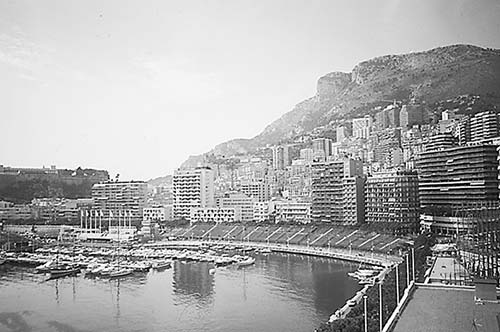
This minuscule principality (0.75 square mile) borders only France and the Mediterranean. The country has always been tiny, but it used to be...less tiny. In an 1860 plebiscite, Monaco lost two-thirds of its territory when the region of Menton voted to join France. To compensate, France suggested that Monaco build a fancy casino and promised to connect it to the world with a road (the Low Corniche) and a train line. This started a high-class tourist boom that has yet to let up.
Although “independent,” Monaco is run as a part of France. A French civil servant appointed by the French president—with the blessing of Monaco’s prince—serves as state minister and manages the place. Monaco’s phone system, electricity, water, and so on, are all French.
The glamorous romance and marriage of the American actress Grace Kelly to Prince Rainier added to Monaco’s fairy-tale mystique. Princess Grace first came to Monaco to star in the 1955 Alfred Hitchcock movie To Catch a Thief, in which she was filmed racing along the Corniches. She married the prince in 1956 and adopted the country, but tragically, the much-loved princess died in 1982 after suffering a stroke while driving on one of those same scenic roads. She was just 52 years old.
The death of Prince Rainier in 2005 ended his 56-year-long enlightened reign. Today, Monaco is ruled by Prince Albert Alexandre Louis Pierre, Marquis of Baux—son of Prince Rainier and Princess Grace. Monaco is a special place: There are more people in Monaco’s philharmonic orchestra (about 100) than in its army (about 80). Yet the princedom is well-guarded, with police and cameras on every corner. (They say you could win a million dollars at the casino and walk to the train station in the wee hours without a worry.) Stamps are printed in small quantities and increase in value almost as soon as they’re available. And collectors snapped up the rare Monaco versions of euro coins (with Prince Albert’s portrait) so quickly that many Monegasques have never even seen one.
The principality of Monaco has three tourist areas: Monaco-Ville, Monte Carlo, and La Condamine. Monaco-Ville fills the rock high above everything else and is referred to by locals as Le Rocher (“The Rock”). This is the oldest part of Monaco, home to the Prince’s Palace and all the key sights except the casino. Monte Carlo is the area around the casino. La Condamine is the port, which lies between Monaco-Ville and Monte Carlo. From here it’s a 20-minute walk up to the Prince’s Palace or to the casino, or a few minutes by frequent bus to either (see “Getting Around Monaco,” later).
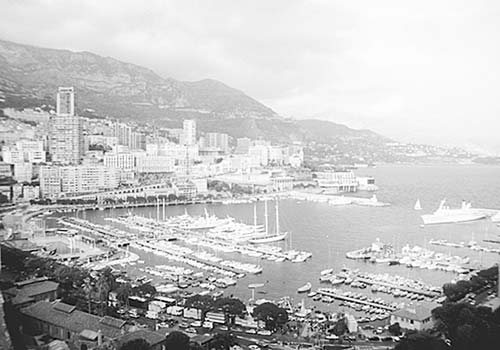
The main TI is at the top of the park above the casino (Mon-Sat 9:00-19:00, Sun 11:00-13:00, 2 Boulevard des Moulins, tel. 00-377/92 16 61 16 or 00-377/92 16 61 66, www.visitmonaco.com). Another TI is at the train station (daily mid-June-mid-Sept 9:00-18:00, off-season Tue-Sat until 17:00, closed 12:30-14:00, closed Sun-Mon).
By Bus #100 from Nice and Villefranche-sur-Mer: Bus riders need to pay attention to the monitor showing the next stop. Cap d’Ail is the town before Monaco, so be on the lookout after that (the last stop before Monaco is called “Cimetière”). You’ll enter Monaco through the modern cityscape of high-rises in the Fontvieille district. When you see the rocky outcrop of old Monaco, be ready to get off.
There are three stops in Monaco. In order from Nice, they are Place d’Armes (at the base of Monaco-Ville), Princesse Antoinette (on the port), and Monte Carlo-Casino (in front of the TI on Boulevard des Moulins).
Most riders will get off at Place d’Armes to visit Monaco-Ville first. Use the crosswalk in front of the tunnel, then keep right and find bus stops #1 and #2 and the ramp to the palace. Casino-first types wait for the Monte Carlo-Casino stop. There’s no reason to exit at the port stop.
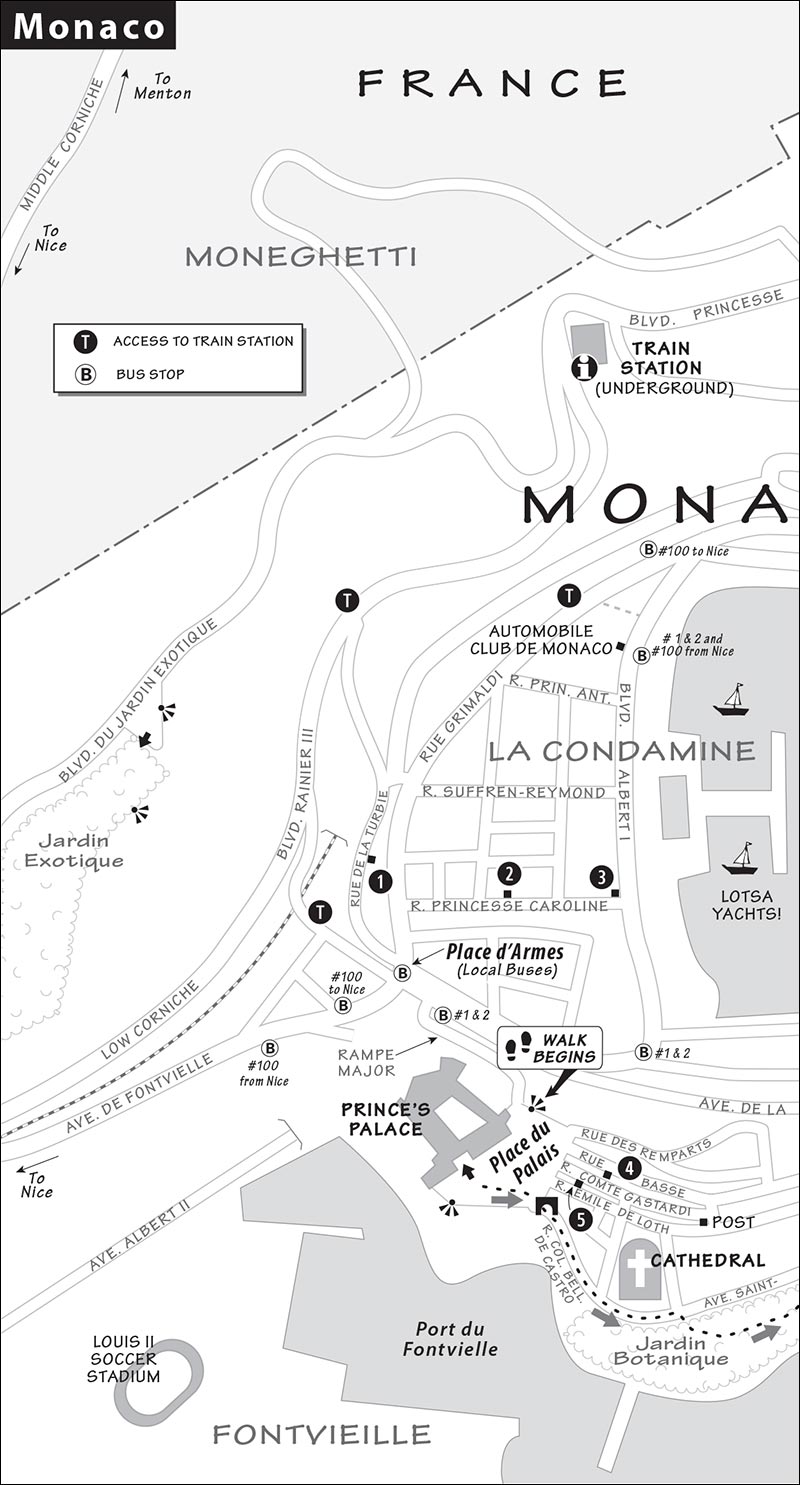

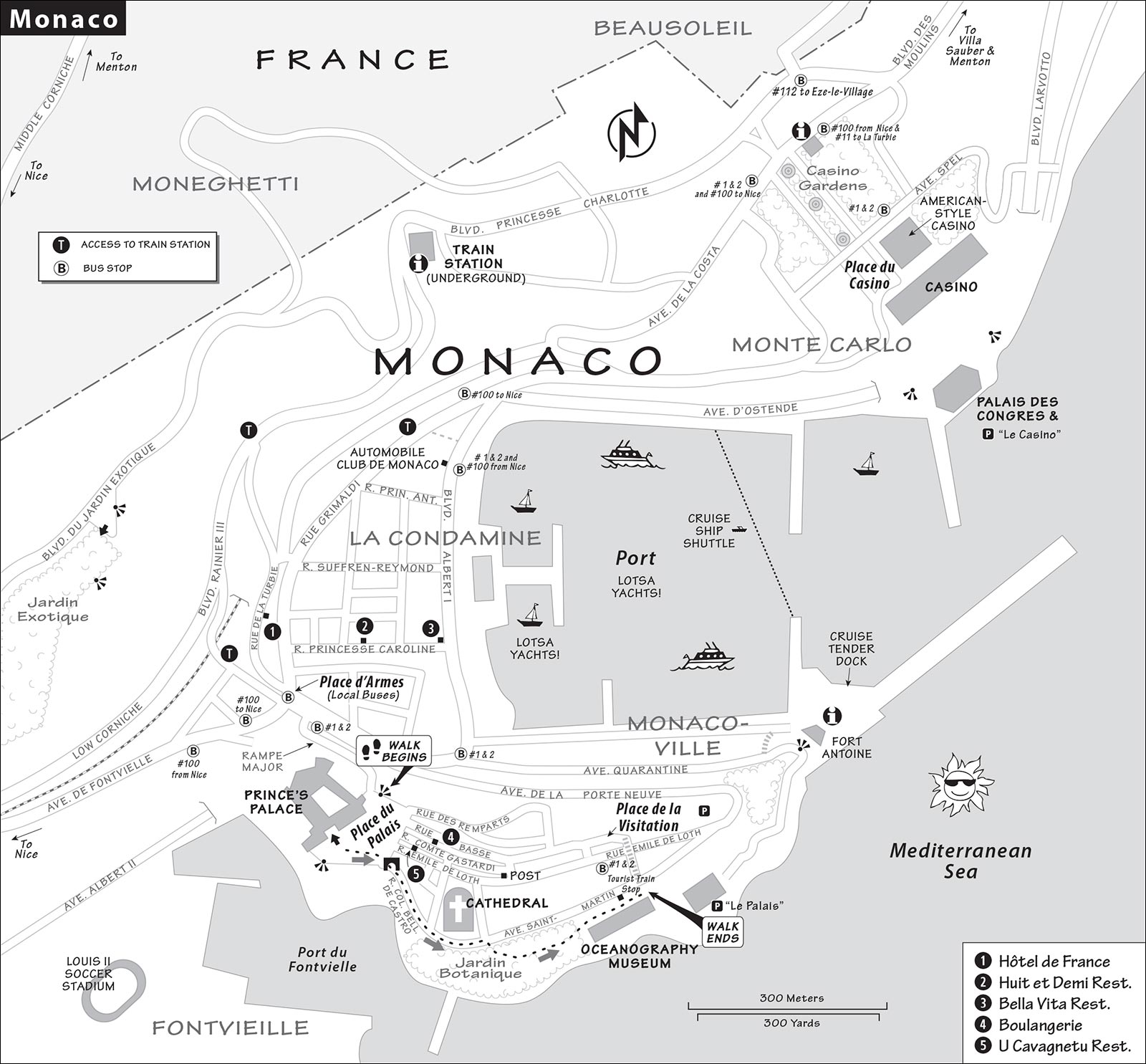
By Train from Nice: The long, entirely underground train station is in the center of Monaco. From here, it’s a 15-minute walk to the casino or the port, and about 15 minutes to the base of the palace (and frequent local buses). The station has no baggage storage.
The TI, train-ticket windows, and WCs are up the escalator at the Italy end of the station. There are three exits from the train platform level (one at each end and one in the middle).
To reach Monaco-Ville and the palace, take the exit at the Nice end of the tracks (signed Sortie Fontvieille/Le Rocher), which leads through a long tunnel and along a pedestrian plaza to the base of Monaco-Ville at Place d’Armes (turn left when you reach the busy street). From here, it’s about a 15-minute hike up to the palace, or five minutes by bus (#1 or #2) plus a short walk.
To reach Monaco’s port and the casino, take the middle exit, following Sortie Port Hercule signs down the steps and escalators, and then Accès Port signs until you pop out at the port, where you’ll see the stop for buses #1 and #2 across the busy street. From here, it’s a 20-minute walk to the casino (up Avenue d’Ostende to your left), or a short trip via bus #1 or #2.
If you plan to return to Nice by train in the evening (after ticket windows close), buy your return tickets on arrival or use the ticket machines (about €4 in coins or use a credit card with a chip).
By Car: Follow Centre-Ville signs into Monaco (warning: traffic can be heavy), then watch for the signs to parking garages at Le Casino (for Monte Carlo) or Le Palais (for Monaco-Ville). You’ll pay about €12 for four hours.
By Cruise Ship: See “Monaco Connections,” near the end of this section.
Grand Prix Prep: If you come anytime from early April through May, you’ll encounter construction detours as the country prepares for its largest event of the year, the Grand Prix de Monaco.
Combo-Tickets: If you plan to see both of Monaco’s big sights (Prince’s Palace and Oceanography Museum), buy the €20.50 combo-ticket. Another combo-ticket includes the Prince’s private car collection in Fontvieille (not covered in this book).
Changing of the Guard: This popular event takes place daily (in good weather) at 11:55 at the Prince’s Palace. Arrive by 11:30 to get a good viewing spot.
Loop Trip from Nice to Monaco: From Nice, you can get to Monaco by bus or train, then take a bus from Monaco to Eze-le-Village or La Turbie, and return to Nice from there by bus. For bus numbers, frequencies, and stop locations, see “Monaco Connections,” near the end of this section.
Evening Events: Monaco’s cultural highlights include its Philharmonic Orchestra (tel. 00-377/98 06 28 28, www.opmc.mc) and Monte Carlo Ballet (tel. 00-377/99 99 30 00, www.balletsdemontecarlo.com).
Passport Stamp: For an official memento of your visit, get your passport stamped at the TI.
Post Office: The handiest post office for local stamps is in Monaco-Ville (described on my self-guided walk; Mon-Fri 8:00-19:00, Sat until 13:00, closed Sun).
By Local Bus: Buses #1 and #2 link all areas with frequent service (10/hour, fewer on Sun, buses run until 21:00). If you pay the driver, a single ticket is €2, 6 tickets €11, and a day pass €5.50; save by using red curbside machines, where you get 12 tickets for €11. You can split a 6- or 12-ride ticket with your travel partners. Bus tickets are good for a free transfer if used within 30 minutes.
For a cheap and scenic loop ride through Monaco, ride bus #2 from one end to the other and back (25 minutes each way). You’ll need two tickets and must get off the bus at the last stop and then get on again.
By Open Bus Tour: You could pay €23 for a hop-on, hop-off open-deck bus tour that makes 12 stops in Monaco, but I wouldn’t. If you want a scenic tour of the principality that includes its best views, take local bus #2 for much less (see above).
By Tourist Train: An efficient way to enjoy a scenic blitz tour, Monaco Tours tourist trains begin at the Oceanography Museum and pass by the port, casino, and palace (€10, 2/hour, 30 minutes, recorded English commentary).
By Taxi: If you’ve lost all track of time at the casino, you can call the 24-hour taxi service (tel. 00-377/93 15 01 01)...assuming you still have enough money to pay for the cab home.
All of Monaco’s major sights (except the casino) are in Monaco-Ville, packed within a few Disneyesque blocks. This self-guided walk connects these sights in a tight little loop, starting from the palace square.
• To get from anywhere in Monaco to the palace square (Monaco-Ville’s sightseeing center and home of the palace), take bus #1 or #2 to the end of the line at Place de la Visitation. Turn right as you step off the bus and walk five minutes down Rue Emile de Loth. You’ll pass the post office, a worthwhile stop for its collection of valuable Monegasque stamps.
This square is the best place to get oriented to Monaco. Facing the palace, walk to the right and look out over the city (er...principality). This rock gave birth to the little pastel Hong Kong look-alike in 1215, and it’s managed to remain an independent country for most of its 800 years. Looking beyond the glitzy port, notice the faded green dome roof: It belongs to the casino that put Monaco on the map in the 1800s. The casino was located away from Monaco-Ville because Prince Charles III (r. 1856-1889) wanted to shield his people from low-life gamblers.
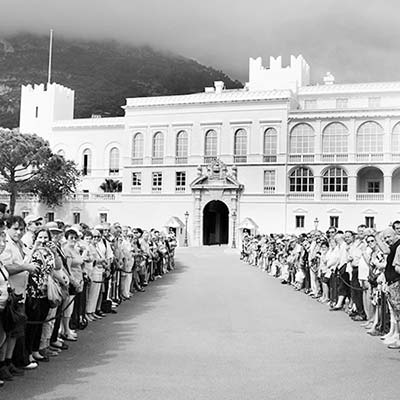
The modern buildings just past the casino mark the eastern limit of Monaco. The famous Grand Prix runs along the port and then up the ramp to the casino (at top speeds of 180 mph). Italy is so close, you can almost smell the pesto. Just beyond the casino is France again (it flanks Monaco on both sides)—you could walk one-way from France to France, passing through Monaco, in about 60 minutes.
The odd statue of a woman with a fishing net is dedicated to the glorious reign of Prince Albert I (1889-1922). The son of Charles III (who built the casino), Albert I was a true Renaissance Man. He had a Jacques Cousteau-like fascination with the sea (and built Monaco’s famous aquarium, the Oceanography Museum) and was a determined pacifist who made many attempts to dissuade Germany’s Kaiser Wilhelm II from becoming involved in World War I.
Escape the crowds for a moment with a short detour up the street, keeping the view on your left. Gawk at the houses lining the street and imagine waking up to that view every day.
• Head toward the palace, passing electric car chargers (Prince Albert is an environmentalist), and find a statue of a monk grasping a sword.
Meet François Grimaldi, a renegade sword-carrying Italian dressed as a monk, who captured Monaco in 1297 and began the dynasty that still rules the principality. Prince Albert is his great-great-great...grandson, which gives Monaco’s royal family the distinction of being the longest-lasting dynasty in Europe.
Now walk to the...
A medieval castle once sat where the palace is today. Its strategic setting has had a lot to do with Monaco’s ability to resist attackers. Today, Prince Albert and his wife live in the palace, while poor Princesses Stephanie and Caroline live down the street. The palace guards protect the prince 24/7 and still stage a Changing of the Guard ceremony with all the pageantry of an important nation (daily at 11:55 in good weather, fun to watch but jam-packed, arrive by 11:30). An audioguide takes you through part of the prince’s lavish palace in 30 minutes. The rooms are well-furnished and impressive, but interesting only if you haven’t seen a château lately. Even if you don’t tour the palace, get close enough to check out the photos of the last three princes in the palace entry.
Cost and Hours: €8, includes audioguide, €20.50 combo-ticket includes Oceanography Museum; hours vary but generally daily 10:00-18:00, July-Aug until 19:00, closed Nov-March; buy ticket at the Billeterie at the souvenir stand 75 yards opposite the palace entrance; tel. 00-377/93 25 18 31, www.palais.mc.
• Head to the west end of the palace square. Below the cannonballs is the district known as...
Monaco’s newest, reclaimed-from-the-sea area has seen much of the principality’s post-WWII growth (residential and commercial—notice the lushly planted building tops). Prince Rainier continued—some say, was obsessed with—Monaco’s economic growth, creating landfills (topped with apartments, such as in Fontvieille), flashy ports, more beaches, a big sports stadium marked by tall arches, and a rail station. (An ambitious new landfill project is in the works and would add still more prime real estate to Monaco’s portfolio.) Today, thanks to Prince Rainier’s past efforts, tiny Monaco is a member of the United Nations. (If you have kids with you, check out the nifty play area just below.)
• With your back to the palace, leave the square through the arch at the far right (onto Rue Colonel Bellando de Castro) and find the...
The somber but beautifully lit cathedral, rebuilt in 1878, shows that Monaco cared for more than just its new casino. It’s where centuries of Grimaldis are buried, and where Princess Grace and Prince Rainier were married. Inside, circle slowly behind the altar (counterclockwise). The second tomb is that of Albert I, who did much to put Monaco on the world stage. The second-to-last tomb—inscribed “Gratia Patricia, MCMLXXXII” and displaying the 1956 wedding photo of Princess Grace and Prince Rainier—is where the princess was buried in 1982. Prince Rainier’s tomb lies next to hers (cathedral open daily 8:30-19:15).
• Leave the cathedral and dip into the immaculately maintained Jardin Botanique, with more fine views. In the gardens, turn left. Eventually you’ll find the impressive building housing the...
Prince Albert I had this cliff-hanging museum built in 1910 as a monument to his enthusiasm for things from the sea. The museum’s aquarium, which Jacques Cousteau captained for 32 years, has 2,000 different specimens, representing 250 species. You’ll find Mediterranean fish and colorful tropical species (all well described in English). Rotating exhibits occupy the entry floor. Upstairs, the fancy Albert I Hall is filled with ship models, whale skeletons, oceanographic instruments and tools, and scenes of Albert and his beachcombers hard at work—but sadly, only scant English information. Don’t miss the elevator to the rooftop terrace view café.
Cost and Hours: €11-16, kids-€7-12 (price depends on season), €20.50 combo-ticket includes Prince’s Palace; daily 10:00-19:00, longer hours July-Aug, Oct-March until 18:00; down the steps from Monaco-Ville bus stop, at the opposite end of Monaco-Ville from the palace; tel. 00-377/93 15 36 00, www.oceano.mc.
• The red-brick steps across from the Oceanography Museum lead up to stops for buses #1 and #2, both of which run to the port, the casino, and the train station. To walk back to the palace and through the old city, turn left at the top of the brick steps. If you’re into stamps, walk down Rue Emile de Loth to find the post office, where philatelists and postcard writers with panache can buy—or just gaze in awe at—the impressive collection of Monegasque stamps.
This cliffside municipal garden, located above Monaco-Ville, has eye-popping views from France to Italy. It’s home to more than a thousand species of cacti (some giant) and other succulent plants, but worth the entry only for view-loving botanists (some posted English explanations provided). Your ticket includes entry to a skippable natural cave, an anthropological museum, and a view snack bar/café. You can get similar views over Monaco for free from behind the souvenir stand at the Jardin’s bus stop; or, for even grander vistas, cross the street and hike toward La Turbie.
Cost and Hours: €7.20, daily 9:00-19:00, Oct-April until about dusk, take bus #2 from any stop in Monaco or take the elevator up from the Nice end of the train station and follow signs, tel. 00-377/93 15 29 80, www.jardin-exotique.com.
Monte Carlo, which means “Charles’ Hill” in Spanish, is named for the prince who presided over Monaco’s 19th-century makeover. In the mid-1800s, olive groves stood here. Then, with the construction of casino and spas, and easy road and train access (thanks to France), one of Europe’s poorest countries was on the Grand Tour map—the place for the vacationing aristocracy to play. Today, Monaco has the world’s highest per-capita income.
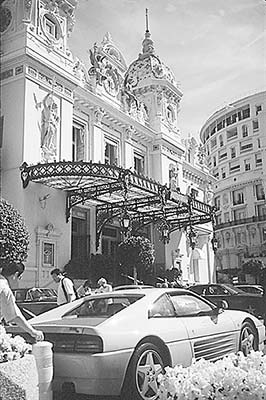
The Monte Carlo casino is intended to make you feel comfortable while losing your retirement nest egg. Charles Garnier designed the place (with an opera house inside) in 1878, in part to thank the prince for his financial help in completing Paris’ Opéra Garnier (which the architect also designed). The central doors provide access to slot machines, gaming rooms, and the opera house. The gaming rooms occupy the left wing of the building. Cruise ship visitors can jam the entry during afternoons.
The odd bubble-like structures that line the parkway above the casino are temporary, and house high-end boutiques relocated from nearby for a long-term construction project. Ignore the tacky American-style casino that hides behind the outdoor café across from the hotel.
Cost and Hours: Tightwads can view the atrium entry, classy bar/café, and slot-machine room for free; daily 9:00-late. Touring the casino costs €17 (€12 off-season); daily 9:00-12:15; you’ll see the atrium area and inner-sanctum gaming rooms with an audioguide, take photos, and have your run of the joint. Gamblers pay €10; daily 14:00 until the wee hours, must be 18 and show ID; no shorts, T-shirts, hoodies, tennis shoes, or torn jeans. Whether you gamble or not, expect lines at the entrance from May through September; tel. 00-377/92 16 20 00, www.montecarlocasinos.com.
Visiting the Casino: Enter through sumptuous atrium. This is the lobby for the 520-seat opera house (open Nov-April only for performances). A model of the opera house is at the far-right side of the room, near the bar-café. The first gambling rooms (Salle Renaissance, Salon de l’Europe, and Salle des Amériques) offer European and English roulette, plus Trente et Quarante, Punto Banco—a version of baccarat—and slot machines. The more glamorous game rooms (Salons Touzet, Salle Medecin, and Terrasse Salle Blanche) have those same games and Ultimate Texas Hold ’em poker, but you play against the cashier with higher stakes.
The park behind the casino is a peaceful place with a good view of the building’s rear facade and of Monaco-Ville.
Eating: The casino has two dining options. The $$$$ Train Bleu restaurant is for deep pockets for whom price is no object and elegance is everything. $$$ Le Salon Rose offers brasserie food—big salads and pasta dishes in a classy setting. If you paid to tour the casino or to gamble, show your ticket for a discount.
Take the Money and Run: The stop for buses returning to Nice and Villefranche-sur-Mer, and for local buses #1 and #2, is on Avenue de la Costa, at the top of the park above the casino (at the small shopping mall; for location, see the “Monaco” map). To reach the train station from the casino, take bus #1 or #2 from this stop, or find Boulevard Princesse Charlotte (parallels Avenue de la Costa one block above) and walk 15 minutes.
Sleeping: Centrally located in Monaco-Ville, $$ Hôtel de France** is comfortable, well run by friendly Sylvie and Christoph, and reasonably priced—for Monaco (includes breakfast, air-con, no elevator; exit west from train station, 10-minute walk to 6 Rue de la Turbie, tel. 00-377/93 30 24 64, www.hoteldefrance.mc, hoteldefrance@monaco.mc).
Eating on the Port: Several cafés serve basic, inexpensive fare (day and night) on the port. Troll the places that line the flowery and traffic-free Rue Princesse Caroline between Rue Grimaldi and the port. $$$ Huit et Demi is a reliable choice, with a white-tablecloth-meets-director’s-chair ambience and good outdoor seating (closed Sun, 7 Rue Princesse Caroline, tel. 00-377/93 50 97 02). A few blocks below, $$ Bella Vita—an easygoing place for salads, Italian fare, and classic French dishes—has a large terrace and modern interior (daily, serves nonstop from morning to late, 21 Rue Princesse Caroline, tel. 00-377/93 50 42 02).
Eating in Monaco-Ville: You’ll find sandwiches—including the massive pan bagnat, basically salade niçoise on country bread—and quiche at the yellow-bannered $ Boulangerie (daily until 19:00, near Place du Palais at 8 Rue Basse). At $$ U Cavagnetu, just a block from Albert’s palace, you’ll dine cheaply on specialties from Monaco—pizza and such (daily, serves nonstop 11:00-23:00, 14 Rue Comte Félix Gastaldi, tel. 00-377/97 98 20 40). Monaco-Ville has other pizzerias, crêperies, and sandwich stands, but the neighborhood is dead at night.
For a comparison of train and bus connections, see the “Public Transportation in the French Riviera” sidebar on here. Most trains heading west will stop in Villefranche-sur-Mer, Nice, and Antibes (ask). The last train leaves Monaco for Villefranche-sur-Mer and Nice at about 23:30.
From Monaco by Train to: Villefranche-sur-Mer, Nice, Antibes, or Cannes (2/hour).
Frequent bus #100, which runs along the Low Corniche back to Nice (1 hour), and Villefranche-sur–Mer (40 minutes) is often slammed. For a better chance of securing a seat, board at the stop near the TI on Avenue de la Costa (see the “Monaco” map, earlier) rather than the stop near Place d’Armes. The last bus leaves Monaco for Nice at about 21:30. In the other direction bus #100 goes to Menton (30 minutes). For bus details, including tickets, routes, frequencies, and travel times, see here.
Bus #112, which goes along the scenic Middle Corniche to Eze-le-Village then on to Nice (6/day Mon-Sat, none on Sun, 20 minutes to Eze), departs Monaco from Place de la Crémaillère, one block above the main TI and casino park. Walk up Rue Iris with Barclays Bank to your left, curve right, and find the bus shelter across the street at the green La Crémaillère café.
Bus #11 to La Turbie (9/day Mon-Sat, 5/day Sun, 30 minutes) stops in front of the TI (same side of street).
Bus #110 express takes the freeway from the Place d’Armes stop to Nice Airport (2/hour, 50 minutes, €22).
Cruise ships tender passengers to the end of Monaco’s yacht harbor, a short walk from downtown. It’s a long walk or a short bus ride to most sights in town. To reach other towns, such as Villefranche-sur-Mer or Nice, you can take public transportation. To summon a taxi (assuming none are waiting when you disembark), look for the gray taxi call box near the tender dock—just press the button and wait for your cab to arrive.
Getting into Town: To reach Monaco-Ville, which towers high over the cruise terminal, you can either hike steeply and scenically up to the top of the hill, or walk to Place d’Armes and hop on bus #1 or #2, which will take you up sweat-free. It’s a 15-minute, level walk to the bus stop from the port: Cross Boulevard Albert I, follow green Gare S.N.C.F./Ferroviare signs, and take the public elevator to Place d’Armes.
The ritzy skyscraper zone of Monte Carlo is across the harbor from the tender dock, about a 25-minute walk. You can also ride the little electric “bateau bus” shuttle boat across the mouth of the harbor (works with a bus ticket). To reach the upper part of Monte Carlo—with the TI and handy bus stops (including for Eze-le-Village and La Turbie)—catch bus #1 or #2 at the top of the yacht harbor, along Boulevard Albert I.
Getting to Sights Beyond Monaco: Monaco is connected to most nearby sights by both train and bus. See the “Arrival in Monaco” section, earlier, as well as the bus and train connection information in this section for details.
The train station is about a 20-minute walk from the tender harbor—first walk to Place d’Armes (directions earlier under “Getting into Town”), then follow Rue Grimaldi to find stairs and an elevator to the station. For buses, see earlier for bus stop locations and frequencies. If taking bus #112 to Eze-le-Village or bus #11 to La Turbie, first ride bus #1 or #2 to the TI and casino, then follow the directions above.
Antibes has a down-to-earth, easygoing ambience. Its old town is a warren of narrow streets and red-tile roofs rising above the blue Med, protected by twin medieval towers and wrapped in extensive ramparts. Visitors making the short trip from Nice can browse Europe’s biggest yacht harbor, snooze on a sandy beach, loiter through an enjoyable old town, and hike along a sea-swept trail. The town’s cultural claim to fame, the Picasso Museum (closed on Mondays), shows off its appealing collection in a fine old building.
Though much smaller than Nice, Antibes has a history that dates back just as far. Both towns were founded by Greek traders in the fifth century BC. To the Greeks, Antibes was “Antipolis”—the town (polis) opposite (anti) Nice. For the next several centuries, Antibes remained in the shadow of its neighbor. By the turn of the 20th century, the town was a military base—so the rich and famous partied elsewhere. But when the army checked out after World War I, Antibes was “discovered” and enjoyed a particularly roaring ’20s—with the help of party animals like Rudolph Valentino and the rowdy (yet silent) Charlie Chaplin. Fun seekers even invented water-skiing right here in the 1920s.
Antibes’ old town lies between the port and Boulevard Albert I and Avenue Robert Soleau. Place Nationale is the old town’s hub of activity. Stroll above the sea between the old port and Place Albert I (where Boulevard Albert I meets the water). Good beaches lie just beyond Place Albert I, and the walk there leads to fine views. Fun play areas for children are along this path and on Place des Martyrs de la Résistance (close to recommended Hôtel Relais du Postillon).
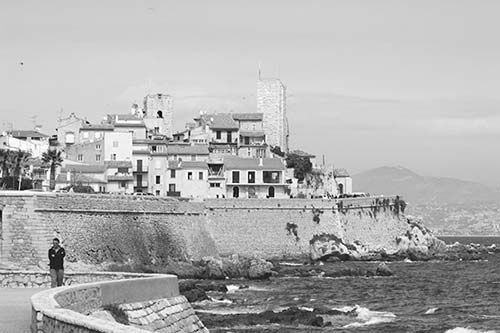
The TI is a few blocks from the train station at 42 Avenue Robert Soleau (July-Aug daily 9:00-19:00; Sept-June Mon-Sat 9:00-12:30 & 14:00-18:00, Sun 9:00-13:00; shorter hours and closed Sun in winter; tel. 04 22 10 60 10, www.antibes-juanlespins.com). Hikers should get the free tourist map of the Sentier Touristique de Tirepoil hike (see “Sights in Antibes,” later).
By Train: Bus #14 runs frequently (except Sun) from below the train station along Avenue de la Libération to the city bus station (gare routière; near several recommended hotels and the old town), and continues to the fine Plage de la Salis, with quick access to the Phare de la Garoupe trail (2/hour, none on Sun, bus stop 100 yards to right as you exit train station). Taxis usually wait in front of the station.
To walk from the station to the port, the old town, and the Picasso Museum (15 minutes), cross the street in front of the station, skirting left of the café, and follow Avenue de la Libération downhill as it bends left. At the end of the street, head to the right along the port. If you walk on the water’s edge, you’ll see the yachts get bigger as you go.
To walk directly to the TI and recommended hotels in the old town, turn right out of the station and walk down Avenue Robert Soleau.
There’s no baggage check in Antibes. The last train back to Nice leaves at about midnight.
By Bus: Antibes has two bus stations—one mostly for regional buses and one only for city buses. Regional buses (#200 & #250) use the bus station behind the train station (called the Pôle d’Echange; take the pedestrian overpass from behind the train station to reach it). Buses to and from Nice stop at the far right (east) end (info office open Mon-Fri 7:00-19:00, Sat 9:00-12:30 & 14:00-17:00, closed Sun). Bus #200 also stops in front of the train station (find the shelter 50 yards to the right as you leave the station) and near Place de Gaulle.
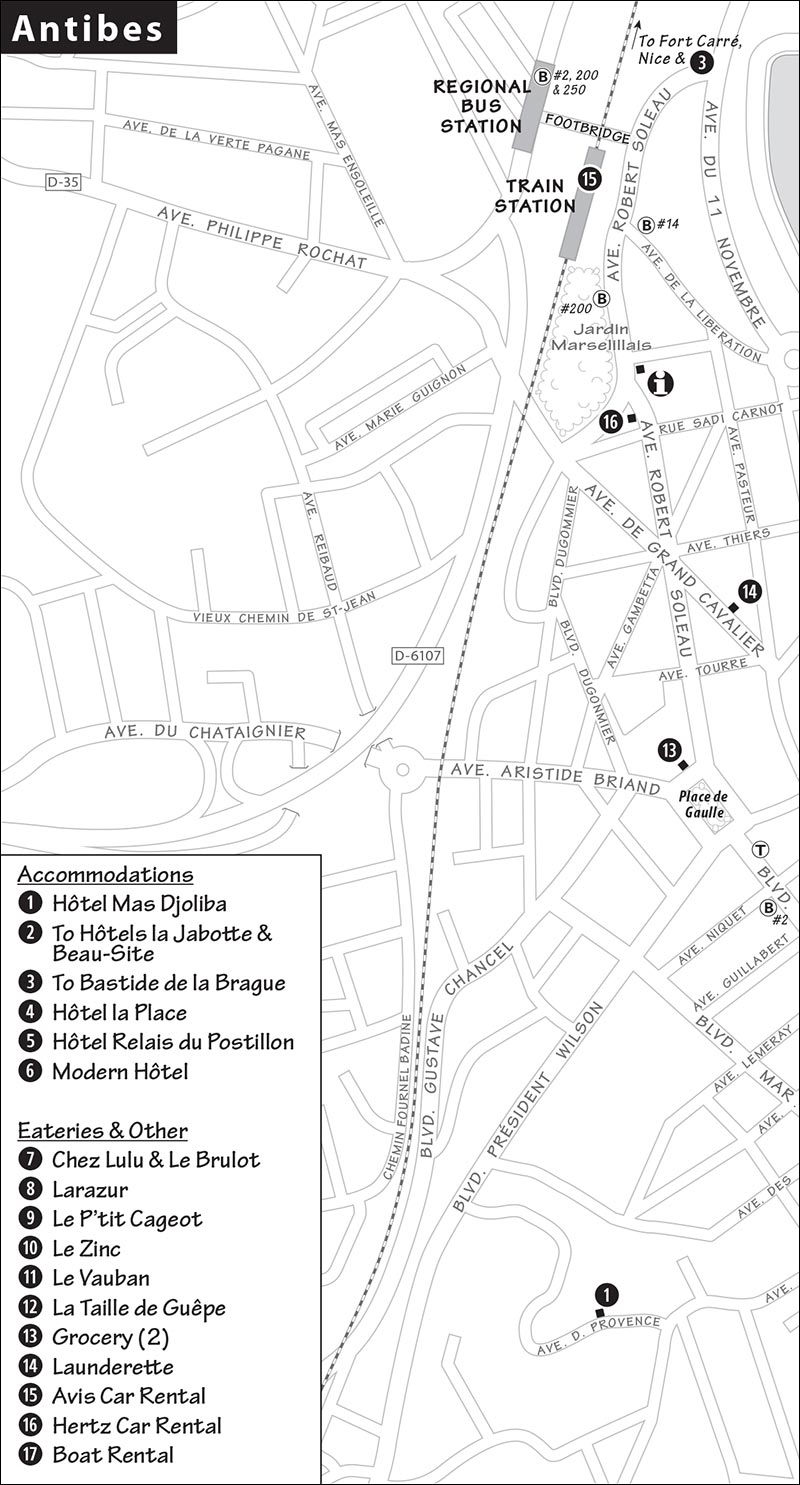
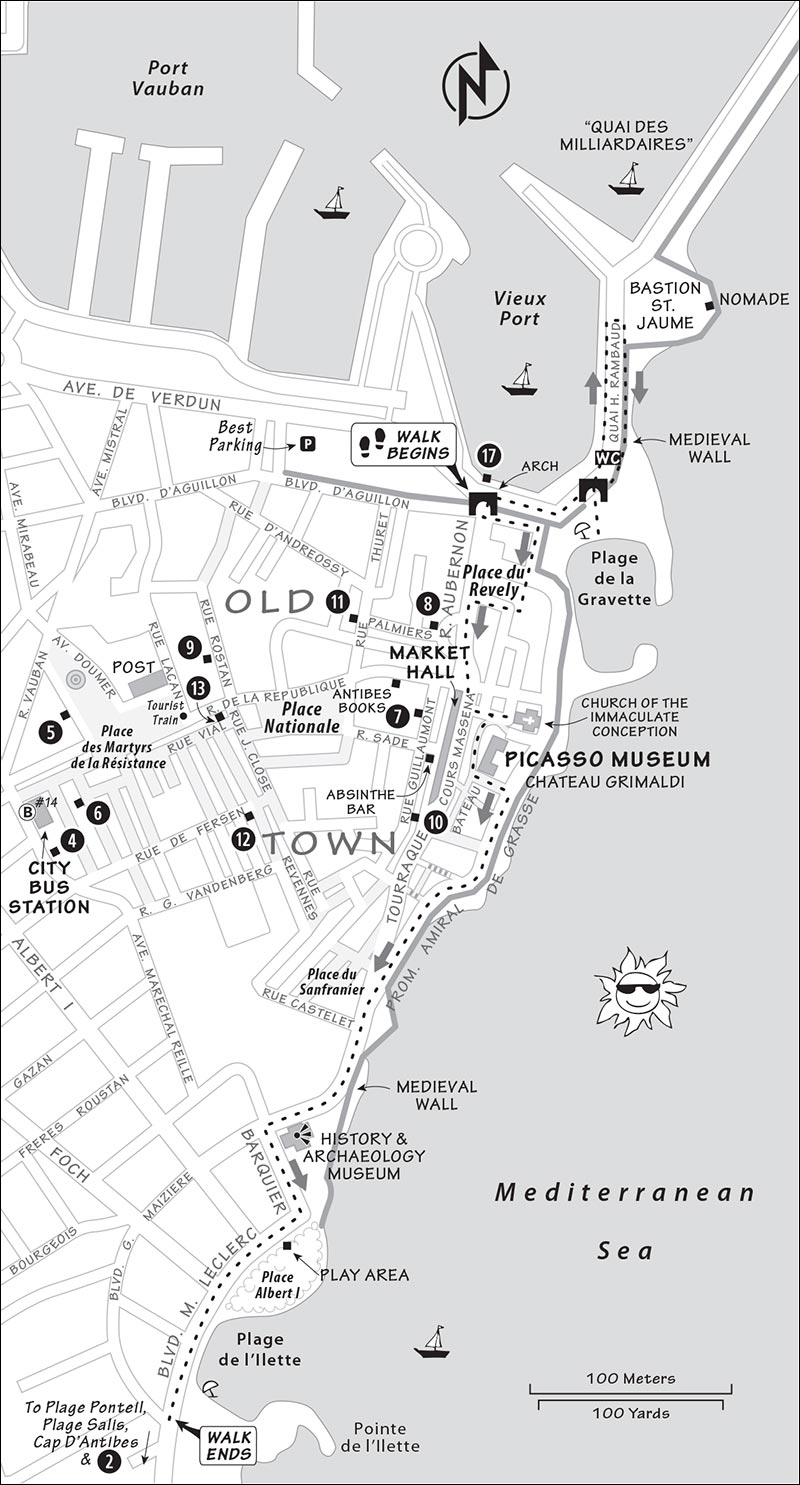
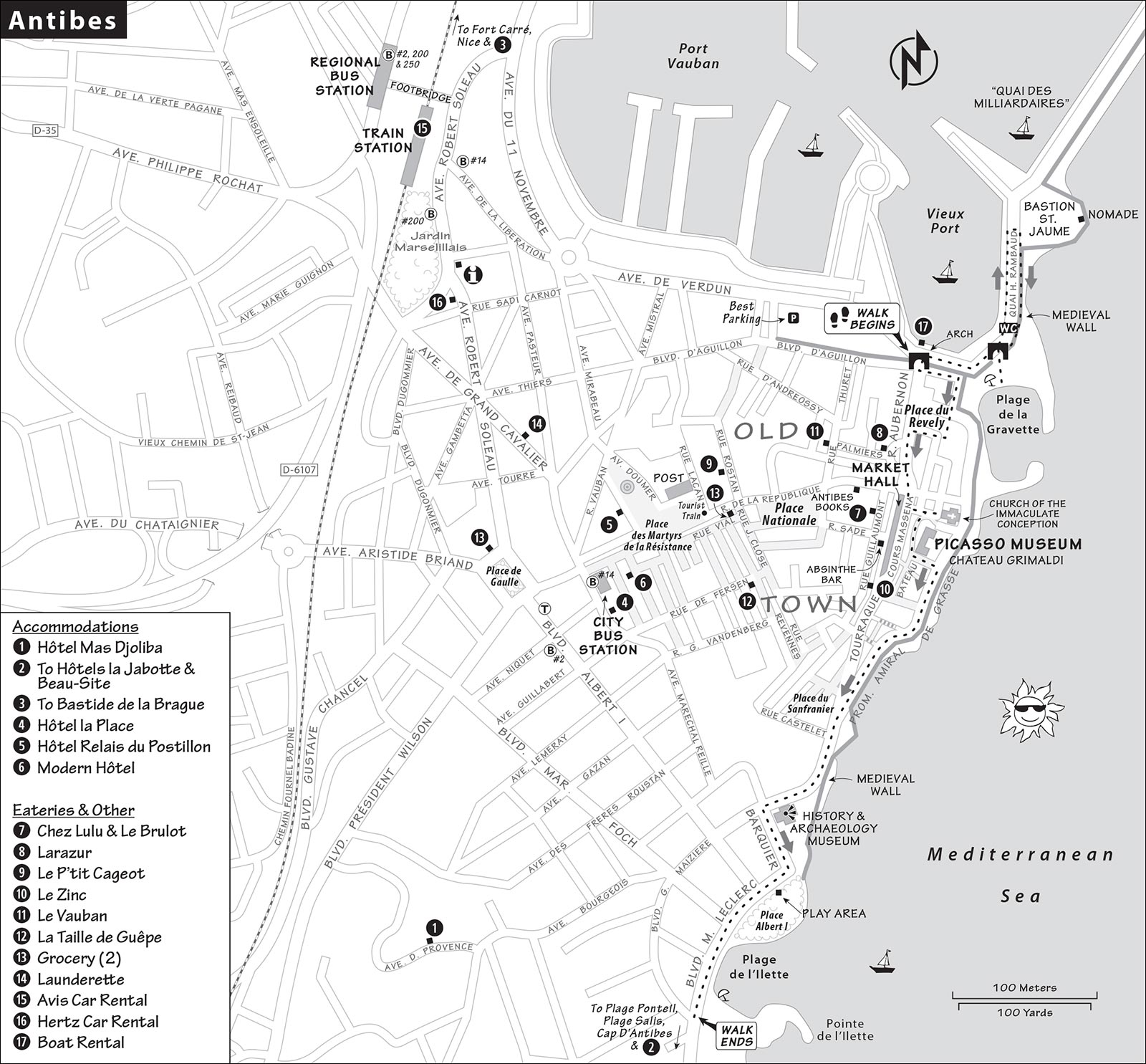
Some city buses use the Pôle d’Echange (like handy bus #2), but all serve the bus station in the old town on Place Guynemer, a block below Place Général de Gaulle (info desk open Mon-Fri 7:30-19:00, Sat 8:30-12:00 & 14:30-17:30, closed Sun, www.envibus.fr).
By Car: Day-trippers follow signs to Centre-Ville, then Port Vauban. The easiest place to park is a convenient but pricey underground parking lot located outside the ramparts near the archway leading into the old town (€10/4 hours, €24/12 hours, just south of Port Vauban—see the “Antibes” map). A free lot is available opposite Fort Carré (north of the port). It’s a 15-minute walk to the old town from here; you can also catch bus #14. Street parking is free Monday through Friday (12:00-14:00 & 19:00-8:00), and all day Saturday and Sunday.
If you’re sleeping in Antibes, follow Centre-Ville signs, then signs to your hotel. The most appealing hotels in Antibes are best by car, and Antibes works well for drivers—compared with Nice, parking is easy, traffic is minimal, and it’s a convenient springboard for the Inland Riviera. Pay parking is available at Antibes’ train station, so drivers can ditch their cars here and day-trip from Antibes by train.
Markets: Antibes’ old-time market hall (Marché Provençal) hosts a vibrant produce market (daily until 13:00, closed Mon Sept-May), and a lively antiques/flea market fills Place Nationale and Place Audiberti, next to the port (Thu and Sat 7:00-18:00). A clothing market winds through the streets around the post office on Rue Lacan (Thu 9:00-18:00).
English Bookstore: With a welcoming vibe, Antibes Books has a good selection of new and used books; check out their many guidebooks—including mine (13 Rue Georges Clemenceau, tel. 04 93 61 96 47, www.antibesbooks.com).
Laundry: There’s a launderette at 19 Avenue du Grand Cavalier (daily 8:00-20:45).
Bike Rental: The TI has a list of places where you can rent bikes (including electric bikes). Bikes are a good way for nondrivers to reach the hikes described later.
Taxi: Tel. 04 93 67 67 67.
Car Rental: The big-name agencies have offices in Antibes (closed Mon-Sat 12:00-14:00 and all day Sun). The most central are Avis (at the train station, tel. 04 93 34 65 15) and Hertz (a few blocks from the train station at 52 Avenue Robert Soleau, tel. 04 92 91 28 00).
Boat Rental: You can motor your own seven-person yacht thanks to Antibes Bateaux Services (€100/half-day, at the small fish market on the port, mobile 06 15 75 44 36, www.antibes-bateaux.com).
Antibes’ buses (Envibus) cost €1 and are handiest for carless travelers wanting access to Cap d’Antibes. Bus #14 links the train station, city bus station, old town, and Plage de la Salis. It also takes you to Fort Carré, where free parking is available. Bus #2 provides access to the best beaches, the path to La Phare de la Garoupe, and the Cap d’Antibes trail. It runs from the Pôle d’Echange bus station (behind the train station) through the city center and down Boulevard Albert I (daily 7:00-19:00, every 40 minutes). Pick up a schedule at the bus station.
This 40-minute self-guided walk will help you get your bearings, and works well day or night.
• Begin at the old port (Vieux Port) at the southern end of Avenue de Verdun. Stand at the port, across from the archway with the clock.
Old Port: Locals claim that this is Europe’s first and biggest pleasure-boat harbor, with 1,600 stalls. That star-shaped stone structure crowning the opposite end of the port is Fort Carré, which protected Antibes from foreigners for more than 500 years.
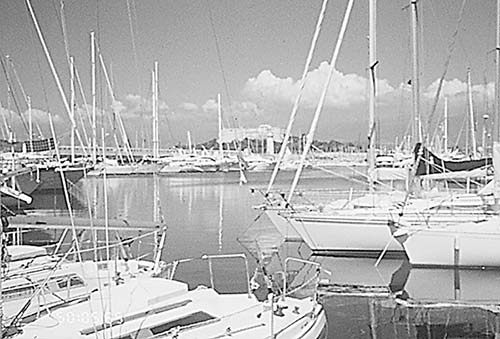
The pathetic remains of a once-hearty fishing fleet are moored in front of you. The Mediterranean is pretty much fished out. Most of the seafood you’ll eat here comes from fish farms or the Atlantic.
• With the port on your left, walk a block past the sorry fleet and duck under the first open arch to the shell-shaped...
Plage de la Gravette: This normally quiet public beach is tucked right in the middle of old Antibes. Walk out onto the paved area. Consider the scale of the ramparts that protected this town. Because Antibes was the last fort before the Italian border, the French king made sure the ramparts were top-notch. The twin towers crowning the old town are the church’s bell tower and the tower topping Château Grimaldi (today’s Picasso Museum). As you face the old town, forested Cap d’Antibes is the point of land in the distance to the left. Is anyone swimming? Locals don’t swim much in July and August because of jellyfish—common now in warmer water. Throughout the Mediterranean, you’ll see red flags warning of dangerous storms or tides. Many beaches now also have white flags with jellyfish symbols warning that swimming might be a stinging experience.
• For a close-up look at the megayachts and a walk along the ramparts, follow this fun detour. Otherwise, skip ahead to the “Old Antibes” directions.
Antibes’ Megayacht Harbor: Take a three-block detour to the north as you leave Plage de la Gravette for a glimpse at the epitome of conspicuous consumption. You’ll walk along the harbor under the ramparts known as Bastion St. Jaume.
You’ll eventually reach a restricted area harboring massive yachts. Climb the ramparts on your right and make your way to the modern white sculpture. Nomade—a man of letters looking pensively out to sea—was created in 2010 by the Spanish artist Jaume Plensa (find the posted English explanations nearby). You can sit in the sculpture and ponder how human communication forms who we are and links all people. Looking north, the Alps make a beautiful backdrop when it’s clear.
Browse the line of huge pleasure craft stern-tied to the pier (which was built in the 1970s with financial aid from mostly Saudi Arabian yacht owners, who wanted a decent place to tie up). Locals call this the Quai des Milliardaires (“billionaire’s dock”).
Old Antibes: Return along the upper walkway then enter Antibes’ old town through the arch under the clock.
• You can walk directly up the main street to get to our next stop, but here’s a more scenic option: Passing through the gate, turn immediately left, and then walk up the steps in the small square. Walk straight through the arch at #14 and into picturesque Place du Revely. Cross Place du Revely to the right, and go down the ramp under several arches, then turn left when you reach the main drag into the old town and Antibes’ market hall, Le Marché Provençal.
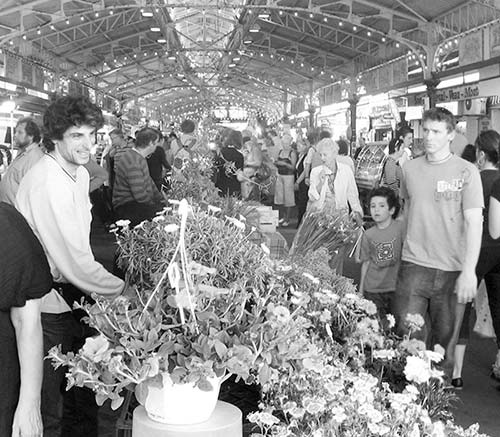
Market Hall: Antibes’ market hall bustles under a 19th-century canopy, with flowers, produce, Provençal products, and beach accessories. The market wears many hats: produce until 13:30 (daily except closed Mon Sept-May), handicrafts most afternoons (Thu-Sun), and fun outdoor dining in the evenings, on Cours Masséna.
On the right (at the corner of Rue Sade), a pretty shop hides an atmospheric absinthe bar in its ninth-century vaulted cellar. You’re welcome to go through the shop (or enter via Rue Sade) and descend to find an amazing collection of absinthe fountains, the oldest dating from the 1860s. The owner will gladly show you his memorabilia. You can even taste the now-legal drink to better understand Picasso’s paintings. On Friday and Saturday nights, the basement is transformed into an absinthe-infused jazz bar lounge with 1920s ambience.
• Double back to the entry of the market and find Rue Christian Chessel leading uphill to the pretty pastel...
Church of the Immaculate Conception: Built on the site of a Greek temple, this is worth a peek inside. A church has stood on this site since the 12th century. This one served as the area’s cathedral until the mid-1200s. The stone bell tower standing in front of the church predates it by 600 years, when it was part of the city’s defenses. Many of those heavy stones were pillaged from Antibes’ Roman monuments.
• Looming above the church on prime real estate is the white-stone...
Château Grimaldi: This site was home to the acropolis of the Greek city of Antipolis and later a Roman fort. Later still, the château was the residence of the Grimaldi family (a branch of which still rules Monaco). Today it houses Antibes’ Picasso Museum. Its proximity to the cathedral symbolized the sometimes too-cozy relationship between society’s two dominant landowning classes: the Church and the nobility. (In 1789, the French Revolution changed all that.)
• After visiting the Picasso Museum (see “Sights in Antibes,” next), work your way through the warren of pretty lanes, then head out to the water, turn right along the ramparts, and find a sweeping sea view. As you walk, you’ll pass a charming neighborhood (La Commune Libre du Safranier) on your right, making a lovely return route. As you wander, look for forested Cap d’Antibes (to the south), crowned by its lighthouse and studded with mansions (a proposed hike here is described later). The Cap was long the refuge of Antibes’ rich and famous, and a favorite haunt of F. Scott Fitzgerald and Ernest Hemingway.
The rampart walk leads to the History and Archaeology Museum. After taking a quick spin through its galleries (see “Sights in Antibes,” next), continue hugging the shore past Place Albert I until you see the smashing views back to old Antibes. Benches and soft sand await. You’re on your own from here—energetic walkers can continue on the trail, which leads to the lighthouse (see “Hikes,” later in this section); others can return to old Antibes and wander around in its peaceful back lanes.
Sitting serenely where the old town meets the sea, this compact three-floor museum offers a manageable collection of Picasso’s paintings, sketches, and ceramics. Picasso lived in this castle for part of 1946, when he cranked out an amazing amount of art (most of the paintings you’ll see are from this short but prolific stretch of his long and varied career). He was elated by the end of World War II, and his works show a celebration of color and a rediscovery of light after France’s long nightmare of war. Picasso was also reenergized by his young and lovely companion, Françoise Gilot (with whom he would father two children). The resulting collection (donated by Picasso) put Antibes on the tourist map.
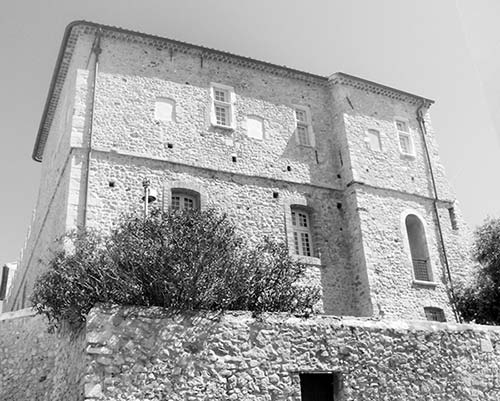
Cost and Hours: €6; Tue-Sun 10:00-18:00, July-Aug Wed and Fri until 20:00, mid-Sept-mid-June closed Tue-Sun 13:00-14:00, closed Mon year-round; tel. 04 92 90 54 20).
Visiting the Museum: The museum’s highlight is on the top floor, where you’ll find the permanent collection of Picasso’s works. Visitors are greeted by a large image of Picasso and a display of photographs of the artist at work and play during his time in Antibes.
The first gallery room (up the small staircase to your left) houses several famous works, including the lively, frolicking, and big-breasted La Joie de Vivre painting (from 1946). This Greek bacchanal sums up the newfound freedom in a just-liberated France and sets the tone for the rest of the collection. You’ll also see the colorless, three-paneled Satyr, Faun and Centaur with Trident and several ceramic creations. As you leave this room don’t miss the adorable (pregnant?) goat.
Throughout, you’ll see both black-and-white and colorful ink sketches that challenge the imagination—these show off Picasso’s skill as a cartoonist and caricaturist. Look also for the cute Basque fishermen (Pecheur attablé) and several Cubist-style nudes (nus couchés), one painted on plywood.
Near the end, don’t miss the wall devoted to Picasso’s ceramic plates. In 1947, inspired by a visit to a ceramics factory in nearby Vallauris, Picasso discovered the joy of this medium. He was smitten by the texture of soft clay and devoted a great deal of time to exploring how to work with it—producing over 2,000 pieces in one year. In the same room, the wall-sized painting Ulysses and the Sirens screams action and anxiety. Lashed to the ship mast, Ulysses survives the temptation of the sirens.
More than 2,000 years ago, Antibes was the center of a thriving maritime culture. It was an important Roman commercial port with aqueducts, theaters, baths, and so on. This museum—the only place to get a sense of the city’s ancient roots—displays Greek, Roman, and Etruscan odds and ends in two simple halls but sadly, no English descriptions. Your visit starts at an 1894 model of Antibes and continues past displays of Roman coins, cups, plates, and scads of amphorae.
Cost and Hours: €3; Tue-Sun 10:00-12:00 & 14:00-18:00, shorter hours off-season, closed Mon year-round, on the water between Picasso Museum and Place Albert I, tel. 04 92 95 85 98.
This impressively situated, mid-16th-century citadel, on the headland overlooking the harbor, protected Antibes from Nice (which until 1860 wasn’t part of France). You can tour this unusual star-shaped fort for the fantastic views over Antibes, but there’s little to see inside (€3, Tue-Sun 10:00-12:30 & 13:30-18:00, until 16:30 off-season, closed Mon year-round).
Good beaches stretch from the south end of Antibes toward Cap d’Antibes. They’re busy but manageable in summer and on weekends, with cheap snack stands and good views of the old town. The closest beach to the old town is at the port (Plage de la Gravette), which seems calm in any season.
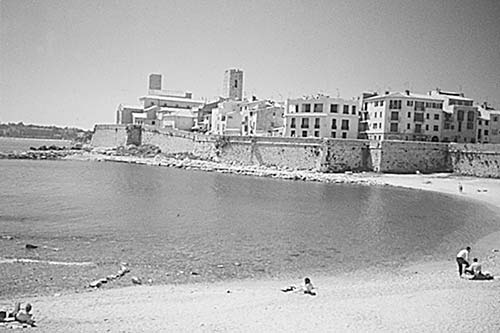
I list two good hikes below. Orient yourself from the seaside rampart walk below the Picasso Museum or from the bottom of Boulevard Albert I (where it meets the beach). That tower on the hill is your destination for the first hike. The longer Cap d’Antibes hike begins over that hill, a few miles farther away. The two hikes are easy to combine by bus, bike, or car.
The territorial views—best in the morning, skippable if it’s hazy—from this viewpoint more than merit the 20-minute uphill climb from Plage de la Salis (a few blocks after Maupassant Apartments, where the road curves left, follow signs and the rough, cobbled Chemin du Calvaire up to lighthouse tower). An orientation table explains that you can see from Nice to Cannes and up to the Alps.
Getting There: Take bus #2 or #14 to the Plage de la Salis stop and find the trail a block ahead. By car or bike, follow signs for Cap d’Antibes, then look for Chapelle et Phare de la Garoupe signs.
Cap d’Antibes is filled with exclusive villas and mansions protected by high walls. Roads are just lanes, bounded on both sides by the high and greedy walls in this home of some of the most expensive real estate in France (and where “public” seems like a necessary evil). But all the money in the world can’t buy you the beach in France, so a thin strip of rocky coastline forms a two-mile long, parklike zone with an extremely scenic, mostly paved but often rocky trail (Sentier Touristique de Tirepoil).
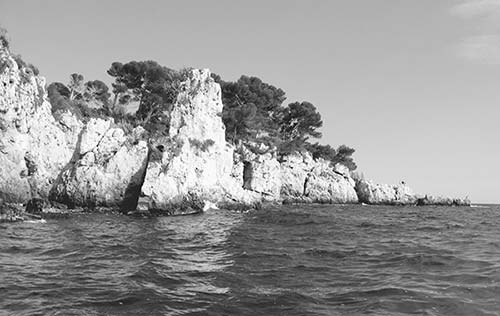
As you walk, you’ll have fancy fences with security cameras on one side and dramatic sea views on the other. The public space is rarely more than 50 yards wide and often extremely rocky—impassible if not for the paved trail carved out of it for the delight of hikers.
At a fast clip you can walk the entire circle in just over an hour. Don’t do the hike without the tourist map (available at hotels or the TI). You can do it in either direction (or in partial segments; see “Getting There,” next page). I’ve described the walk starting at its western end going counterclockwise.
From the La Fontaine bus stop walk five minutes down Avenue Mrs. L. D. Beaumont to the gate of the Villa Eilenroc. Enter through the gate to the trail skirting the villa on your left, and walk five more minutes to the rocky coastal trail. Now turn left and follow the trail for nearly an hour around Cap Gros. There’s no way to get lost without jumping into the sea or scaling villa security walls. You return to civilization at a tiny resort (Plage de la Garoupe), with an expensive restaurant, a fine beach (both public and private), and a fun and inexpensive beachside bar/café. From here it’s a 10-minute walk up Avenue André Sella to your starting point and the bus stop. With a car (or bike), you could start and end at Plage de la Garoupe. For a shorter version, walk from Plage de la Garoupe to Cap Gros and back.
Getting There: Drivers will find parking easier at the trail’s eastern end (Plage de la Garoupe), though some street parking is available a few blocks from the trail’s western end (look near Hôtel Beau-Site). Pedestrians should start at the trail’s western end. Take bus #2 from Antibes for about 15 minutes to the La Fontaine stop at Rond-Point A. Meiland (next to the recommended Hôtel Beau-Site), then follow the route described earlier.
Several sleepable options are available in the town center, but my favorite Antibes hotels are farther out and most convenient for drivers.
$$ Hôtel Mas Djoliba*** is a traditional manor house with chirping birds and a flower-filled moat. While convenient for drivers, it’s workable for walkers (10-minute walk to Plage de la Salis, 15 minutes to old Antibes). Bigger rooms are worth the additional cost, and several rooms come with small decks (several good family rooms, no elevator but just three floors, boules court and loaner balls; 29 Avenue de Provence—from Boulevard Albert I, look for gray signs two blocks before the sea, turn right onto Boulevard Général Maizière, and follow signs; tel. 04 93 34 02 48, www.hotel-djoliba.com, contact@hotel-djoliba.com, Delphine).
$$ Hôtel la Jabotte** is a cozy little hotel hidden along an ignored alley a block from the best beaches and a 20-minute walk from the old town. Run with panache by Nathalie, the hotel’s rich colors and decor show a personal touch. The immaculate rooms have smallish bathrooms and individual terraces facing a cute, central garden where you’ll get to know your neighbor (no TVs, free breakfast for Rick Steves readers, sauna, bikes, and a kayak available; 13 Avenue Max Maurey, take the third right after passing Hôtel Josse, tel. 04 93 61 45 89, www.jabotte.com, info@jabotte.com). The hotel will shuttle clients to the train station, hiking trails, restaurants, etc. in their small tuk-tuk vehicle for a small fee.
$$ Hôtel Beau-Site,*** my only listing on Cap d’Antibes, is a 10-minute drive from town. It’s a terrific value if you want to get away...but not too far away. (Without a car, you’ll feel isolated.) Helpful Nathalie and Francine welcome you with a pool, a comfy patio garden, and secure pay parking. Rooms are spacious and comfortable, and several have balconies (electric bikes available, 141 Boulevard Kennedy, tel. 04 93 61 53 43, www.hotelbeausite.net, contact@hotelbeausite.net). The hotel is a 10-minute walk from Plage de la Garoupe on the Cap d’Antibes loop hike (described earlier).
$ Bastide de la Brague is an easygoing bed-and-breakfast hacienda up a dirt road a 10-minute drive east of Antibes. The fun-loving family (wife Isabelle, who speaks English, and hubby Franck) rent seven rooms—the best rooms are upstairs; several are ideal for families, and breakfast is included (55 Avenue No. 6, tel. 04 93 65 73 78, www.labastidedelabrague.com, bastidebb06@gmail.com). Antibes bus #10 drops you five minutes away, and if arranged in advance, they can pick you up at the Biot or Antibes train station.
$$$ Hôtel la Place*** is central, pricey, and cozy. It overlooks the ugly bus station with tastefully designed rooms and a comfy lounge (no elevator, 1 Avenue 24 Août, tel. 04 97 21 03 11, www.la-place-hotel.com, contact@la-place-hotel.com).
$ Hôtel Relais du Postillon** is a mellow, central place above a peaceful café with 16 impeccable rooms at very fair rates. The furnishings are tasteful, and several rooms have small balconies or terraces (tiny elevator, pay parking, 8 Rue Championnet, tel. 04 93 34 20 77, www.relaisdupostillon.com, relais@relaisdupostillon.com).
$ Modern Hôtel,** in the pedestrian zone behind the city bus station, is suitable for budget-conscious travelers. The 17 standard-size rooms are simple and spick-and-span (no elevator, 1 Rue Fourmillière, tel. 04 92 90 59 05, www.modernhotel06.com, modern-hotel@wanadoo.fr).
Antibes is a fun and relaxed place to dine out. But there are precious few really good options in Antibes, and those get booked up on weekends in particular (when you’re smart to book a day ahead). All but one of my recommendations are within a few blocks of each other, so it’s easy to comparison shop.
Antibes’ Market Hall (Marché Provençal) has great ambience and is popular with budget-minded diners each evening after the market stalls close. It’s not haute cuisine, but prices are usually reasonable, and slurping mussels under a classic 19th-century canopy can make for a great memory. To start your soirée, consider a glass of wine from one of several wine bars that call the market hall home.
$$ Try Chez Lulu for an ultimate family-style dining adventure that seems utterly out of place on the Riviera. Diners fork over €27 and settle in, while charismatic owner Frank (who speaks flawless English), his wife Alice, and—when they’re busy—their granddaughter dish out charcuterie, salads, soups, a main course, and desserts to be shared. Tables seat 6-10, and the setting is warm and convivial. Don’t come for a romantic meal. You’ll be on a first-name basis with your neighbors, cut your own bread, and serve your own soup (fun!). Book a day ahead or arrive early (from 19:00, closed Sun-Mon, tel. 04 89 89 08 92, 5 Rue Frédéric Isnard).
$$$$ Larazur is the love child of a young couple who both worked as chefs at Michelin-starred restaurants and wanted a quieter life in the south. Lucas does the cooking while Jeanne runs the restaurant. The setting is relaxed yet elegant, and the attention to quality is obvious (book ahead, closed Mon-Tue, 8 Rue des Palmiers, tel. 04 93 34 75 60, www.larazur.fr).
$$ Le P’tit Cageot is a find. The chef makes delicious Mediterranean cuisine affordable. The place is tiny, just 25 seats inside and out, so book ahead (closed Wed and Sun, 5 Rue du Docteur Rostan, tel. 04 89 68 48 66).
$$ Le Zinc is a cool little wine-bar bistro at the upper end of the market hall serving a limited selection of tasty cuisine. Book ahead or arrive early for an outside table (closed Mon, 15 Cours Masséna, tel. 04 83 14 69 20).
$$$ Le Vauban is a traditional and dressy place with red-velvet chairs and serious service. It’s popular with locals for special events and its seafood (closed for lunch Mon and Wed, closed all day Tue, opposite 4 Rue Thuret, tel. 04 93 34 33 05, www.levauban.fr).
$$ Le Brulot, an institution in Antibes, is known for its Provençal cuisine and meat dishes (most cooked over an open fire). It’s a small, rustic place with tables crammed every which way (big, splittable portions, come early or book ahead, closed Sun, 2 Rue Frédéric Isnard, tel. 04 93 34 17 76, www.brulot.fr).
$$$ La Taille de Guêpe is family-run by Olivier in the kitchen and Katy in the relaxing garden-like dining room. The chef has worked for several years with flowers; the colorful varieties you find on your plate are all edible and add a twist to the fresh, fine, and light food. The moëlleux au chocolat is a perfect way to end your meal. Menus, enjoyed with cheap and good local wine, are a good deal (reservations recommended, closed Sun-Mon, 24 Rue de Fersen, tel. 04 93 74 03 58).
Picnic on the Beach or Ramparts: Romantics on a shoestring can find grocery stores open until late in Antibes and assemble their own picnic dinner to enjoy on the beach or ramparts. There’s a good Carrefour City market at 44 Rue de la République and a Monoprix on Place Général de Gaulle—both open late.
For a comparison of train and bus connections, see the “Public Transportation in the French Riviera” sidebar on here.
From Antibes by Train: TGV and local trains deliver great service to Antibes’ little station. Trains go to Cannes (2/hour, 15 minutes), Nice (2/hour, 20 minutes), Villefranche-sur-Mer (2/hour, 40 minutes), Monaco (2/hour, 50 minutes), and Marseille (hourly, 2.5 hours).
By Bus: All the buses listed below serve the Pôle d’Echange regional bus station (behind the train station). Handy bus #200 ties everything together from Cannes to Nice, but runs at a snail’s pace when traffic is bad. It goes west to Cannes (35 minutes) and east to Nice (1.5 hours). For bus details, including info on tickets, routes, frequencies, and travel times, see the “Getting Around the Riviera” section near the start of this chapter. Bus #250 runs to Nice Airport (2/hour, 40 minutes).
For a verdant, rocky, fresh escape from the beaches, head inland and upward. Some perfectly perched hill towns and splendid scenery hang overlooked in this region more famous for beaches and bikinis. Driving is the easiest way to get around, though Vence and St-Paul-de-Vence are well served by bus from Nice (see “Nice Connections,” on here). For a scenic inland train ride, take the narrow-gauge train from Nice into the Alps (see here).
This most famous of Riviera hill towns is also the most-visited village in France. I believe it. This incredibly situated village—with views to the sea and the Alps—is understandably popular. Every cobble and flower seems just so, and the setting is postcard-perfect. But it can also feel like an overrun and over-restored artist’s shopping mall. Avoid visiting between 11:00 and 18:00, particularly on weekends. Beat the crowds by skipping breakfast at your hotel to get here early, or come for dinner and experience the village at its tranquil best.

Tourist Information: The helpful TI, just through the gate into the old town on Rue Grande, has maps with minimal explanations of key buildings, and rental boules for pétanque on the square (daily 10:00-18:00, June-Sept until 19:00, closes for lunch on weekends, tel. 04 93 32 86 95, www.saint-pauldevence.com).
Arrival in St-Paul-de-Vence: Pay to park close to the village, or park for free along the road to Fondation Maeght (look for Parking Conseillé signs) and walk down to the village. Free parking is also available at the entry to Fondation Maeght (a 20-minute walk from town). Bus #400 (connecting Nice and Vence) stops on the main road, just above the village.
However you arrive, if the traffic-free lane leading into the old town is jammed, walk along the road that veers up and left just after Café de la Place, and enter the town through its side door.
St-Paul’s old town has no essential sights, though its perfectly cobbled lanes and peekaboo views delight most who come. You’ll pass two vintage eateries before piercing the walls of the old town. The recommended La Colombe d’Or is a good spot for a meal. Back when the town was teeming with artists, this historic hotel/restaurant served as their clubhouse. Its walls are covered with paintings by Picasso, Miró, Braque, Chagall, and others who traded their art for free meals. Café de la Place is a classic spot to have a coffee and croissant while watching waves of tourists crash into town (daily from 7:00). On the square, serious boules competitions take place. Find the cool boules sculpture there.
After entering the walls of St-Paul, meander deep to find its quieter streets and panoramic views. How many art galleries can this village support? Imagine the time it took to create the intricate stone patterns in the street you’re walking along. Visit Marc Chagall’s grave in the cemetery at the opposite end of town, a 10-minute walk keeping straight along the main drag (from the cemetery entrance, turn right, then left to find Chagall’s grave). Walk up the stairs to the view platform above the cemetery and try to locate the hill town of Vence at the foot of an impressive mountain. Is the sea out there somewhere?
This inviting, pricey, and far-out private museum is situated a steep walk or short drive above St-Paul-de-Vence. Fondation Maeght (fohn-dahs-yohn mahg) offers an excellent introduction to modern Mediterranean art by gathering many of the Riviera’s most famous artists under one roof. There are no English explanations for the interior displays.
Cost and Hours: €16, daily 10:00-18:00, July-Sept until 19:00, audioguide-€3 (covers primarily art in the gardens), great gift shop and cafeteria, tel. 04 93 32 81 63, www.fondation-maeght.com.
Getting There: The museum is a steep 20-minute uphill walk from St-Paul-de-Vence and the bus stop. Parking is usually available (and free) at the sight and in lower lots, signed Parking Conseillé.
Visiting the Museum: The founder, Aimé Maeght, long envisioned the perfect exhibition space for the artists he supported and befriended as an art dealer. He purchased this arid hilltop, planted 35,000 plants, and hired the Catalan architect José Luis Sert to enact his vision.

A sweeping lawn laced with amusing sculptures and bending pine trees greets visitors. On the right, a chapel designed by Georges Braque—in memory of the Maeghts’ young son, who died of leukemia—features a moving purple stained-glass work over the altar. The unusual museum building is purposely low profile to let its world-class modern art collection take center stage. Works by Fernand Léger, Joan Miró, Alexander Calder, Georges Braque, Marc Chagall, and many others are thoughtfully arranged in well-lit rooms (the permanent collection is sometimes replaced by special thematic shows). Outside, in the back, you’ll find a Gaudí-esque sculpture labyrinth by Miró and a courtyard filled with the wispy works of Alberto Giacometti—both designed by the artists for these spaces.
$$ Le Tilleul is a good place to dine well in St-Paul, either at inviting tables on the broad terrace or in its pleasant interior (daily, near the TI on Place du Tilleul, tel. 04 93 32 80 36, www.restaurant-letilleul.com).
Book well ahead for $$$$ La Colombe d’Or, a veritable institution in St-Paul where the menu hasn’t changed in 50 years (see description earlier). Dine on good-enough cuisine inside by the fire to best feel its pulse (closed Nov-Dec, tel. 04 93 32 80 02, www.la-colombe-dor.com; for reservations, email contact@la-colombe-dor.com).
Vence, an appealing town set high above the Riviera, sees a fraction of the crowds that you’ll find in St-Paul. While growth has sprawled beyond Vence’s old walls and cars jam its roundabouts, the traffic-free lanes of the old city are a delight, the mountains are front and center, and the breeze is fresh. Vence bubbles with workaday life—and ample tourist activity in the day—but it’s quiet at night, with far fewer visitors and cooler temperatures than along the coast. You’ll also find terrific choices for affordable hotels and restaurants. Vence makes a handy base for travelers wanting the best of both worlds: a hill-town refuge near the sea.
Tourist Information: Vence’s fully loaded and helpful TI is at the southwest corner of the main square, Place du Grand Jardin (in the Villa Alexandrine, Mon-Sat 9:00-19:00, Sun 10:00-18:00; Nov-March 10:00-17:00 and closed Sun, tel. 04 93 58 06 38, www.vence-tourisme.fr). Pick up the city map with a well-devised self-guided walking tour, a list of art galleries, bus schedules, or pétanque instructions, and ask about guided walking tours in English.
Arrival in Vence: Bus #94 (fastest bus from Nice, about an hour) or #400 (from Nice, Cagnes-sur-Mer, and St-Paul-de-Vence, just over an hour) drops you at the Ara bus stop just off the roundabout at Place Maréchal Juin, a 10-minute walk to the town center (along Avenue Henri Isnard or Avenue de la Résistance). If arriving by car, follow signs to cité historique and park in the underground Parking Grand Jardin, near the TI.
Helpful Hints: Market days are Tuesdays and Fridays until 13:00 on the Place du Grand Jardin and in the cité historique around Place Clemenceau. A big all-day antiques market is on Place du Grand Jardin every Wednesday. If you miss market day, a Monoprix supermarket is on Avenue de la Résistance, across from the entrance to the Marie Antoinette parking lot (grocery store upstairs, Mon-Sat 8:30-20:00, Sun 9:00-13:00). For a taxi, call 04 93 58 11 14.
This 17th-century mansion, adjoining an imposing 12th-century watchtower, bills itself as one of the Riviera’s high temples of modern art, with a rotating collection. Check with the TI to see what’s showing in the temple. The museum offers a loaner guide with English explanations of the collection.
Cost and Hours: €7, Tue-Sun 11:00-18:00, closed Mon, 2 Place du Frêne, tel. 04 93 58 15 78.
The chapel—a short drive or 20-minute walk from town—was designed by an elderly and ailing Henri Matisse as thanks to a Dominican nun who had taken care of him (he was 81 when the chapel was completed). While the chapel is the ultimate pilgrimage for his fans, the experience may underwhelm others. (Picasso thought it looked like a bathroom.) The chapel’s design may seem basic—white porcelain tiles, simple black designs, and floor-to-ceiling windows—but it’s a space of light and calm that only a master could have created.
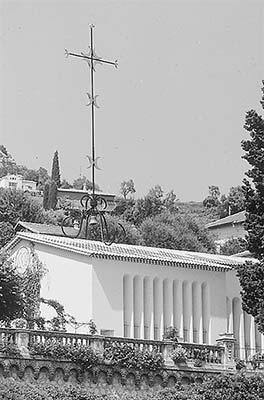
Cost and Hours: €7; Tue, Thu, and Fri 10:00-12:00 & 14:00-18:00, Wed and Sat 14:00-18:00 (Nov-March until 17:00), closed Sun-Mon and mid-Nov-mid-Dec, 466 Avenue Henri Matisse, tel. 04 93 58 03 26, www.chapellematisse.fr.

Getting There: On foot, it’s a 20-minute walk from Place du Grand Jardin. Walk down Avenue Henri Isnard all the way to the traffic circle. Turn right across the one-lane bridge on Avenue Henri Matisse, following signs to St-Jeannet. By car, follow signs toward St-Jeannet, cross the bridge, and start looking for parking—the chapel is about 400 yards after the bridge toward St-Jeannet.
Visiting the Chapel: The modest chapel holds a simple series of charcoal black-on-white tile sketches and uses three symbolic colors as accents: yellow (sunlight and the light of God), green (nature), and blue (the Mediterranean sky). Bright sunlight filters through the stained-glass windows and does a cheery dance across the sketches. Your entry ticket includes a 20-minute tour from one of the kind nuns who speak English. In the little museum, you’ll find pictures of the artist, displays of the vestments Matisse designed for the priests, his models of the chapel, and sketches. Outside, there’s a terrace with terrific views toward Vence.
These places tend to close their reception desks between 12:00 and 16:00. Make arrangements in advance if you plan to arrive during this time.
$$$ La Maison du Frêne, centrally located behind the TI, is a modern, art-packed B&B with four sumptuous suites. Energetic and art-crazy Thierry and Guy make fine hosts (RS%, includes good breakfast, kids under 12 free; next to the Château de Villeneuve at 1 Place du Frêne; tel. 04 93 24 37 83, www.lamaisondufrene.com, contact@lamaisondufrene.com).
$ Hôtel La Victoire is a solid value right on the main square next to the TI. Rooms are small but have all the comforts; it’s warmly run and well maintained by Pierre (elevator one floor up, 1 Place du Grand Jardin, tel. 04 93 24 15 54, www.hotel-victoire.com, contact@hotel-victoire.com).
$ Auberge des Seigneurs feels medieval. Located in a 17th-century building, it has six simple but spacious rooms over a well-respected restaurant (Wi-Fi in lobby, no air-con, no elevator, 1 Rue du Docteur Binet, tel. 04 93 58 04 24, http://auberge-seigneurs.fr, sandrine.rodi@wanadoo.fr).
$ The Frogs’ House is situated in the untouristed hill town of St-Jeannet, a 15-minute drive from Vence. (It’s so quiet, it’s hard to believe a Riviera beach is only 10 miles away.) Benôit and Corinne welcome travelers with a full menu of good rooms, cooking lessons, restaurant recommendations, hikes in the area, and day trips. If you don’t have wheels, they’ll pick you up at the train station or airport. Rooms are small but sharp (includes hearty breakfast, some rooms with balconies, family rooms, full-house rentals available in winter, mobile 06 28 06 80 28, www.thefrogshouse.fr, info@thefrogshouse.com). Park in the lot at the bottom of St-Jeannet, a few blocks from this small hotel.
Tempting outdoor eateries litter the old town. Lights embedded in the cobbles illuminate the way after dark. The restaurants I list have similar prices and quality, and all have outside dining options.
At $$ Les Agapes, Chef Jean-Philippe goes beyond the standard fare with lavish presentations, creative food combinations, and moderate (for the Riviera) prices. Try the sphere chocolat dessert to round out your meal (closed Mon year-round, closed Sun off-season, reservations smart, 4 Place Clemenceau, tel. 04 93 58 50 64, www.les-agapes.net).
$$ La Litote is a favorite, with outdoor tables on a quiet, hidden square, a cozy interior, and traditional cuisine (closed Sun year-round, closed Mon off-season, 7 Rue de l’Evêché, tel. 04 93 24 27 82).
$ Le Michel Ange is a sweet, kid-friendly place on an adorable square serving excellent-value cuisine from pizza to pasta, as well as tasty, well-presented plats du jour (closed Sun-Mon, 1 Place Godeau, tel. 04 93 58 32 56).
For inexpensive, casual dining, head to Place du Peyra, where you’ll find ample outdoor seating and early dinner service. At the basic $$ Bistro du Peyra, enjoy a relaxed dinner salad or pasta dish outdoors to the sound of the town’s main fountain (closed Mon-Tue off-season, 13 Place du Peyra, tel. 04 93 58 67 63).